

Project Management Methodology: Definition, Types, Examples
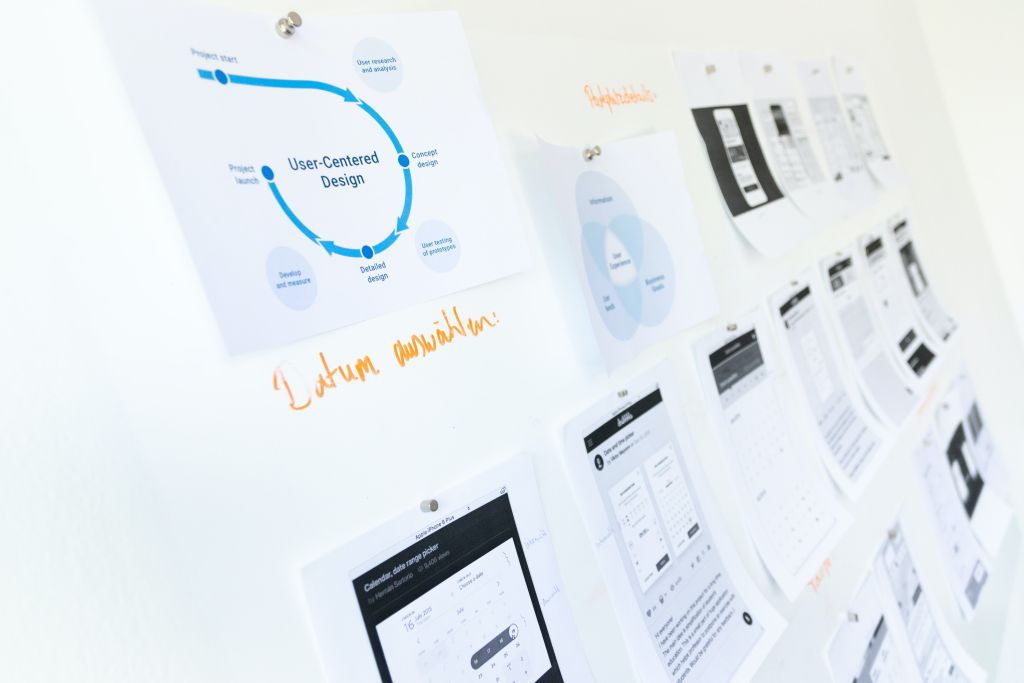
What is a project management methodology ? How can it be defined? In simple terms, it is a must-have to avoid failure and reduce risks because it is one of the critical success factors as well as the core competency of the management team. It is the straightforward way to guide the team through the development and execution of the phases, processes and tasks throughout the project management life-cycle.
What is a Methodology? The Definition in Project Management
The term “ project management methodology ” was first defined in the early 1960s when various business organizations began to look for effective ways that could simplify the realization of business benefits and organize the work into a structured and unique entity (which was called “ project ” later on). Communication and collaboration were the key criteria for establishing productive work relationships between the teams and departments within one and the same organization.
Since that time, the term has been changed and modified many times, new definitions have been created, new elements and functions have been added. Today we consider a project management methodology as a set of broad principles and rules to manage a specific project that has a definite beginning and end. Below is the current definition of methodology .
Project Management Methodology is a strictly defined combination of logically related practices, methods and processes that determine how best to plan, develop, control and deliver a project throughout the continuous implementation process until successful completion and termination. It is a scientifically-proven, systematic and disciplined approach to project design, execution and completion.
The purpose of project methodology is to allow for controlling the entire management process through effective decision making and problem solving, while ensuring the success of specific processes, approaches, techniques, methods and technologies.
Typically, a project management methodology provides a skeleton for describing every step in depth, so that the project manager or program manager will know what to do in order to deliver and implement the work according to the schedule, budget and client specification.
Referring to the above mentioned definition, an appropriately chosen project management methodology paves the way for gaining the following achievements:
- The needs of stakeholders are defined
- A common “language” is established and understood by the team, so they know what’s expected of them
- Cost estimates are complete, accurate and credible
- Every task is done using a common methodological approach
- Most conflicts are spotted and resolved early
- Expected deliverables are produced and handed over
- Lessons are learned and solutions are quickly implemented
Methodology in Project Management Framework
Project management (the acronym “PM”) provides the framework of planning, doing and delivering projects of any kind, size, nature and type. PM framework focuses on the realization of desired change in line with a chosen methodological approach. Actually, change is the core aspect that should be managed. PM framework identifies and defines how to best manage change. And methodology serves as the “way” to systematically realize change in terms of time, cost and quality.
Managing projects means describing and performing the activities required to meet the specific objectives of making change.
For example, writing a book is a kind of project in which the objective is to write a book. This objective can be fulfilled by a series of activities, including defining the topic, collecting material, creating a draft, typing, proofreading, others. So in terms of project management, the author needs to define and then complete all the necessary activities in order to write a book (which means make change).
Here’s a simplified example of how a project methodology can be presented in the management hierarchical structure:
PM Framework precedes Methodology which in turn precedes Lifecycle Stages and determines the project management Processes, Tasks and Activities
Project Management Methodology Types
In project management there are a variety of approaches and methods that can be employed in managing different kinds of project. All the types of project methodology can be conditionally divided into traditional and modern approaches.
Traditional Approach
A traditional approach involves a series of consecutive stages in the project management process. It is a step-by-step sequence to design, develop and deliver a product or service. It entails achieving the succession in the implementation process and provides the benefits of milestone-based planning and team building. In IT and software development, this methodology type is called “ Waterfall ” – one portion of work follows after another in linear sequence.
The following stages are included the traditional project management methodology:
- Initiation (requirements specification)
- Planning and design
- Execution (construction and coding)
- Control and integration
- Validation (testing and debugging)
- Closure (installation and maintenance)
Modern Approaches
Modern methodologies do not focus on linear processes but they provide an alternative look at project management. Some of the methods are best for IT and software development, while others can be implemented in production, process improvement, product engineering, and so on. Modern PM approaches use different models of the management process.
Project Management Methodology Examples
It is the matter of a project’s type, size and nature to select the right methodology. Here are the most popular PM methodologies:
PMBOK® Guide
Although A Guide to the Project Management Body of Knowledge IS NOT a PM methodology in its “ pure state “, many people regard it as the methodological approach to planning, executing, controlling and terminating various projects. Meanwhile, the PMBOK® Guide is a broad inventory of best practices and ideas on planning and implementing projects. Please note that it is just a guide but not a project management methodology.
PRojects IN Controlled Environments 2 ( PRINCE2 ) presents a suite of process-driven methods and documentation-oriented approaches that allow driving various projects in the private sector. It was developed the UK Government, and today this great example of project management methodology is used both in the UK and internationally.
Critical path method (CPM) explores the most important or critical tasks of a project by defining possible activity sequences and estimating the longest duration of each sequence. It helps figure out how long it will take to complete the work and what tasks will compose the scope.
Lean PM methodology intends to maximize customer value and minimize resource waste. Lean project management lets organizations create higher value for their customers with fewer resources. This approach achieves perfection in customer satisfaction and value generation through implementing an optimized process flow that eliminates waste in products, services, transportation, inventories, etc.
The method of Six Sigma was originally developed by Motorola to improve its production processes by eliminating defects (defined as “non-conformity of a product or service to its specifications”). Today Six Sigma is one of the most popular and worldwide trusted examples of project management methodology for ensuring the accuracy and speed of a process’s implementation through eliminating or minimizing waste.
Critical Chain Project Management (CCPM) is the way to plan, implement and review various kinds of work in single- and multi-project environments. This management methodology uses Theory of Constraints (TOC) and the concept of buffers to establish improved task durations and manage resource-dependent tasks and activities.
SCRUM is an example of Agile PM methodology that involves teams in producing a software product in 30-day “ sprints ” and monthly “ scrum sessions “. In a SCRUM-driven project, the deliverables are broken down into 30-day intervals. This methodology example is specific and applicable mainly to collaborative, 100%-dedicated teams, with no heavily constrained time and materials budget.
Project Management for Students
Project management for students is a vital part of the education and training process. Students can easily get a project management degree, but it does not mean that it comes as easy as taking the homework. Students need to take into account some important aspects if they want to manage a project properly.
For instance, choosing the best admission essay writing service is of great importance because if for some reason the student cannot deliver a high-quality essay in time, he will most likely fail the course or even worse he will be expelled from the college or university.
Students should prepare well for the project or the essay. They need to research on the topic beforehand, keep track of what is going on, write on time and work within the deadline.
This will allow them to catch up with their fellow students, focusing only on what they have to do and not worrying about what other people are doing.
Worth Reading

The Rise of Coworking Spaces in Today’s New Work Era
March 2, 2023
Top 5 Considerations for Effective Project HR Management
March 13, 2013

Basic Tips on Project Team Planning
January 12, 2011

Top Challenges of Translation in Business
February 17, 2021

What Does a Successful Project in Business Look Like?
October 12, 2023
#ezw_tco-3 .ez-toc-title{ font-size: 120%; ; ; } #ezw_tco-3 .ez-toc-widget-container ul.ez-toc-list li.active{ background-color: #ededed; } Table of Contents Toggle

Career & Lifestyle
How Do I Write My Papers On Technology And Always Get A’s?

Harness the Potential of Free Email Marketing Software in 2024

Project initiation stage – Project Initiation Document (PID). Duties of project owner and project team

Organizing Procurement and Purchasing Activities in a Project

Two Common Mistakes in Project Procurement Contracts

Project Sponsor – The Role and Responsibilities
Limited time offer
Total with VAT: {{CartWithDetails.cartMaster.total_after_vat}} {{currency}}
Your cart is empty.

12 Project Management Methodologies: Types, Tools, Techniques, And How to Choose
Written By : Bakkah
27 Feb 2024
Table of Content
Definition of Project Management Methodologies:
Types of project management methodologies, project management methodologies tools , project management methodologies techniques, how to choose a project management methodology, explore bakkah's leading courses to boost your skills in project management and business analysis:, popular articles.
PRINCE2 Methodology - 2024 Full Guide About Advantages and Disadvantages
Prosci Methodology - Change Management Methodology
Application of PMO in government entities in Saudi Arabia
Project management methodologies are systematic frameworks and guidelines utilized by organizations to efficiently plan, execute, and complete projects. They offer structured approaches to project management, ensuring adherence to timelines, budgets, and objectives. These methodologies encompass diverse principles, practices, and tools designed to facilitate effective communication and coordination among project-implementing teams.
Project management methodologies vary in their approach, with some emphasizing flexibility and adaptability (e.g., Agile) while others focus on sequential and structured processes (e.g., Waterfall). The appropriate methodology must be selected according to the type of project and its unique circumstances. The goal is to enhance project efficiency, minimize risks, and deliver high-quality results, ultimately contributing to achieving the specified goals and objectives of the project.
Project management methodologies refer to the systematic frameworks, processes, and guidelines organizations follow to plan, execute, monitor, and complete projects. These methodologies provide a structured approach to managing projects, ensuring they are completed on time, within budget, and meet the specified goals and objectives.
Project management methodologies encompass diverse principles, practices, and tools designed to facilitate effective communication and coordination among project-implementing teams.
They can vary in their approach, with some methodologies emphasizing flexibility and adaptability (e.g., Agile), while others focus on sequential and structured processes (e.g., Waterfall). The appropriate methodology must be selected according to the type of project and its unique circumstances.
The goal of Project Management Methodologies is to enhance project efficiency, minimize risks, and deliver high-quality results, ultimately contributing to achieving the specified goals and objectives of the project.
Various tools support their implementation, enhancing collaboration and communication, while diverse techniques facilitate effective project planning, execution, and control.
There are diverse project management methodologies, each with different principles, processes, and approaches. Here are some common types:
1. Waterfall Methodology
Waterfall project management is a traditional approach to project management where tasks are completed sequentially and linearly.
The methodology is called "waterfall" because progress is seen as flowing steadily downwards through phases, like a waterfall. Each phase must be completed before moving on to the next one, and changes to the project are generally not allowed once a phase is closed.
Here are the main phases in the waterfall project management methodology:
- Requirements: Define project scope, objectives, and deliverables.
- Design: Create a detailed plan for how the solution meets requirements.
- Implementation (or Construction): Include coding or construction of the project.
- Testing: Ensure the project meets specified requirements through various testing phases.
- Deployment (or Implementation): Implement the project in the production environment after the success of testing.
- Maintenance and Support: Address issues and user concerns and make updates as needed.
The waterfall methodology is best suited for projects where the requirements are well-understood and unlikely to change significantly during the development process.
It is often used in industries like construction and manufacturing. However, one of its main drawbacks is its inflexibility to adapt to changes once the project has started, as it does not easily accommodate changes in requirements.
2. Agile Methodology
Agile methodology is an iterative and flexible approach to project management that focuses on collaboration, adaptability, and customer satisfaction.
Unlike the linear nature of the waterfall model, agile divides a project into small increments with minimal planning and delivers functional pieces of the project in short time frames, known as iterations or sprints.
Primary principles and practices of agile include:
- Projects are divided into small manageable iterations, delivering potentially shippable product increments.
- Collaboration and communication between team members, stakeholders, and customers are crucial for quick adaptation to changes and alignment with goals.
- Continuous customer feedback allows for adjustments based on changing requirements.
- Agile is flexible and adaptable to changes in requirements or priorities at any stage.
- Continuous delivery aims for a potentially shippable product at the end of each iteration, allowing for early and regular value delivery to the customer.
- Prioritization and timeboxing based on value and importance ensure focus and urgency in delivering value.
- Agile encourages self-organizing, cross-functional team formation that collectively possess the necessary skills to deliver a complete product.
Popular agile frameworks include Scrum, Kanban, and Extreme Programming (XP), each with specific practices and roles.
Agile is widely used in software development and various industries for its adaptability and customer-centric approach.
3. Scrum Framework
Scrum is one of the most widely used agile frameworks for managing complex software development projects. It provides a structured yet flexible approach to product development.
Key elements of the Scrum framework include:
- Roles: Include Product Owner, Scrum Master, and Development Team.
- Artifacts: Comprise the Product Backlog, Sprint Backlog, and Increment.
- Events: Include Sprint Planning, Daily Stand-up, Sprint Review, and Sprint Retrospective.
Scrum's iterative and incremental approach, along with its emphasis on collaboration and adaptability, makes it particularly effective for projects where requirements may change or evolve during development.
4. Kanban Methodology
Kanban is a project management methodology that visualizes workflow using boards, cards, and columns. It also limits tasks that are in progress simultaneously to prevent overloading the team and ensure a steady flow of work.
Emphasizing continuous improvement, Kanban employs feedback loops and a pull system, adapting work based on demand. Service Level Agreements (SLAs) are often used in Kanban to define the expected time frames.
Known for flexibility and adaptability, Kanban suits various industries like architecture, construction, marketing, education, software development, design, and law. Kanban fosters collaboration and shared responsibility and allows incremental process improvements based on specific needs and context.
5. Lean Project Management
Lean Project Management (LPM) is an approach to project management that draws inspiration from Lean principles. The Lean philosophy focuses on minimizing waste, optimizing efficiency, and continuously improving processes.
Lean principles are applied to enhance project delivery, reduce unnecessary activities, and deliver value more effectively.
Principal aspects of Lean Project Management methodology include eliminating waste, using value stream mapping, continuous improvement (Kaizen), customer focus, pull scheduling, visual management, batch size reduction, flexible planning, and cross-functional team use. LPM is suitable for industries like manufacturing, construction, and software development.
Its focus on efficiency and customer value makes it a valuable approach for organizations seeking to optimize their project delivery processes.
6. PRINCE2 (Projects IN Controlled Environments)
PRINCE2 (Projects IN Controlled Environments) is a widely adopted project management methodology developed by the UK government. It provides a structured and process-driven approach to project management, emphasizing flexibility and adaptability.
PRINCE2 divides projects into manageable stages, with defined roles and responsibilities, ensuring organized and controlled project execution.
The methodology consists of seven processes:
- Starting Up a Project (SU): Ensures project prerequisites are in place.
- Initiating a Project (IP): Defines project scope, objectives, and plans.
- Directing a Project (DP): Provides senior management with chief controls.
- Controlling a Stage (CS): Manages day-to-day project activities.
- Managing Product Delivery (MP): Ensures efficient product work.
- Managing a Stage Boundary (SB): Focuses on transitioning between stages.
- Closing a Project (CP): Formally closes the project and ties up loose ends.
PRINCE2 is known for its focus on continuous improvement and adaptability, making it a valuable tool for delivering successful projects within time, cost, and quality constraints.
Boost your career with Bakkah’s PRINCE2 courses:
- PRINCE2® Training Course Online
- PRINCE2® Agile Foundation & Practitioner Online Course and Certification
7. Critical Path Method (CPM)
Critical Path Method (CPM) is a project management technique that identifies the critical path of activities, potential risks, team roles, and the sequence of tasks determining the shortest project duration. Key steps:
- Task Breakdown: Identify and sequence project tasks.
- Duration Estimation: Assign time estimates to tasks.
- Network Diagram: Create a visual representation of task dependencies.
- Critical Path Identification: Find the path critical for project completion.
- Float/Slack Calculation: Determine non-critical task flexibility.
- Resource Allocation: Efficiently allocate resources.
- Monitoring and Control: Monitor progress continuously, update schedules, and take corrective actions., update schedules, and take corrective actions.
CPM is an essential tool for effective project planning and control. It aids in prioritizing critical tasks, managing time constraints, and optimizing project schedules. CMP can be used in several projects, such as engineering, manufacturing, construction, and science.
8. Six Sigma ( Continuous Improvement Methodology)
Six Sigma is a data-driven project management methodology focused on improving process efficiency continuously and reducing defects or errors. Developed by Motorola in the 1980s, Six Sigma seeks to minimize variations and achieve higher levels of quality in processes. It is often applied in manufacturing and process improvement projects. Here is a concise overview of the Six Sigma project management methodology:
- Define (D): Clearly articulate the problem, project goals, scope, and customer requirements.
- Measure (M): Establish metrics, collect data, and measure baseline performance.
- Analyze (A): Use statistical tools to identify root causes of defects or inefficiencies.
- Improve (I): Develop and implement solutions, testing and refining as needed.
- Control (C): Establish measures to sustain improvements and prevent recurrence of defects or issues.
The Six Sigma methodology is often represented by the acronym DMAIC (Define, Measure, Analyze, Improve, Control). Additionally, for more complex or considerable process changes, there is another phase known as DMADV (Define, Measure, Analyze, Design, Verify).
Bakkah provides certification levels such as Six Sigma Green Belt and Six Sigma Black Belt are available for individuals to demonstrate proficiency in applying Six Sigma principles and methodologies. Organizations implementing Six Sigma often experience enhanced efficiency, reduced defects, and improved customer satisfaction.
9. RAD (Rapid Application Development)
Rapid Application Development (RAD) is a project development methodology that prioritizes quick iterations and prototypes over extensive planning.
It involves user participation throughout the process, parallel development of system components, and a flexible, adaptive approach. Prototyping is a key feature, allowing for continuous refinement based on user feedback. RAD aims to deliver a functional product rapidly, focusing on time and cost efficiency.
Popular RAD tools include Microsoft Visual Basic, PowerBuilder, and OutSystems. The methodology suits projects with changing requirements but may not be ideal for highly structured endeavors.
10. Incremental and Iterative Methodologies
Incremental development involves dividing the project into small increments, each delivering a part of the final product's functionality linearly. User feedback is integrated after each increment, providing ongoing adaptability and the ability to identify and correct issues early. This approach enables early delivery and reduced project risk.
On the other hand, iterative development goes through cycles or iterations, refining the entire system with each iteration. It is highly flexible and accommodates changing requirements throughout the development process.
11. Hybrid Methodologies
Hybrid methodologies in project development involve blending elements from different traditional and agile approaches to create a flexible and tailored solution. That allows teams to adapt practices based on the project's unique requirements, leveraging both structured planning and iterative development.
In a hybrid methodology, the most appropriate elements from each methodology are identified and combined harmoniously. Examples include combining Waterfall and Scrum or integrating lean principles with agile practices.
The goal is to manage risks effectively, enhance flexibility, and address the project-specific needs. Effective communication is crucial to mitigate potential challenges introduced by diverse practices integration.
12. Extreme Programming (XP)
XP is an Agile methodology that emphasizes collaboration, adaptability, and delivering high-quality software through practices such as continuous testing and frequent releases.
Extreme Programming methodology is one of the famous methodologies for managing and developing software and other technical projects. It is based on diverse principles and practices, focusing on increasing software quality and improving team productivity.
A team needs to follow this method if the project is fast-paced or subject to regular change and thus has a dynamic rather than static nature.
The Extreme methodology also aims to achieve productive cooperation between team members and increase the quality of the final product and its flexibility in the face of changes.
Here are the main principles and practices of Extreme Programming:
- XP is built on a set of core values, including communication, simplicity, feedback, and courage.
- Developers work in pairs, one writing code and the other reviewing it in real time. That promotes collaboration, knowledge sharing, and code quality.
- Developers write tests before writing the actual code. That ensures that the code meets specifications and facilitates maintenance and updates.
- Code is integrated frequently to identify and address integration issues early in the development process.
- XP improves code design regularly without changing its functionality.
- XP keeps the design as simple as possible, making it easier to understand, modify, and maintain.
- Frequent and direct interaction with the customer allows for quick adjustments to changing requirements and priorities.
- XP emphasizes continuous improvement through regular reflection on the development process and changes in implementation to enhance efficiency and quality.
Bakkah provides a variety of accredited project management Courses for all professional certificates in project management, risk management, and others.
In brief, choosing the most suitable project management methodology depends on factors such as project size, complexity, industry, and organizational culture. Project managers often customize or combine methodologies to best fit the unique requirements of their projects.
Project management methodologies are often supported and implemented using various tools to enhance efficiency, collaboration, and communication throughout the project lifecycle. Here are some commonly used tools associated with project management methodologies:
1. Project Management Software
Tools like Microsoft Project, Asana, Jira, Trello, and Monday.com provide features for project planning, scheduling, task assignment, and progress tracking.
2. Version Control Systems
Git, SVN (Subversion), and Mercurial help manage changes to source code and documentation, ensuring version control and collaboration in software development projects.
3. Communication and Collaboration Tools
Slack, Microsoft Teams, and Discord facilitate real-time communication, file sharing, and collaboration among team members, supporting Agile and remote work environments.
4. Gantt Charts
Tools like GanttPRO and SmartDraw help create visual representations of project timelines, tasks, and dependencies, commonly used in Waterfall and traditional project management methodologies.
5. Kanban Boards
Trello, KanbanFlow, and LeanKit enable teams to visualize work and optimize workflow, particularly in Agile and Lean methodologies.
6. Scrum Tools
Jira, VersionOne, and Targetprocess support the Scrum framework with features for sprint planning, backlog management, and burndown charts.
7. Resource Management Tools
Workfront, Mavenlink, and TeamGantt assist in resource allocation, workload tracking, and managing team capacity in project management.
8. Risk Management Tools
RiskWatch, RiskyProject, and ProjectManager.com help identify, assess, and manage risks throughout the project lifecycle.
9. Collaborative Document Management
Tools like SharePoint, Google Workspace, and Dropbox Business enable teams to collaborate on documents, share project-related files, and ensure version control.
10. Continuous Integration and Deployment (CI/CD) Tools
Jenkins, Travis CI, and GitLab CI/CD automate integration code changes process and deploying software, commonly used in Agile and DevOps methodologies.
11. Time Tracking and Timesheet Tools
Harvest, Toggl, and Clockify assist in tracking project-related activities, allowing for accurate time management and resource allocation.
12. Customer Relationship Management (CRM) Tools
Salesforce, HubSpot, and Zoho CRM support customer-centric projects. That helps teams manage client interactions, feedback, and requirements.
Project managers and teams should carefully select tools that align with their chosen methodologies and project requirements. Integrating these tools can significantly improve project management efficiency and contribute to successful project outcomes.
Project management methodologies involve various techniques to plan, execute, and control projects effectively. Here are some commonly used techniques associated with project management methodologies:
1. Work Breakdown Structure (WBS)
Break a project into smaller, manageable tasks and create a hierarchical structure to define clearly the scope and deliverables.
2. PERT (Program Evaluation and Review Technique) and CPM (Critical Path Method)
Techniques for scheduling and managing tasks by identifying critical paths and dependencies and estimating project duration.
2. SWOT Analysis
Evaluate the project's Strengths, Weaknesses, Opportunities, and Threats to make informed decisions and develop effective strategies.
3. Risk Management
Identify, assess, mitigate, and monitor risks throughout the project lifecycle to minimize potential negative impacts.
4. Stakeholder Analysis
Identify and analyze stakeholders to understand their interests, influence, and expectations and ensure effective communication and engagement.
5. PERT Charts (Program Evaluation and Review Technique)
Graphical representations of project tasks and their dependencies, helping visualize the project schedule and critical path.
6. Scrum Meetings
Daily Standups, Sprint Planning, Sprint Review, and Sprint Retrospective are regular Scrum meetings that facilitate communication and collaboration in Agile projects.
7. Earned Value Management (EVM)
Analyze project performance by measuring the planned value, earned value, and actual cost to assess progress and forecast future performance.
8. Quality Management
Implement techniques such as quality audits, inspections, and control charts to ensure project deliverables meet predefined quality standards.
9. Mind Mapping
Visualize project ideas, requirements, and tasks using mind maps to stimulate creative thinking and organize information in a structured way.
10. Critical Chain Method
Identify and manage resource dependencies to optimize project schedules and improve overall performance.
11. Prototyping
Creating a working model or prototype of a product or system to gather feedback early in the development process is common in Agile and iterative methodologies.
12. Benchmarking
Compare project performance metrics and processes against industry standards or best practices to identify areas for improvement.
13. Dependency Mapping
Identify and visualize dependencies between different tasks or project activities to understand their interrelationships and potential impacts.
14. Agile Estimation Techniques
Use techniques like Planning Poker, Relative Sizing, and Story Points to estimate the effort required for Agile project tasks.
15. Change Management
Implement strategies and techniques to manage and communicate changes effectively, ensuring minimal disruptions to project progress.
16. Communication Plans
Developing plans outlines how project information will be communicated to stakeholders, ensuring clear and consistent communication.
These techniques are often applied based on the specific requirements, characteristics, and principles of the chosen project management methodology. Project managers may tailor and combine these techniques to suit the needs of their projects.
Choosing a suitable project management methodology is crucial for the success of a project. The decision should be based on the project's characteristics, team dynamics, organizational culture, and the nature of the work to be performed. Here is a step-by-step guide on how to choose a project management methodology:
1. Understand Project Requirements
Clearly define the project scope, objectives, and deliverables. Consider the size, complexity, and nature of the project work.
2. Assess Team Skills and Experience
Evaluate the skills and experience of the project team. Consider their familiarity with different methodologies and their adaptability to new approaches.
3. Consider Project Flexibility
Assess the level of flexibility required throughout the project. Some projects may benefit from a more adaptive and iterative approach, while others may require a more structured and sequential process.
4. Examine Project Constraints
Identify any constraints such as budget limitations, time constraints, regulatory requirements, or client preferences that may influence the choice of methodology.
5. Evaluate Organizational Culture
Consider the existing organizational culture and whether it aligns with the principles of certain project management methodologies. Some organizations may prefer traditional, plan-driven approaches, while others may be more receptive to Agile or iterative methods.
6. Define Stakeholder Involvement
Determine the level of involvement and collaboration required from project stakeholders. Some methodologies, like Agile, emphasize continuous stakeholder engagement and feedback.
7. Analyze Project Risks
Evaluate the potential risks associated with the project. Some methodologies, such as Agile, are well-suited for projects with high uncertainty and evolving requirements.
8. Review Industry Standards
Consider industry standards and best practices. Certain industries or project types may have specific guidelines or regulations that align with particular methodologies.
9. Explore Hybrid Approaches
Assess the possibility of combining elements from different methodologies to create a hybrid approach tailored to the project's specific needs.
10. Pilot or Prototype
If feasible, consider running a pilot or prototype using a small-scale version of the project to test how well a methodology fits the team and project requirements.
11. Consult with Stakeholders
Seek input from key stakeholders, including team members, clients, and sponsors. Understand their preferences, expectations, and concerns regarding project management approaches.
12. Training and Transition Plan
Evaluate the readiness of the team to adopt a new methodology. Plan for necessary training and establish a transition plan to smoothly implement the chosen methodology.
13. Continuous Improvement
Be open to evaluating and adjusting the chosen methodology throughout the project. Continuous improvement is essential to address evolving project needs and improve overall project management processes.
Elevate your project management skills with Bakkah Learning's expert-led courses. From PMP to Prince2, Six Sigma to Agile, we offer tailored programs to suit your career goals. With interactive learning, flexible access, and certification preparation, we're your partner for professional growth. Start your journey to mastery today with Bakkah Learning!
Here are some Project Management Courses :
- Certified Associate in Project Management CAPM Course
- PMI-ACP® certification
- PgMP certification
- PMI Scheduling Professional - PMI-SP certification
Risk Management Courses And Certifications:
- Risk Management Professional - PMI-RMP Course
- MoR Certification and course
PRINCE2 Courses
- PRINCE2 Certification
- PRINCE2 Agile.
Project Management Tools:
- Primavera P6 Course
- MSP Course - Managing Successful Programmes
- Microsoft Project training course
Portfolio Management
- P3O Foundation certification
- Management of Portfolios MoP
- The Portfolio Management Professional – PfMP certificate
- Lean Six Sigma Yellow Belt Course
- Lean Six Sigma Green Belt Course
- Lean Six Sigma Black Belt Course
Ultimately, the choice of a project management methodology should be a thoughtful and informed decision that aligns with the unique characteristics of the project and the organization. Regularly reassess the chosen methodology to ensure its continued effectiveness and make adjustments as needed.
Related Courses
Our learning programs are delivered through a tested and professionally designed methodology.

2,477.5 SAR
Exam is included
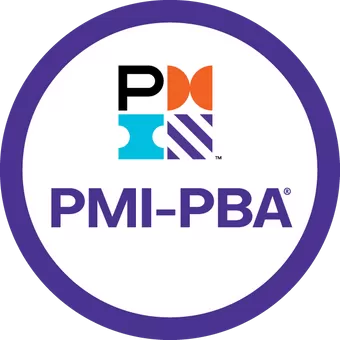
2,158.75 SAR
Live Online
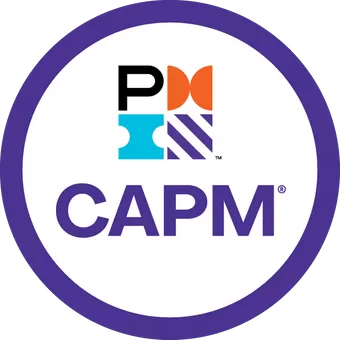
1,345.5 SAR
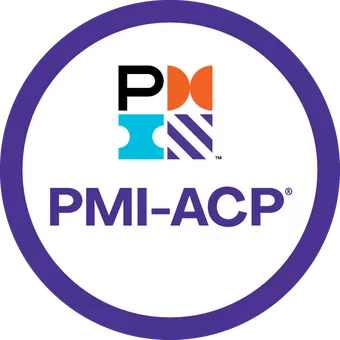
2,753.1 SAR
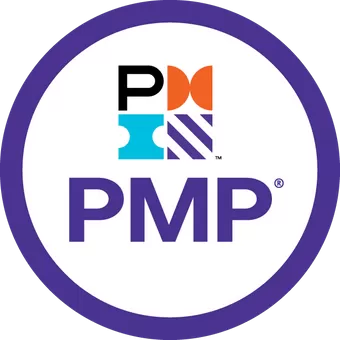
2,872.13 SAR
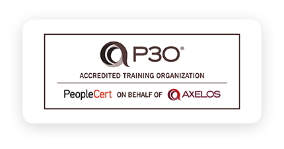
3,785.8 SAR

Your experience on this site will be improved by allowing cookies.
Added to Cart
{{ convertjson(lastcartitem.course.title) }}, features with this course, total with vat, {{ parsefloat(totalfeatures(lastcartitem)) }} {{currency}}.

- Jira Service Management
- Atlassian Guard
- Company News
- Continuous Delivery
- Inside Atlassian
- IT Service Management
- Work Management
- Project Management

6 popular project management methodologies and what they’re best suited for
You’re a project manager who has just been tasked with managing two very different, yet intertwined projects. It’s up to you to choose the best project management methodology for each project.
One project is with your development team. They need to overhaul your organization’s website to improve the clunky and somewhat confusing user experience—from the moment that a customer lands on the site to after they make a purchase. The development team is super flexible and open to breaking up into smaller teams in order to tackle specific aspects of the website overhaul faster.
The catch with this project? It’s on a time crunch.
The website has to be overhauled before the launch of your second and longer-term project: a large-scale marketing campaign around a new line of products that are launching next quarter.
First of all, you can do this! Breath in, breath out, read on, choose the best project management methodology for each task, and get to work doing what you do best!
How To Choose The Best Project Management Methodology
No two projects are alike.
Some may remind you of a past project (that you absolutely nailed, by the way!) but there’s always a catch, isn’t there? One project may have unlimited budgets, endless resources, and flexible timelines—a walk in the park for you—, while another may have high stakeholder expectations, limited budget, tight timelines, multiple teams, and dozens of dependencies.
Since every project is so different, there are many project management methodologies to choose from that support the various project and team needs. There are so many methodologies, in fact, that new ones may have emerged while you’re reading this!
What Is A Project Management Methodology?
Glad you asked. Methodologies are the systems (or simply, methods) used to do something.
The Project Management Institute defined it as “a system of practices, techniques, procedures, and rules used by those who work in a discipline.”
Choosing the right methodology , as well as project management tools and teams, will set you up for success before your project kicks off. For example, you wouldn’t pick a fast-paced, quick iteration project management methodology for a long-term, large-scale, inflexible, and stakeholder-heavy project. Pair like projects with like systems.
To do that, let’s look at your project factors or considerations, such as constraints and dependents.
What Project Factors Are You Working With?
As mentioned earlier, there are many considerations at play that make each project unique. Some factors to consider what you’re evaluating your project management methodologies include:
- Project budget: How much money is going to be spent on this project? How is it divided up?
- Timeline: When is your project due by?
- Goals: What are the project’s end goals and deliverables? Start there and work backward.
- Values: How do your organizational goals and values apply to this project? Knowing this will help set expectations (and help you hold team members accountable for their commitments ).
- Complexity and Scale: How complex or simple is this project?
- Flexibility: How flexible or rigid is this project and its end goals, timelines, deliverables, and team or stakeholder expectations?
- Project type and industry: Some methodologies work best for certain industries and project types, such as highly creative projects or product development sprints.
- Team: Consider the team size, diversity, flexibility, experience, and individual expertise or strengths and weaknesses, as well as their ability to collaborate and communicate when choosing a methodology.
6 Popular Project Management Methodologies And What They’re Best Suited For
It’s important to learn the similarities and differences of various methodologies available to you. For example, some project management methodologies work best if the end goal is fixed and clear, such as the Waterfall method, whereas others better suit those projects that aren’t, such as Agile and Scrum. Keep your project factors in mind while you read on—and then choose the best method for your team.
Let’s get to the methodologies.
1. Agile: Flexible, Fast, And Short Collaborative Sprint Projects
More than a methodology, agile is a set of principles that would be ideal to follow for your first (hypothetical) project.
Agile is made up of fundamental values that are ideal for small teams to work in short and fast project cycles or sprints without blockers. Blockers include too much documentation, work in progress, meetings, or processes to slow them down. The working team would need to be protected from these blockers so that they can stay focused on the tasks at hand.
Teams who work well together can collaborate on small tasks and adapt and respond to an ever-changing task list. Because agile is an iterative design and build process, teams must be flexible with the outcomes and the path they take to get there.
2. Scrum: Quick And Continuous Development Projects
If agile is a set of principles that teams follow to work quickly and respond adaptively to changes as they arise, then Scrum is a project management methodology and the most popular and simple framework that puts agile principles to use.
Scrum is an ideal methodology for your project with the development team to overhaul the website. It’s ideal for continuous improvement and rolling task lists. Something like improving the customer journey on a website may have a timeline, but will always have room for improvement—especially as customer expectations and the digital space change so quickly.
The goal of Scrum is to develop, build, deliver, and sustain complex products using small collaborative and highly accountable teams and iterative task lists. There are roles, events, and artifacts. Roles include a product owner, development team, and scrum master, while events include sprints, daily scrums, or standup meetings, and artifacts include product and sprint backlogs.
3. Kanban: Visualize Task Progress For Agile Teams
Like Scrum, Kanban is another product management methodology that follows agile principles. Kanban is ideal for projects that are done by small, flexible, and collaborative teams, like Scrum, but there is a highly visual aspect as well.
Tasks are visually displayed in-person on sticky notes or in software such as Trello using columns as they progress. This is called a Kanban board. Tasks move from a backlog through the board’s columns that represent various stages of the process from the backlog, start to finish.
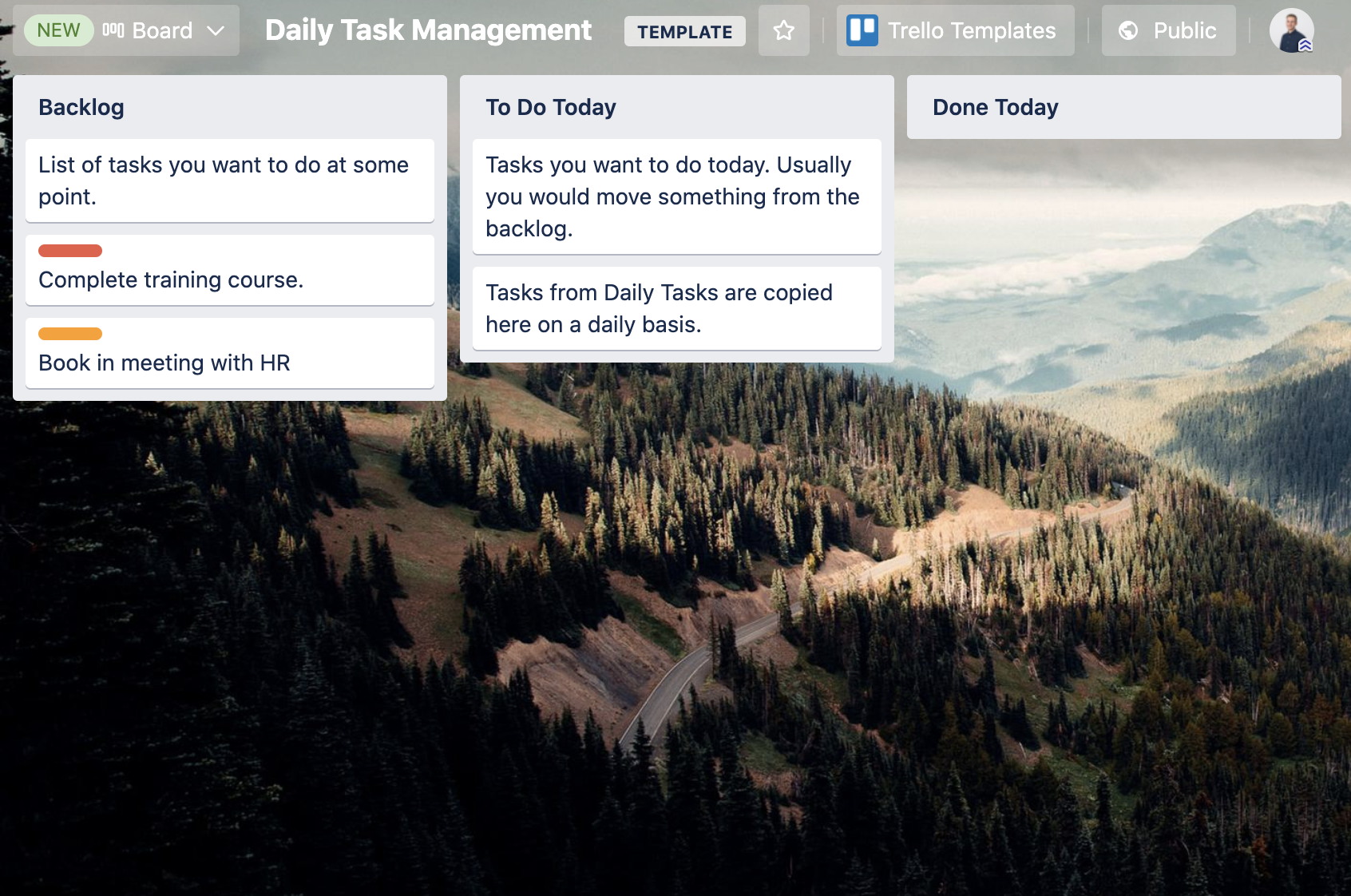
Having a visual representation of backlogged work, work in progress, and completed tasks is a great project management tool for most projects.
This would also be helpful for your second project, in particular, to keep track of tasks’ status as they move throughout the creative process. For example, designing a webpage for the new line of products will have various steps and creative team members involved. Visually seeing how the project is progressing will help you and the team to see how it’s coming along and where blockers are.
4. Lean: Projects That Do More With Less
For those organizations that are looking to transform how they do business, the lean methodology may be one to consider. Lean aims to maximize customer value and minimize waste. This is a great way to put out quality work while increasing efficiencies that minimize unnecessary spending, resources, teams output, or time.
Lean was created in the Japanese manufacturing industry to improve quality control and remove redundancies that may increase the price or value for customers down the line.
Known as the three M’s, Lean methodology defines three types of project waste: muda, mura, and muri.
- Muda is about getting rid of the waste or anything that doesn’t add value.
- Mura streamlines processes, so if one aspect of the project takes too long, for instance, then something further down the task list will have to be completed faster.
- Muri is about removing blockers, such as too many stakeholder meetings.
5. Waterfall: Large-Scale, End-Goal Focused, And Fixed Projects
Tried, tested, and true, the Waterfall methodology has been around since the 1970s. Like a waterfall that cascades downhill, this method is sequential with ordered tasks following one after another as they are completed.
The Waterfall method requires a very solid understanding of the end goal and the necessary steps to get there. As such, it doesn’t leave much room for errors or flexibility. This is great for projects that you’ve done in the past where there is minimal need to adapt on the fly.
This could be something to consider for your large-scale marketing project if you’ve launched new product lines many times in the past and don’t expect any surprises.
With this method, collect and analyze any and all project requirements and deadlines. This requires a lot of up-front work and planning. Then design your approach to meet every stage and their deadline in sequence before reviewing it and putting it into action.
6. Hybrid: Flexible And Fast-Paced Projects With Structured Plans
If agile aims to move fast, adapt quickly, and be flexible, Waterfall is its polar opposite, with fixed deadlines, clear deliverables, and mapped-out categorized project plans.
Hybrid is a methodology that blends the two. Think of it as the best of both worlds. You get the structure and organization of planning milestones out and the flexibility and speed of agile workflows.
It takes the flexible and fast pace of agile principles and blends them with the structured goals and mapped out plans of Waterfall. Take a look at your project requirements, task list, deadlines, and goals. The hybrid methodology uses those as your guidelines, but when it comes to getting the work done, teams should work with some flexibility on rapid iterations.
May The Best Methodology Help You Deliver On Your Projects
There are many more methodologies to name and discuss—and picking the right one for your project can be tricky! In the end, however, it’s all about picking a system that works for you, your project, and your team.
Project management methodologies were created to help you deliver the best possible outcomes based on your project’s circumstances. Take your time to find what works best, try them out, and do a debrief with your team on what worked and what didn’t. If it wasn’t the right methodology for one project, it may be ideal for another—and now you’re armed with that much more knowledge and expertise.
Happy project planning!
Advice, stories, and expertise about work life today.
Project Management Methodologies
Waterfall, Agile, Scrum, Kanban and more. If you’re wondering which methodology you should choose, then you need to read this guide to project management methodologies.
Table of Contents
What is a project management methodology, why are there so many different types of project management methodologies, the project management process: how to choose the right project management methodology, 17 project management methodology examples and frameworks, choosing the right project management methodology.
Once you’ve decided you want to become a project manager , the next step is to figure out which project management methodologies are right for you and your team.
The landscape of project management methodologies can seem a bit overwhelming.
Whether you have a formal project management certification or you’re learning to become a project manager from experience, there’s an absolute smorgasbord of project methodologies to choose from. And they often come with their own rules, lists, principles, and endless acronyms.
We believe that finding the right project management methodology to manage your work shouldn’t be rocket science. So we’ve compiled this list of different project management methodologies to help you figure out which methods, principles and approaches you can use for each team and project.
The only all-in-one platform for client work
Trusted by 20,000 businesses and 6,000 agencies, Teamwork.com lets you easily manage, track, and customize multiple complex projects. Get started with a free 30-day trial.

A project management methodology is a set of principles and practices that guide you in organizing your projects to ensure their optimum performance.
Basically, it’s a framework that helps you to manage your project in the best way possible.
Project management is so important to organizations and teams, but in order for it to be really effective, you need to make sure you’re correctly mapping your project management methodology to your team type, project, organization, and goals.
No two projects are exactly the same (even when you’re using handy features like project templates to replicate your past successes).
And when you factor in the different goals, KPIs and production methods of not only different types of teams but also different types of industries , it makes sense that there’s no one-size-fits-all approach to managing a project.
What works best for one type of team could be an absolute nightmare for another.
For example, many software developers started to find that traditional project management methods were hindering — rather than helping — their workflows and negatively affecting their performance and results.
As a result, software teams began to develop a new type of project management methodology, which was designed to address their particular concerns.
Before long, other teams and industries started to adapt those new project management methods to fit their unique needs and concerns. And on and on, with different project management methodologies being repurposed and adapted for different industries and tweaked to fit specific use cases.
What we’re left with is a ton of different project management methodologies to choose from. So how do you know which project management method (or methods, plural) is right for you and your team?
There are lots of factors that will impact which project management methodology is right for your project, team, and organization. Here’s a quick breakdown of some of the key considerations that can help you decide:
Cost and budget: On a scale of $ to $$$, what sort of budget are you working with? Is there room for that to change if necessary, or is it essential that it stays within these predetermined limits?
Team size: How many people are involved? How many stakeholders? Is your team relatively compact and self-organizing, or more sprawling, with a need for more rigorous delegation?
Ability to take risks: Is this a huge project with a big impact that needs to be carefully managed in order to deliver Very Serious Results? Or is it a smaller-scale project with a bit more room to play around?
Flexibility: Is there room for the scope of the project to change during the process? What about the finished product?
Timeline: How much time is allotted to deliver on the brief? Do you need a quick turnaround, or is it more important that you have a beautifully finished result, no matter how long it takes?
Client/stakeholder collaboration: How involved does the client/stakeholder need — or want — to be in the process? How involved do you need — or want — them to be?
Waterfall methodology
Agile methodology
Scrum methodology
Kanban methodology
Scrumban methodology
eXtreme programming (XP) methodology
Adaptive project framework (APF) methodology
Lean methodology
Critical path method
Critical chain project management
New product introduction (NPI)
Package enabled reengineering (PER)
Outcome mapping
PMI’s PMBOK
PRINCE2 methodology
Rapid application development (RAD) methodology
We’ve compiled a list of 17 effective project management methodologies to help you get to grips with the basics. Let’s dive right in.
1. Waterfall methodology
The Waterfall method is a traditional approach to project management. In it, tasks and phases are completed in a linear, sequential manner, and each stage of the project must be completed before the next begins.
The stages of Waterfall project management generally follow this sequence:
Requirements
Construction
Deployment & maintenance
Progress flows in one direction, like a real waterfall.
Also like a real waterfall, though, this can quickly get dangerous. Since everything is mapped out at the beginning, there’s a lot of room for error if expectations don’t match up with reality. And there’s no going back to a previous stage once it’s completed (just imagine trying to swim against a waterfall — not fun).
Try this project management methodology if:
The end goal of your project is clearly defined — and isn’t going to change.
The stakeholders know exactly what they want (and it isn’t going to change).
Your project is consistent and predictable (i.e. isn’t going to change).
You’re working in a regulated industry that needs extensive project tracking or documentation.
You might need to bring new people into the project midway through and get them up to speed quickly.
This project management methodology might not be for you if:
Your project is liable to change.
You don’t have a full picture of all the requirements before you start.
You need to do continuous testing or adapt to feedback during the process.
2. Agile methodology
Agile project leaders help their team balance at the edge of chaos - some structure, but not too much; adequate documentation, but not too much; some up-front architecture work, but not too much. Finding these balance points is the art of agile leadership." ~ Jim Highsmith, author and software engineer
The agile project management methodology came from a growing dissatisfaction with the linear approach of traditional project management methodologies.
Frustrated with the limitations of project management methods that couldn’t adapt with a project as it progressed, the focus began to shift to more iterative models that allowed teams to revise their project as needed during the process instead of having to wait until the end to review and amend.
The concept of agile project management has gone on to spark several specific sub-frameworks and methodologies, such as scrum, kanban, and lean. But what do they all have in common? The key principles of agile project management methodologies are:
It’s collaborative.
It’s quick.
It’s open to data-driven change.
As such, agile project management methodologies usually involve short phases of work with frequent testing, reassessment, and adaptation throughout.
In many agile methods, all of the work to be done is added to a backlog that teams can work through in each phase or cycle, with project managers or product owners prioritizing the backlog so teams know what to focus on first.
You’re not sure at the outset what the solution will look like.
You need to work quickly, and it’s more important that you see speedy progress than perfect results.
Your stakeholders or client needs (or wants) to be involved at every stage.
This project management methodology isn’t for you if:
You need a lot of documentation (for example, if you’ll be bringing new people on-board during the project).
You need a predictable deliverable, and you need to be crystal clear about what that looks like from the outset.
Your project can’t afford to change during its course.
You don’t have self-motivated people.
You have strict deadlines or deliverables that you need to stay on top of.
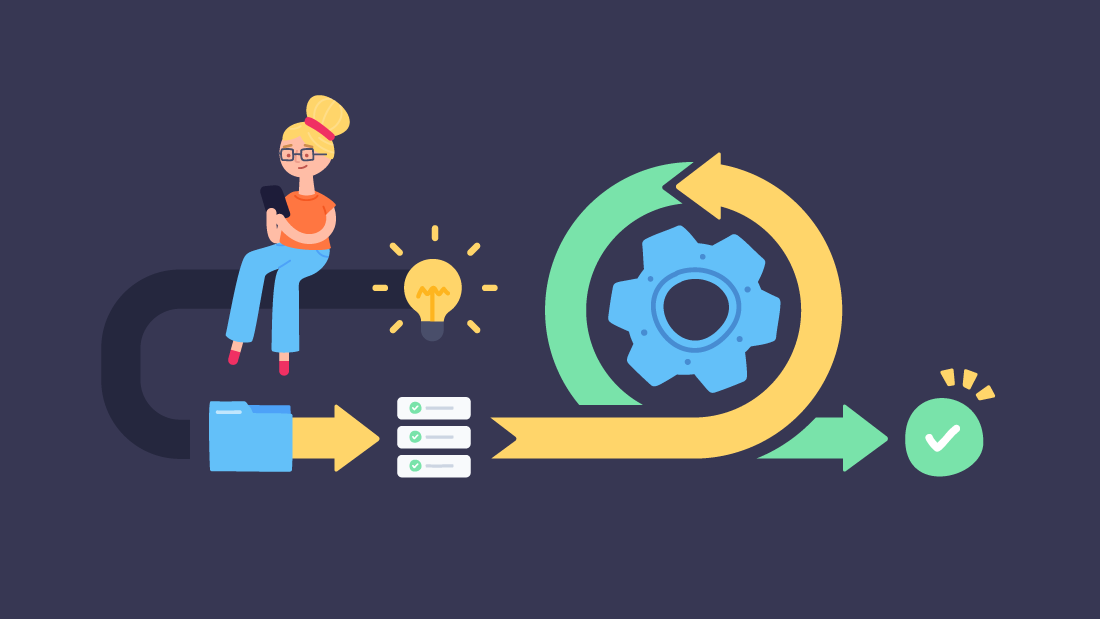
The Best Agile Project Management Tools To Use In 2023 & Beyond
It does little good to adopt the Agile method while still using a software that bogs down or complicates your projects. The best agile project management software should go hand-in-hand with the Agile method and make these adaptations smooth, fast, and easy.
3. Scrum methodology
Scrum is a form of agile project management. You can think of it more like a framework than as a project management methodology in itself.
With Scrum, work is split into short cycles known as “sprints”, which usually last about 1-2 weeks. Work is taken from the backlog (see: Agile project management, above) for each sprint iteration,
Small teams are led by a Scrum Master (who is not the same as the project manager ) for the duration of the sprint, after which they review their performance in a “sprint retrospective” and make any necessary changes before starting the next sprint.
You’re striving for continuous improvement.
You don’t have the full commitment from the team needed to make it work.
4. Kanban methodology
"Kanban is not a software development lifecycle methodology or an approach to project management. It requires that some process is already in place so that Kanban can be applied to incrementally change the underlying process." ~ David J. Anderson, Author and pioneer of the Kanban method
Kanban is another method within agile project management.
Originating from the manufacturing industry, the term “kanban” has evolved to denote a framework in which tasks are visually represented as they progress through columns on a kanban board . Work is pulled from the predefined backlog on a continuous basis as the team has capacity and moved through the columns on the board, with each column representing a stage of the process.
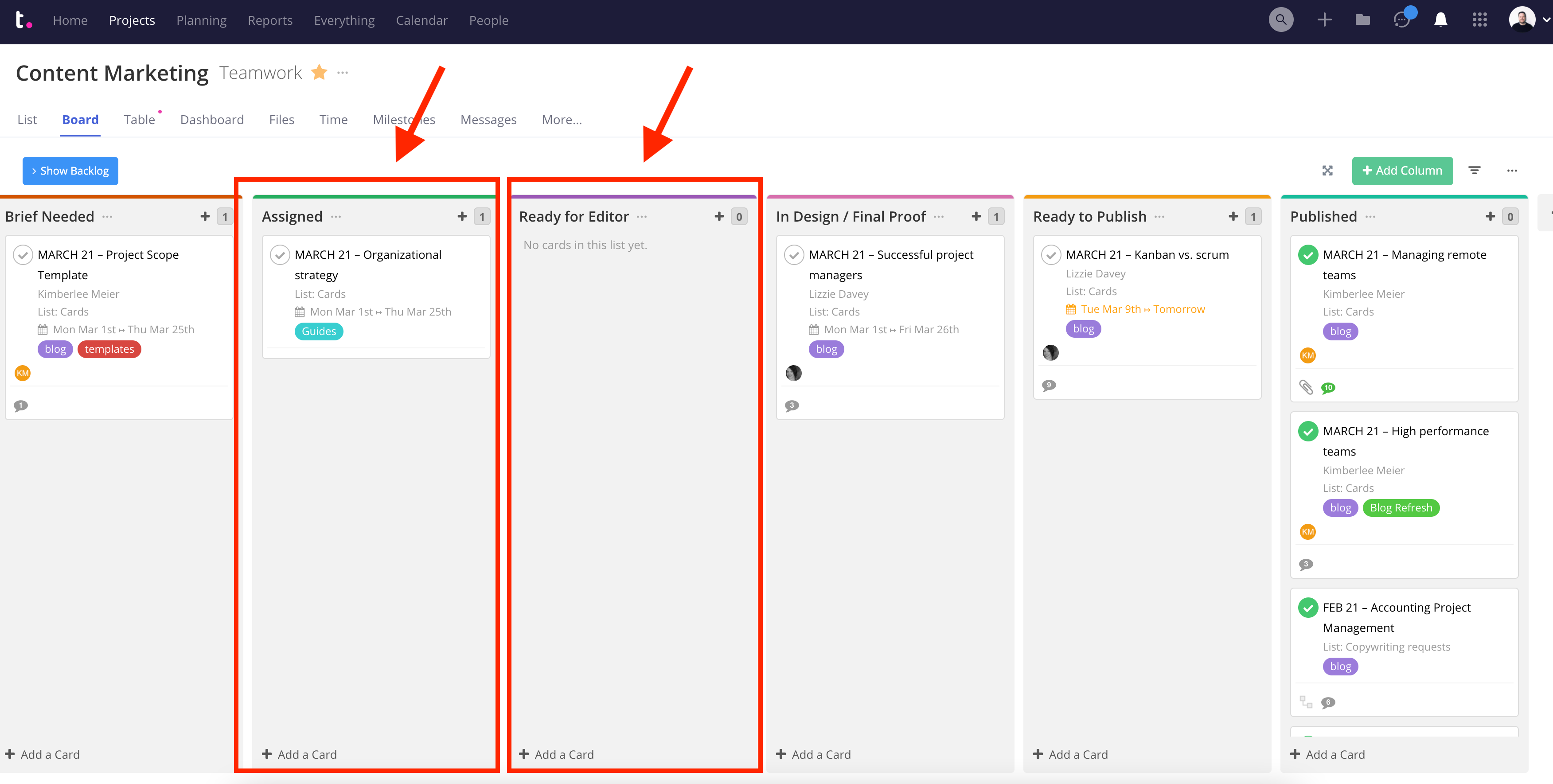
Kanban is great for giving everyone an immediate visual overview of where each piece of work stands at any given time. (You can use kanban boards for everything from your content marketing process to hiring and recruitment .)
It also helps you to see where bottlenecks are at risk of forming — if you notice one of your columns getting clogged, for example, you’ll know that that’s a stage of your process that needs to be examined.

When used as part of an agile project management methodology, it’s also common to implement work in progress (WIP) limits. Work in progress limits restrict the amount of tasks in play at any given time, meaning that you can only have a certain number of tasks in each column (or on the board overall).
This prevents your team from spreading their energy across too many tasks, and instead ensures that they can work more productively by focusing on each task individually.
You’re looking for a visual representation of your project’s progress.
You want at-a-glance status updates.
You want to encourage using WIP limits so your team can stay focused.
You prefer to work on a continuous “pull” basis.
Your process is super complex or has tons of stages.
You want a push system instead of a pull system.
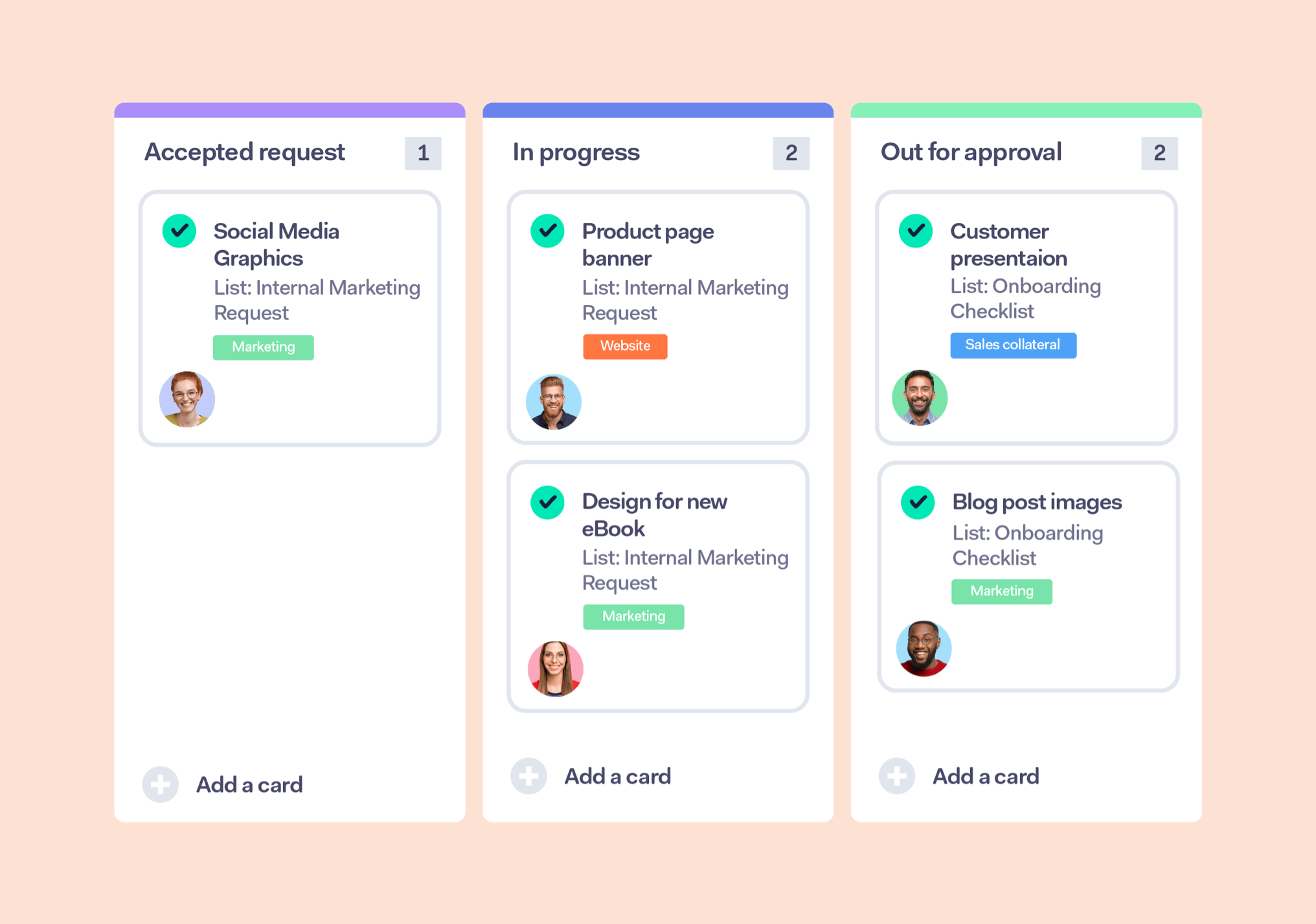
Kanban board view
Use kanban boards in Teamwork.com to map out your workflow, quickly see the status of tasks, and automate your processes.
5. Scrumban methodology
It’s the answer to the age-old question: what if scrum and kanban had a baby?
Scrumban is a hybrid agile project management methodology that has scrum’s nose and kanban’s eyes.
The main benefit of scrumban as a method is that instead of deciding which task from the backlog to work on in each sprint at the outset (like you would in a “traditional” scrum framework), scrumban allows teams to continuously “pull” from the backlog based on their capacity (like they would in a kanban framework).
And using work in progress limits (from kanban) during your sprint cycle (from scrum), you can keep a continuous flow while still incorporating project planning , reviews and retrospectives as needed.
You’ve ever looked at scrum and kanban and thought “I wish those two crazy kids would get together”.
You’ve ever looked wistfully out the window and thought, “Oh, scrum is scrum, and kanban is kanban, and never the twain shall meet”.
6. eXtreme programming (XP) methodology
The eXtreme Programming (XP) methodology is another form of agile project management that was designed for software developmen t.
It emphasizes teamwork and collaboration across managers, customers, and developers, with teams self-organizing. It has a defined set of rules that teams should follow, which are based on its five values: simplicity, communication (face to face is preferred), feedback, respect, and courage.
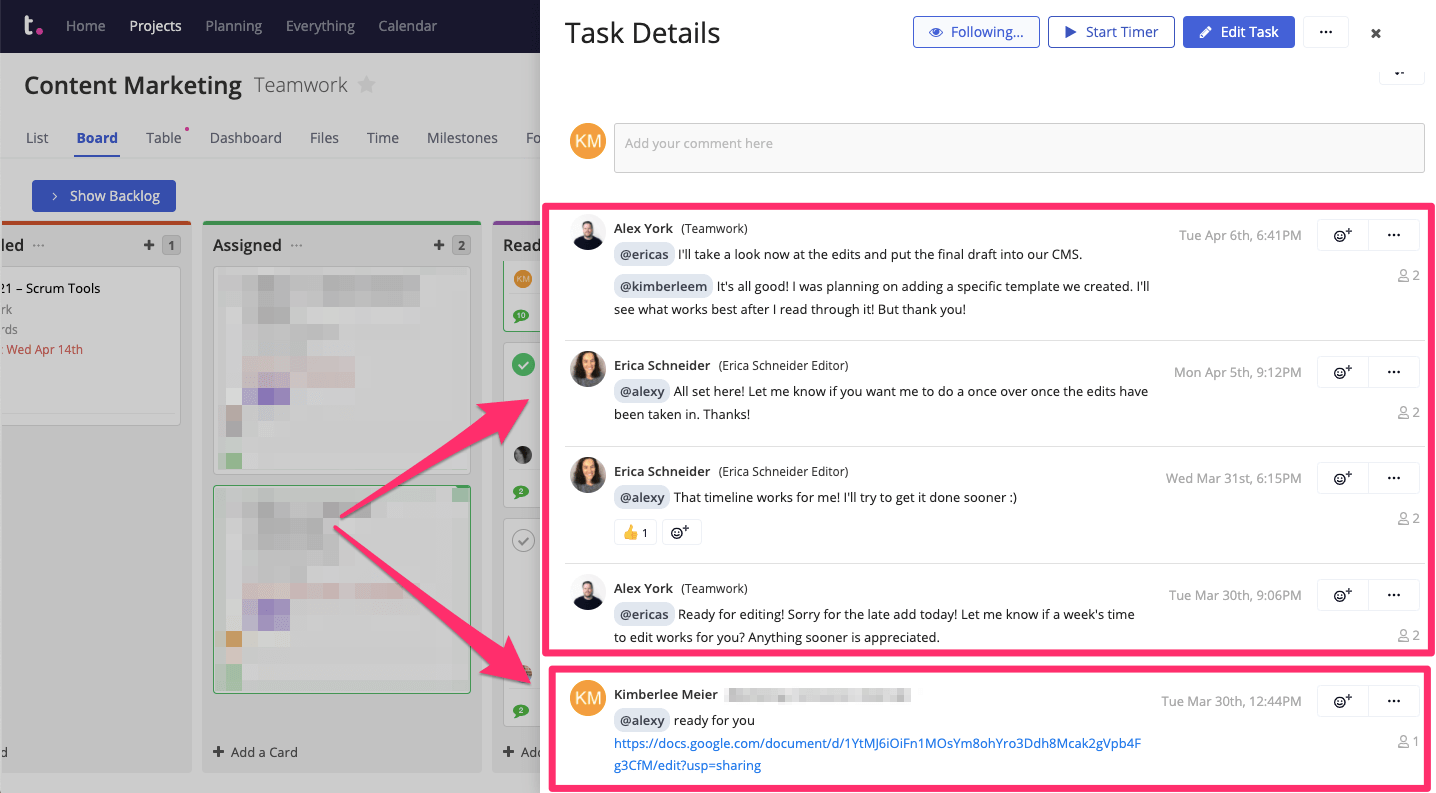
You want to foster teamwork and collaboration.
You have a small, co-located team.
You’re a rulebreaker.
Your team is spread across different places and time zones.
7. Adaptive project framework (APF) methodology
The adaptive project framework (APF) methodology, also known as adaptive project management (APM), is a type of agile project management methodology that was designed with the inevitability of change in mind.
The adaptive project framework knows that, as John Steinbeck might say, even the best-laid projects of mice and men often go awry. So the fundamental attribute of APF is that teams need to be able to adaptively respond to change.
That means that using adaptive project framework methods, teams must try to anticipate the risks and prepare for the unexpected in their project. They need to understand that key components are constantly in flux, and be able to constantly re-evaluate results and decisions with these moving parts in mind.
This requires lots of communication with all stakeholders and — like other agile project management methodologies — be able to work collaboratively.
You know your ultimate goals (in project management terms, you’ve outlined your Conditions of Satisfaction; or, in Beastie Boys terms, you’re clear about you’re clear about whatcha whatcha whatcha want).
You need predictability.
You don’t have the resources to handle the potential negatives of adaptability (e.g. scope creep, rework, misuse of time).
8. Lean methodology
Lean is another project management methodology that has its origins in manufacturing (and specifically the Toyota Production System). It’s all about applying lean principles to your project management methods to maximize value and minimize waste.
While this originally referred to reducing physical waste in the manufacturing process, it now refers to other wasteful practices in the project management process. These are known as the 3Ms: muda, mura, and muri.
Muda (wastefulness) consumes resources without adding value for the customer.
Mura (unevenness) occurs when you have overproduction in one area that throws all of your other areas out of whack, leaving you with too much inventory (wasteful!) or inefficient processes (also wasteful!).
Muri (overburden) occurs when there is too much strain on resources such as equipment and people, which can often lead to breakdowns — in both machines and humans.
Using the key principles of lean, a project manager can reduce these types of waste to create more efficient workflows.
You’re looking for a set of principles that will help you cut the fat and optimize your flow.
You’re always trying to improve and add value for the customer.
You want to ultimately decrease costs.
You can’t afford to run into supply problems (e.g. you don’t have enough inventory in stock) or lose room for error (e.g. in the case of essential equipment failure).
You don’t have the budget to invest in it (while lean project management aims to reduce costs overall, it can be costly to implement).
You’re a raccoon and you love waste, actually.
9. Critical path method
A project without a critical path is like a ship without a rudder." ~ D. Meyer, Illinois Construction Law
The critical path method (also known as critical path analysis) is a way of identifying and scheduling all of the critical tasks that comprise your project, as well as their dependencies.
That means that you need to:
Identify all of the essential tasks you need to do to achieve your project goal
Estimate how much time each of those tasks will take (bearing in mind that certain tasks will need to be completed before others can be started)
Use all of that information to schedule the “critical path” you’ll need to take in order to get the project done as quickly as possible without missing any crucial steps.
The longest sequence of critical tasks becomes your critical path, and will define the timeframe for your project.

Along the path, you’ll have milestones to meet that will signal when one set of tasks (or phase) is over and you can move on to the next one.
There are lots of ways to visualize the critical path, depending on the complexity of your project, from flow graphs to Gantt charts .

Your project is large-scale and complex.
Your project has a lot of dependencies.
You’re looking for a visual way to map out the sequence of tasks.
You need to identify which tasks are the most important so you can better allocate your resources.
You have a strict plan and deadlines, with no room for silly business.
You love algorithms. Love ‘em!
You don’t need something with a lot of complexity.
You’re unsure about deadlines, timings, or durations.
Your project needs wiggle room to change.
10. Critical chain project management
Critical chain project management (or CCPM) takes the critical path method (CPM) one step further.
While the critical path method defines the length of time needed to get each critical activity done from the beginning of the project to the end, it can often be, well, unrealistic when the time comes to actually put it into practice.
Critical chain project management addresses those issues by allowing a bit more time for the human elements of your project — like delays and resourcing issues.
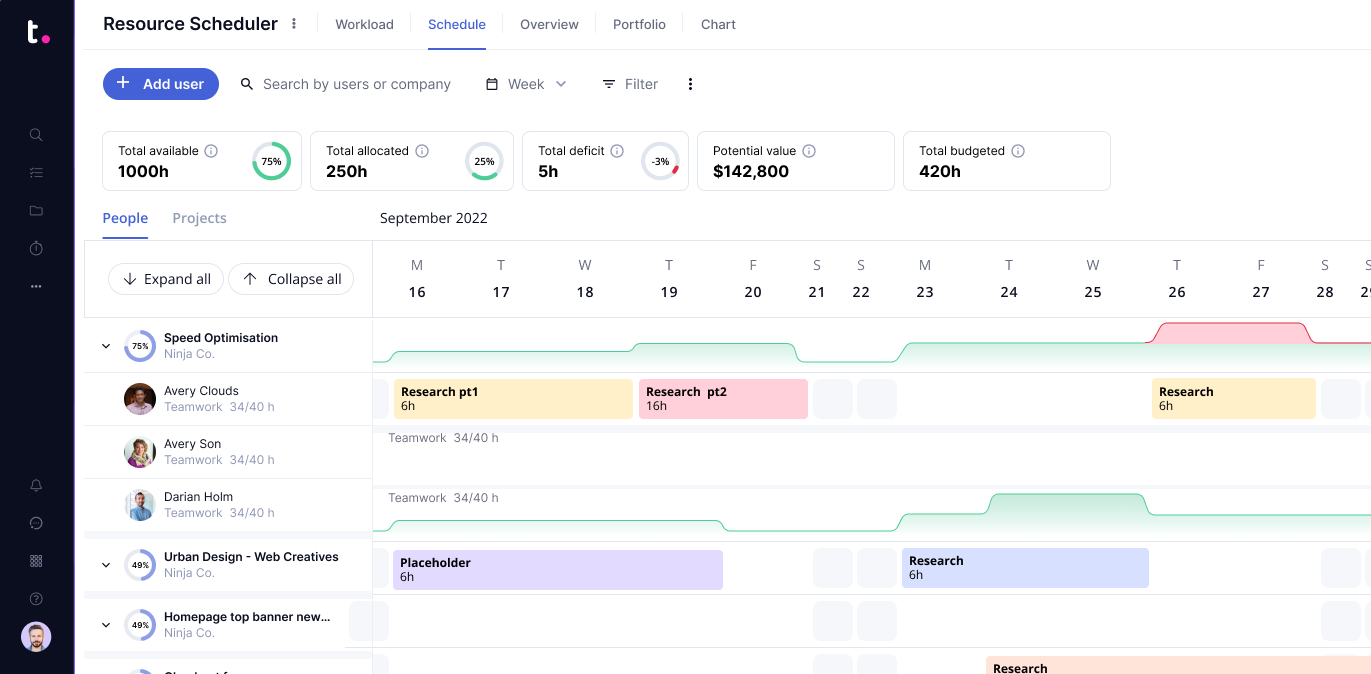
In critical chain project management, you have a few buffers built in that your critical chain can use without derailing everything else, so that your entire project doesn’t have to go off track just because life happens.
You like the sound of the critical path method, but you want something a little more realistic.
You were already overestimating task durations in CPM to allow for a buffer and you want more accurate data on how long the work is actually taking compared to your projections.
You think buffers are just a safety net for people who didn’t plan it right the first time.
Nothing could possibly go wrong.
11. New product introduction (NPI)
New product introduction is a great project management methodology for when you want to, well, introduce a new product.
Also known as new product development (NPD), the new product introduction process covers everything you need to define, develop and launch a new (or improved) product.
The project follows a single product through the entire development process. This process involves multiple phases or a stage-gate process, which can vary from organization to organization, but usually include things like:
Defining the product spec and project scope
Evaluating the feasibility
Developing the prototype
Validating the prototype via testing and analysis
Manufacturing the product on a larger scale
Evaluating the product’s success in the market after launch
As the requirements for a successful new product introduction span a number of departments across an organization, from leadership to product managers to marketing and more, it requires a lot of cross-functional collaboration and communication.
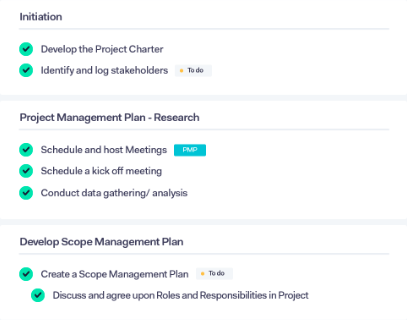
Project management template
Nail your next project with our project management template. Manage the bigger picture, and turn plans into actionable tasks - without missing a single detail.
You’re bringing a new or improved product to market.
You’re focusing on a single product.
You want to foster key stakeholder and cross-functional alignment right from the beginning.
You’re not bringing a new or improved product to market.
You’re looking for a more agile approach to product development (as NPI is usually sequential rather than iterative).
12. Package enabled reengineering (PER)
Package enabled reengineering (PER) is a project management methodology that aims to help organizations redesign products or processes with fresh eyes. It focuses on facilitating business transformations quickly and strategically, whether through redesign of processes or realignment of people.
Your organization needs an overhaul.
You need a fresh perspective on your products or processes.
You’re not trying to improve an existing system.
13. Outcome mapping
Outcome mapping is a project progress measurement system that was designed by the International Development Research Centre (IDRC). It differs from the other project management methodologies on this list in that it doesn’t focus on measurable deliverables; instead, it focuses on creating lasting behavioural change.
It’s a common project management methodology used in charitable projects in developing countries. As a project management methodology, it’s less about the project itself than the long-term impact of the project and its ability to effect change in the community. As a result, it measures influence rather than other (perhaps more “typical”) measures of project progress.
Outcome mapping consists of a lengthy design phase followed by a record-keeping phase to track the results.
Your project is aimed at changing behaviour rather than producing deliverables.
Your project is related to change and social transformation (e.g. in the fields of international development, charity, communications, research).
Your project is all about finished products rather than behavioural outcomes.
14. Six Sigma
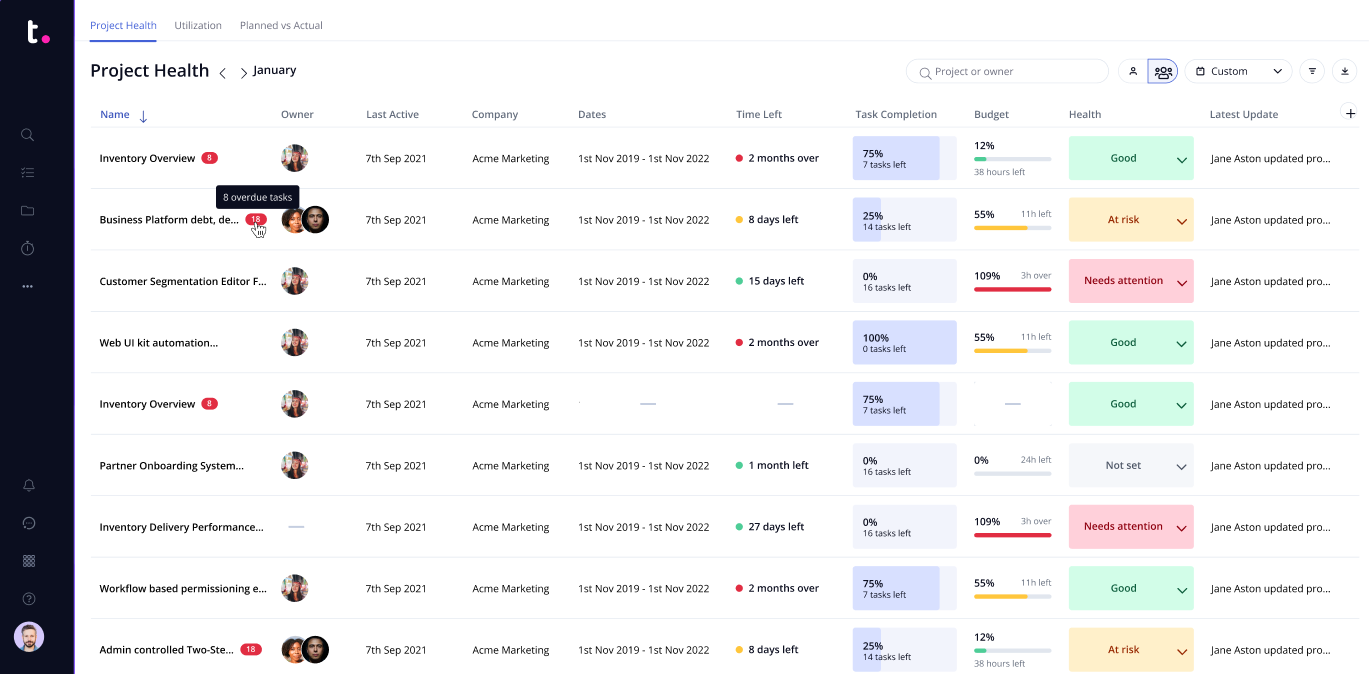
"Measurement is the first step that leads to control and eventually to improvement. If you can't measure something, you can't understand it. If you can't understand it, you can't control it. If you can't control it, you can't improve it." ~ H. James Harrington, author and management mentor
Six Sigma is a method for improving processes with an emphasis on ensuring consistency in output and impeccable quality. (And if it’s good enough for Jack Donaghy… )
There are a few different flavors available, such as Lean Six Sigma and Agile Sigma, but ultimately Six Sigma is a business methodology that aims to eliminate defects and reduce variation by using its defined methodologies.
Six Sigma methods can be used to optimize and improve existing processes or create new ones.
To improve business processes, you can use the Six Sigma DMAIC process, which stands for the phases in the project methodology: D efine, M easure, A nalyze, I mprove, C ontrol.
To create new processes or products, you can use the Six Sigma DMADV process: D efine, M easure, A nalyze, D esign, V erify.
As a set of principles and techniques (sometimes it’s even described as a “philosophy”) rather than a project management methodology in itself, Six Sigma methods can be applied alongside many other project management methodologies, like Lean and Agile.
You’re looking for a set of principles and philosophies you can bring with you to almost every project and organization.
You don’t have a lot of budget to invest in training — it can be expensive to get trained and certified.
You’re looking for a defined process for a particular project rather than a set of guiding rules.
15. PMI’s PMBOK
The Project Management Institute’s Project Management Book of Knowledge (AKA the PMI’s PMBOK) isn’t a project management methodology in and of itself. However, it is a best practices guide — and it forms the basis of the PMI’s Project Management Professional (PMP) certification, one of the leading project management qualifications.
As such, the PMBOK is an industry-standard set of guiding principles that you can use to ensure that your projects across multiple types of teams and organizations meet the PMI’s high standards and comply with best practices.
You have (or want to get) a PMP.
You want to stay up-to-date with industry standards and best practices.
You live and work in a place where the PMP is the standard project management qualification (such as the US).
You need a solid project management methodology to map your project, rather than general (albeit helpful) project management knowledge.
16. PRINCE2 methodology
PRINCE2 ( PR ojects IN C ontrolled E nvironments) is a project management methodology and certification that aims to equip project managers with knowledge of best practices and processes.
Unlike the PMP certification, it doesn’t require a number of prerequisites, making it a good choice for project managers looking to get both a methodological grounding and a qualification.
Also unlike the PMP, PRINCE2 is a methodology in itself. It’s guided by seven principles, which in turn dictate the seven processes a project manager needs to use in each project when using PRINCE2.
You’re looking for a certification to give you an edge.
You live and work in a place where PRINCE2 is the standard project management qualification (such as the UK).
You don’t want to commit to full certification.
The seven-step process doesn’t map to your projects.
You find yourself tailoring (or outright ignoring) the process stages so much that it becomes PINO — “PRINCE in name only”.
17. Rapid application development (RAD) methodology
Rapid application development (RAD) is a type of agile project management methodology that aims to facilitate faster software development .
It uses rapid prototype releases and iterations to gather feedback in a short period of time, and values that user feedback over strict planning and requirements recording.
You want to be able to give customers/clients/stakeholders a working model much sooner (even if it’s not perfect).
You want to create multiple prototypes and work with stakeholders to choose the best one.
Speed is of the essence.
You want to encourage code reuse.
You don’t have an experienced team.
Your clients or stakeholders don’t have the time to commit to such a collaborative process or can’t give feedback within the necessary timeframes.
You have a large team.
You prefer to have a detailed spec that outlines all functional and non-functional requirements.

The right project management methodology can elevate your project and help the project manager to get the best out of each team.
Whether you prefer the agile methods favored in IT project management or the more traditional waterfall project management and critical path methodology used in construction and manufacturing, there’s a project management methodology for every team.
But no matter which methodology you go for, you need a collaborative, flexible, and easy-to-use project management tool to support you every step of the way.
Choosing a team management software that supports multiple methodologies — i.e. that doesn’t lock you into one methodology or way of using it — like Teamwork.com means that every team in your organization has the freedom to work the way that works for them without sacrificing on features or complexity.
No matter how you like to work, Teamwork.com helps your team to replicate their best practices, ensure compliance and consistency, and constantly improve their processes.
What project management methodology allows some of the phases and tasks to overlap?
The project management methodology that allows some of the phases and tasks to overlap is known as "Agile" or "Agile Project Management." Agile is a flexible and iterative approach to project management that tends to be divided into "Sprints", which are time-boxed periods of work. Within each Sprint, cross-functional teams work on various tasks and features, allowing for a degree of overlap between different project phases.
What project management methodology requires the team to complete the previous phase before the next phase starts?
The project management methodology that typically requires the team to complete the previous phase before the next phase starts is the "Waterfall" methodology. Waterfall is a traditional, linear, and sequential approach to project management. In a Waterfall project, each phase must be completed in its entirety before the next phase can begin.
Why do project managers use project management methodologies?
Project managers use project management methodologies to bring structure and organization to their projects, ensuring consistency, risk management, resource allocation, and quality assurance. These methodologies promote effective communication, change management, and scope control, leading to increased efficiency, client and stakeholder satisfaction, and overall project success. They also foster a culture of continuous improvement and adaptability, allowing project managers to navigate changing requirements and uncertainties effectively.
How many project management methodologies are there?
There are numerous project management methodologies, with dozens of well-known approaches like Waterfall, Agile, Scrum, PRINCE2, Kanban, Lean, and Six Sigma, among others. Custom methodologies are also created by organizations to meet specific needs.
What is the difference between agile and scrum?
Agile is a broader project management philosophy that emphasizes flexibility, collaboration, and customer feedback, while Scrum is a specific Agile framework. Scrum introduces roles (Scrum Master, Product Owner, Development Team), fixed-time sprints, and defined ceremonies (Sprint Planning, Daily Standup, Sprint Review, Sprint Retrospective) to guide project teams. It also includes key artifacts like the Product Backlog, Sprint Backlog, and Increment.
You may also like...

Get started with Teamwork.com
Start working together beautifully. See how Teamwork.com can help your team with our 30-day free trial.
Chapter 3: Project management methodologies
- Share on Facebook
- Share on LinkedIn
Link copied
There are many project management methodologies and frameworks out there, designed to assist with different types of projects. But how do you know which one is best for your efforts?
In this section, we’ll walk through the most popular PM methodologies, and share advice for how to choose the best method to fit your needs.
Waterfall or traditional project management
Waterfall or traditional project management is based on a defined set of tasks that are completed sequentially to produce a final deliverable. This method of PM is simple and predictable, but not very flexible.
Waterfall project management is ideal for projects with a single, large deliverable, like a building. While it’s less useful for projects that require a lot of flexibility, are subject to change, or require multiple, dependent tasks to be completed in tandem, like software development.
The main benefits of Waterfall are tight planning and organization, and a high degree of control over each project task and the greater project schedule. That said, using Waterfall can make it difficult to adapt to unexpected events or changes to project scope, which can result in added time, resources, and cost.
Teams often use a Gantt chart , a visual timeline tool that maps out project tasks in succession, in Waterfall-managed projects. Learn more about Gantt charts in Chapter 9 .
To learn more about the phases and pros and cons of Waterfall, visit our in-depth guide to creating and using a Waterfall chart .
The Agile family
The Agile family is a category of project management methodologies that prioritizes flexibility and continuous improvement over rigid, sequential processes. There are many popular methodologies within Agile, and we’ve dug into each below.
Agile project management
In Agile project management , teams complete smaller, incremental tasks, and then continually review, refine, and iterate based on feedback and demands of the end users.
Agile project management was formalized in 2001 by a group of software developers intent on finding a more collaborative, flexible method to complete projects. The group documented their ideas in the Manifesto for Agile Development , which lays out the following four values:
- Individuals and interactions over processes and tools
- Working software over comprehensive documentation
- Customer collaboration over contract negotiation
- Responding to change over following a plan
Agile PM prioritizes a collaborative relationship between the end user and the project team. The customer sets the project objectives, but the deliverables are subject to change as the team incrementally executes each project task. In Agile, each development feature is called a user story , which reflects how the end user will interact with it.
Agile project management was initially intended for software development, but is now commonly used across a variety of industries and types of projects. Learn more about the Agile process and how to implement it by reading our comprehensive guide to Agile PM .
Pros and cons of Agile project management
Agile is a good fit for projects that require a high degree of flexibility and are likely to shift as the project progresses. The top benefits of Agile include the following:
- Less upfront planning
- Increased open communication
- Continual feedback
- Flexible objectives
When used effectively, Agile also often leads to speedier delivery.
However, there are some tradeoffs to this flexible approach:
- Lack of concrete delivery date, which can lead to scope creep
- A high degree of dedication and flexibility from the project team
Is Agile right for you?
Remember, Agile isn’t for everyone. The methodology is likely not right for your team if any of the following apply to you:
- Your project is not very urgent.
- Your client’s expectations don’t support Agile (e.g., they want to give final approval at every stage of the project, or incremental delivery isn’t appropriate for the project specs).
- You or your client’s organization requires detailed documentation at every stage.
- Your current processes are not set up for a more flexible approach.
- Your team or organization doesn’t currently use Agile, and implementing it would be too costly or time consuming.
In the following sections, we’ll go over other methodologies that fall within the Agile family.
Additional Resources
The ultimate agile dictionary, free agile project management templates, best practices for agile project planning.
Scrum , the most popular Agile methodology, involves smaller teams that complete tasks in short, time-bound periods, called sprints , in order to incrementally work through pieces of a larger project or release.
Scrum typically leads to greater responsiveness in customer relationships, lower costs of development, increased job satisfaction, and more immediate returns. Scrum is a fluid practice that takes many moving parts, teams, and goals into consideration as the project progresses.
Scrum teams also engage in four regular meetings, or ceremonies , which provide structure to each sprint:
- Sprint planning: At this meeting, the product is presented and everyone on the Scrum team voices any concerns and feedback. The team designates priorities and estimates the timeline.
- Daily stand-up: The Scrum team meets daily during the sprint to debrief with the team, establish a daily plan, and voice any concerns so the team can address them together.
- Sprint review: Held at the end of each sprint, this meeting is a review of the working product and gives stakeholders transparency into what the team accomplished during the sprint.
- Sprint retrospective: The sprint retrospective is a meeting that occurs after each sprint to discuss team performance and establish ways to improve future efforts.
Each Scrum team has designated members who own specific pieces of the process. These roles include the following:
- Product owner: Possesses a thorough understanding of the product’s business value and serves as the middleman who communicates the stakeholder needs to the development team and writes and prioritizes user stories.
- Development team: Performs the technical development of the product and is responsible for the analysis, design, code writing, testing, and technical communication based on the user stories provided by the product owner.
- Scrum Master: Assists in the progress of the Scrum team by working hand-in-hand with the product owner and the development team to streamline work and eliminate distractions.
As with Agile, Scrum is popular in software development, but it can also be deployed successfully across marketing, design, and other creative projects. Learn more by reading our guide to implementing Scrum with the right tools .
Kanban is an Agile framework that prioritizes continuous improvement , an ongoing effort to improve a product or service incrementally. Kanban teams complete work items based on team capacity and manage resources using a visual kanban board that shows task status.
Kanban originated in Japan in the 1940s. Based on what he had seen in supermarkets, Toyota engineer Taiichi Ohno implemented a supply-and-demand method on the factory floor, which greatly improved the company’s inventory management.
Teams at Toyota created a visual cue (a kanban, which translates to “visual sign” or “card”) to communicate that they were ready to “pull,” or take on, more tasks or materials to complete their work. This approach enabled workers to only take on new tasks when they had capacity for them, which reduced excess work in progress (WIP) . This style of work is now known as the just-in-time (JIT) approach.
How to use a kanban board
The Kanban methodology centers on the kanban board, which is either a physical or digital “board” that includes three columns (or lanes ): to-do, doing, and done. Team members move cards, representing individual tasks, to different columns as a way to track task status. This provides a quick view of how items are progressing and ensures teams have adequate capacity to take on new work.
In recent years, teams have moved to online, digital kanban boards, which helps distributed teams collaborate on projects and gain real-time visibility into the work getting done. You can learn more about setting up a Kanban board with our guide .
Pros and cons of Kanban
Overall, Kanban is great for teams that have many incoming requests, short work cycles, and flexibility with resources and scheduling. However, Kanban can be difficult for teams that work on many interconnected, dependent tasks, or have tight deadlines to adhere to.
To learn more about implementing kanban from the ground up, read our complete guide for newbies .
Critical path method
Critical path method (CPM) is a technique for estimating the total duration of a project by identifying the order in which you must complete all project tasks, and then mapping out your sequenced tasks, called dependencies .
CPM follows the basic steps below:
- Identify all project tasks.
- Identify dependencies among tasks.
- Estimate the duration of each task.
- Add up the durations to calculate the total duration of your project.
- Update the critical path as the project progresses to compare estimated vs. actual timelines.
CPM helps teams reduce project timelines by identifying and scheduling the most important tasks and then scheduling other tasks to happen in parallel. CPM also helps with project planning, as you can easily reference estimated vs. actual project schedules and more accurately estimate how long each task will take on future projects.
Learn more about the steps and advantages of the method with our beginner’s guide to the CPM .
The change management methodologies
Change management is an umbrella term for techniques that help individuals, teams, and organizations implement new processes or achieve organizational change. In this section, we’ll cover event chain and extreme project management.
To learn more, visit our essential guide to change management , or find free change management templates .
Event Chain methodology
In event chain methodology , you identify tasks (events) and their relationships (event chains) in order to properly allocate resources and assess and reduce project risk.
The goal of event chain is to estimate the amount of time and resources you need to complete a project. This method follows some of the same steps as the critical path method — you also break down activities into smaller tasks and outline their dependencies and durations. But, in event chain, you do so to create a realistic timeline and budget, rather than to simply better manage the tasks (and task order).
Event chain can also serve as a modeling technique to create more conservative scheduling estimates, which ultimately improves performance by building in time to address unforeseen risks.
This methodology is often used in change management efforts to eliminate the need to overhaul projects, which can be extremely time consuming and resource-heavy.
Extreme project management
Extreme project management (XP or XPM) is used to manage a massive amount of change in a short period of time. XPM is ideal for fast-paced, complex projects that can handle a trial-and-error approach to successfully pull off the effort.
Think of XPM as the opposite of Waterfall methodology. As opposed to valuing a linear, planned project development process, XPM allows you to change your project plan, budget, and the final deliverable as requirements shift. In XPM, the onus is on the project team to self-correct and shift as necessary.
Extreme project management works well for projects with a high-degree of uncertainty, but is less useful for projects with a clear-cut timeline, budget, and scope.
The process-based methodologies
Process-based methodologies approach work as a collection of processes, rather than a strict methodology that you apply to a single project. These approaches are sometimes used as part of a larger business process management (BPM) strategy.
Lean is an approach aimed at maximizing value while minimizing waste. When deployed properly, Lean helps to identify and eliminate bottlenecks, delays, and other inefficiencies in order to deliver value faster.
Lean originated in manufacturing in the 1950s, but it has evolved over time and is used today across industries. As laid out in the book Lean Thinking , Lean involves the following five core principles and activities:
- Define value: Identify the value of each product or service in the eyes of the customer.
- Map the value stream: Map out the process (aka value stream ) and identify areas of waste, in terms of resources, time, or redundancy.
- Create flow: Create a flow plan that eliminates the waste you identified.
- Employ a pull system: Progress through the plan only as the customer has new needs. Doing so will prevent you from taking on too much at once, or creating a bottleneck at any stage of the process.
- Pursue perfection: Using the idea of continuous improvement, aim to eliminate as much waste as possible from your process.
Visit our comprehensive guide to Lean project management to learn more about different types of Lean methodologies and the best tools for implementing Lean.
Six Sigma is a process improvement methodology that aims to improve quality across projects. Six Sigma takes a statistical approach to measuring and eliminating bugs or defects in project deliverables and raising quality standards.
The basic steps in Six Sigma include finding defects, identifying and eliminating their cause(s), and optimizing processes to increase reliability and accuracy going forward.
Building off the Lean principle of pursuing perfection, Six Sigma aims to eliminate all opportunities for defects by using data-driven improvement cycles to achieve its goal.
There are two main Six Sigma methodologies:
- DMAIC: This stands for define , measure, analyze, improve, control , and is intended to help you improve existing processes.
- DMADV: This stands for define, measure, analyze, improve, verify, and is best for when creating new processes or products.
There is no single, formal certification body for Six Sigma, but many organizations offer training so teams can learn to implement the practice in their organization. Read our article on Six Sigma belts and certifications to learn more.
Six Sigma works well for teams who are interested in implementing data-driven ways to reduce defects and optimize business processes, but is less ideal for those looking for a strict set of steps to follow.
Read our in-depth guide to all things Six Sigma to learn more.
Lean Six Sigma
Lean Six Sigma is a hybrid approach to process improvement that combines the Lean principle of no waste and the Six Sigma principle of no defects to improve quality across processes, projects, and products.
Lean Six Sigma offers the following benefits:
- Increased cost savings due to fewer bugs or defects
- Improved quality
- Time savings due to fewer process issues
- Improved data-driven decision making
- Continuous process improvement throughout the organization
While Lean Six Sigma originated in manufacturing, a variety of industries can deploy it to reap benefits. The most common use cases include healthcare, construction, design, and government.
All About Lean Six Sigma
Free lean six sigma templates, other project management methodologies.
Below, you’ll find details on a few more project management methodologies that are gaining traction in the modern PM world.
PRINCE2 , or Projects in Controlled Environments , is a project management methodology that focuses on defining and delivering work against precise requirements. As opposed to Agile PM, PRINCE2 emphasizes intense planning and documentation of work items.
PRINCE2 is a hybrid methodology initially used for information technology (IT) projects to help reduce cost and time overruns. Now, it’s deployed across many different industries.
This approach works well for projects with a clearly defined goal. However, if you need more flexibility, or don’t have time to properly plan and document work, Agile methods might be a better option.
PRiSM , or Projects Integrating Sustainable Methods , is a modern project management methodology that values sustainability over all else. The goal of PRiSM projects is to reduce the environmental impact of a project and drive meaningful social impact.
The PRiSM model is based on the following six principles:
- Commitment and accountability
- Ethical decision making
- Integration and transparency
- Principal and values-based deployments
- Social and ecological equity
- Economic prosperity
Implementing PRiSM is a long term mindset shift that puts sustainability and equity at the center of all processes and projects and aims to maximize value for all involved.
Why you should choose a PM methodology for your organization
Choosing an organization-wide project management method ensures teams have a consistent guideline for how to manage each aspect of their projects, like resources, budget, communication, timeline, and more.
Of course, some teams and projects require different levels of planning, flexibility, and documentation. And, it can be overwhelming to choose one “perfect” approach when there are so many options out there.
But, by assessing the types of projects that you typically take on — as well as your existing processes — you can identify the most effective methodology for you.
In some cases, organizations may select multiple project management types to meet the requirements of different projects and teams.
How to choose the best PM methodology for you
To identify the right project management methodology, first consider the details of your project. Then, assess your existing systems and processes. Look at both what you need as well as what you already have in place to select the best method.
Ask yourself the following questions to evaluate your project needs:
Project basics
- What is the project’s focus?
- What industry are you in?
- How complex is the project?
- Is the project scalable?
Flexibility
- How flexible are your timeline, budget, and deliverables?
- How much planning do you need to do beforehand?
- What is your allotted budget, and how flexible is it?
- What resources do you have, and what additional resources do you need to obtain?
- How flexible is your timeline?
- Are there set start and end dates?
- Does your project have key milestones or a critical path?
Roles and responsibilities
- How many people or teams are working together on this project?
- How specialized is the work?
- What is the level of customer and stakeholder involvement?
After you’ve worked through the project-related questions, follow these steps to identify which methodology aligns best:
- Outline the main variables, like timeline, resources, and budget, that will drive the project.
- Consider how the methodology you choose will impact these variables, such as how a more flexible approach might affect a hard-and-fast deadline.
- Weigh the pros and cons of each methodology against the needs of your project. Think both about which will be the best fit and which will be least disruptive to your current processes.
- Collaborate with other team members to get input.
- Roll out the methodology to the team. This includes educating everyone on the new processes and setting up the necessary tools and documentation systems.
- Apply the methodology to the project and monitor it for success.

Here’s a simplified cheat sheet you can use to identify which methodology will work for your next project:
Discover a better way to streamline workflows and eliminate silos for good.
See why the world’s best creative teams run on Workamajig
The definitive guide to project management methodologies.
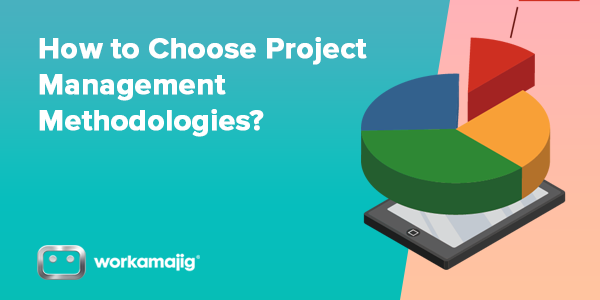
- Types of project management methodologies
- How to pick the right methodology
Browse more blogs
Originally published July 14, 2019. Updated with current & new info on April 25, 2022.
What are project management methodologies? A project management methodology is essentially a set of guiding principles and processes for managing a project. Your choice of methodology defines how you work and communicate.
So, how do you choose a project management methodology?
What methodology you choose will depend on your team, project type, and project scope . Choosing project management methodologies (PMM) is one of the first decisions you’ll have to make as a project manager.
What methodology you pick will have a profound and ongoing impact on how you and your teamwork. Different project management methodologies have their own pros and cons for different project types. Some are geared for speed, and some for comprehensiveness.
In this article, we’ll give you a complete overview of different PMMs and how to choose them.
Types of Project Management Methodologies
On paper, PM methodologies are tool agnostic, i.e. you should be able to use any methodology regardless of what PM tool you use.
In reality, most project management tools are specialized to use a handful of methodologies. This will be a factor in what methodology you eventually choose to use.
The question now is: What are the different types of project management methodologies? What are their advantages and disadvantages? What kind of projects are they best suited for?
Below, we’ll take a look at and explore 13 of the most popular project management methodologies.
1. waterfall methodology
What is the waterfall methodology.
The Waterfall methodology is the oldest methodology on this list. It was first outlined by Dr. Winston Royce in 1970 as a response to managing the increasingly complex nature of software development. Since then, it has become widely adopted, most prominently in the software industry.
The Waterfall methodology is sequential. It is also heavily requirements-focused. You need to have a crystal clear idea of what the project demands before proceeding further. There is no scope for a correction once the project is underway.
The Waterfall method is divided into discrete stages. You start by collecting and analyzing requirements, designing the solution (and your approach), implementing the solution, and fixing issues if any.
Each stage in this process is self-contained; you wrap up one stage before moving on to another.
Graphically, you can represent it as follows:
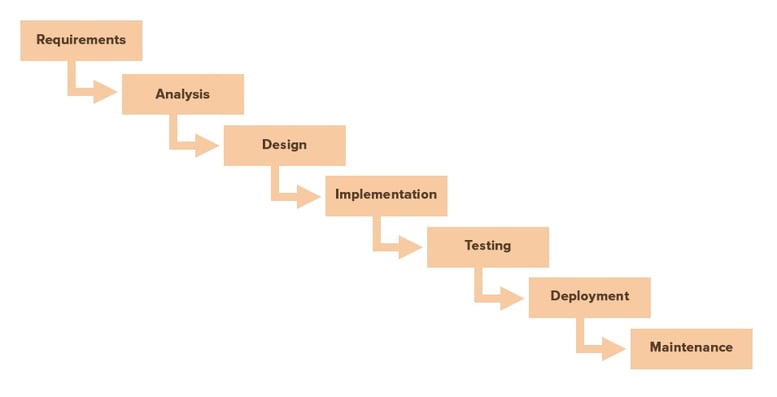
The above is from a software development perspective. Individual stages would be different for creative project management, but the approach remains the same.
Advantages of the Waterfall methodology
As Mike Wang, our Director of Training and Support, mentioned earlier :
“One of the driving factors behind waterfall management is that by investing time in the early stages of a project, managers ensure design needs and other requirements have been met—thus saving the time and effort generally associated with retroactively correcting problems”
Thus, the Waterfall method has several advantages, such as:
Ease of use:
Documentation:, disadvantages of the waterfall methodology, higher risk:, front-heavy:.
The Waterfall methodology is most commonly used in software development. It works best for the following project types:
- Short, simple projects
- Projects with clear and fixed requirements
- Projects with changing resources that depend on in-depth documentation
- For further reading on Waterfall methodology, see this post.
2. Agile methodology
What is the agile methodology.
Agile , another software development-focused PM methodology, emerged as a response to the failure of the Waterfall method for managing complex projects. Although Agile PM ideas had been in use in the software industry for quite a while, it formally came into being in 2001 when several IT representatives released the " Agile Manifesto "
Graphically, it can be represented as follows:

Advantages of the Agile methodology
Flexibility and freedom:, lower risk:, disadvantages of the agile methodology, no fixed plan:, collaboration-heavy:.
The flexibility of the Agile approach means that you can adapt it to different types of projects.
That said, this methodology works best for:
- When you don't have a fixed end in mind but have a general idea of a product.
- When the project needs to accommodate quick changes.
- If collaboration and communication are your key strengths (and planning isn't)
3. Hybrid methodology
The Hybrid methodology focuses on gathering and analyzing requirements initially - a nod to the Waterfall method. From thereon, it takes the flexibility of the Agile approach with an emphasis on rapid iterations.
By combining attributes of Waterfall and Agile, the Hybrid method (sometimes called "Structured Agile") gives you the best of both worlds.
Advantages of the Hybrid Methodology
Increased flexibility:, more structured:, disadvantages of the hybrid methodology, requires compromise:, the "best of both worlds".
The Hybrid approach is best suited for projects that have middling requirements when compared to Agile and Waterfall, i.e. they require structure as well as flexibility.
Mostly, these would be medium-sized projects with moderately high complexity but fixed budgets. You would likely have an idea of the end product but you are also open to experimentation. You will need close collaboration, especially past the planning stage.
4. lean project management
Lean project management focuses on maximizing efficiency by minimizing waste. It is inspired by the 1980s Lean manufacturing philosophy which holds that waste (the expenditure of resources on anything other than the creation of value for the end customer) should be eliminated.
LPM groups tasks into three types:
Value-Added: Tasks that advance the completion of the project and generate value for the customer (e.g., adding a roof to a hotel).
Enabler: Tasks that the customer isn’t paying for, but which are necessary for the project to be completed (e.g., project planning or quality testing).
Waste: Tasks that are unnecessary and which do not add value by advancing the completion of a deliverable (e.g., a team member attending a meeting at which they are not required).
Applying Lean principles to project management boils down to reducing the time required to complete projects. This is because the longer a project takes, the more money it will cost. Plus, missing the project deadline can cause a loss of benefits and attract financial penalties.
By eliminating wasteful activities so that more time can be spent on value-added tasks, LPM reduces the amount of time it takes to complete the project.
Advantages :
- Faster project completion times: Realizing the project earlier means that the customer will receive more value at a lower cost.
- Boost in quality : Attention is paid to details with the goal of minimizing mistakes and the need to make amendments. Processes become optimized and the quality of the work improves.
- An improvement culture: Project Managers practicing PLM are always communicating with their team about ways to cut waste and work smarter. Teams feel empowered and open to making and suggesting improvements.
Disadvantages :
- Inventory could be at risk: To decrease carrying costs, lean companies keep stock amounts low, leaving them vulnerable to supply chain issues.
- Expensive start-up: Updating legacy systems and introducing more efficient equipment, software and processes can be expensive and time-consuming.
- Requires culture change : Teams may be resistant to training and unwilling to adopt lean practices.
LPM is best for engaging team members and reducing staff turnover as everyone is encouraged to take the initiative and make continuous improvements. Using this method can give an organization a competitive advantage as it drives up quality and profits.
5. Scrum Project Management

Scrum isn't a fully-featured project management methodology. Rather, it describes an approach to Agile management with a focus on project teams, short "sprints" and daily stand-up meetings.
While it borrows the principles and processes from Agile, Scrum has its own specific methods and tactics for dealing with project management. As Mike put it earlier:
"Agile is the philosophy, and Scrum the methodology. While scrum is agile, agile isn’t scrum."
The Scrum approach places the project team front and center of the project. Often, there is no project manager. Instead, the team is expected to be self-organizing and self-managing. This makes it ideal for highly focused and skilled teams, but not so much for others.
- Scrum "sprints" : The Scrum approach is heavily focused on 30-day "sprints". This is where the project team breaks down a wishlist of end goals into small chunks, then works on them in 30-day sessions with daily stand-up meetings. This makes it easy to manage large and complex projects.
- Fast-paced: The "sprint" approach with its 30-day limit and daily stand-up meetings promotes rapid iteration and development.
- Team-focused: Since the project team is expected to manage itself, Scrum teams have clear visibility into the project. It also means that project leaders can set their own priorities as per their own knowledge of their capabilities.
Besides these, it has all the benefits of Agile - rapid iteration and regular stakeholder feedback.
Disadvantages
- Scope creep : Since there is no fixed end date, nor a project manager for scheduling and budgeting, Scrum can easily lead to scope creep.
- Higher risk: Since the project team is self-managing, there is a higher risk of failure unless the team is highly disciplined and motivated. If the team doesn't have enough experience, Scrum has a very high chance of failure.
- Lack of flexibility: The project-team focus means that any resource leaving the team in-between will hugely impact the net results. This approach is also not flexible enough for large teams.
The Scrum approach is best for highly experienced, disciplined, and motivated project teams who can set their own priorities and understand project requirements clearly. It has all the flaws of Agile along with all its benefits. It works for large projects but fails if the project team itself is very large.
In short: use Scrum if you're developing complex software and have an experienced team at your disposal.
6. Kanban Project Management
Kanban is a visual agile project management framework developed by Japanese auto giant Toyota in the 1950s. At its core is a physical or digital Kanban (signboard), divided into three columns representing three stages of completion:
- Work that hasn’t begun (backlog)
- Work in progress (WIP)
- Work that has been completed
Project tasks, listed on real or virtual Kanban cards, are added to the board and moved from one column to the next as their status changes. The more urgent a task is, the higher its position will be in the first and second columns.
- Maintains a smooth flow of production: By limiting the number of tasks in progress at any one time, Kanban protects the project team from becoming overburdened by work. This approach can maximize efficiency and speed up delivery times.
- Visible and transparent workflow: Kanban shows the status of each task and the overall progress of the project in a way that is immediately intuitive to most people.
- Not designed for a dynamic environment: Kanban assumes that a project will be executed according to a pre-arranged plan. This makes Kanban unsuitable for creative agencies where changes can be transformative rather than evolutionary.
- Lack of timeline: In Kanban, no timeframes are associated with each work stage. This makes it difficult to schedule deliveries and estimate things like project costs.
Best for:
Kanban is best for teams who want to visualize a project from start to finish. This method will help you avoid workflow bottlenecks and prevent too many tasks from being in progress at the same time, which can overwhelm teams and cause morale to plummet.
7. Scrumban Project Management
Despite its name, Scrumban isn’t simply an amalgamation of the Scrum and Kanban project management methods. Though it was created with the intention of helping teams transition from Scrum to a flow method such as Kanban, today Scrumban exists as a standalone agile method based on Lean.
Like Scrum, Scrumban involves planning out chunks of work (sprints). These iterations must be completed within a set timeframe (typically two weeks).
Deploying the same visual methodology and task-focused work organization as Kanban, tasks are represented as cards that move through different stages across a board.
Instead of tasks being assigned, team members choose what they want to work on. Scrumban places a hard limit on how many tasks can be in progress simultaneously.
- Good for large-scale or long-term projects : Scrumban simplifies complex projects by splitting them into smaller, manageable pieces. As an iterative Agile method, it allows small changes to be made over large stretches of time, making it a great framework for long-term projects.
- Prevents overwhelming workload: With Scrumban, the project is broken up into smaller tasks and teams focus only on what they have the capacity to complete. This helps to reduce the risk of scope creep.
Disadvantages:
Lack of management :.
Scrumban has no team hierarchy and no clear group leader. While this gives every person on the team the same opportunity to make decisions, it can cause confusion.
Troublesome tracking:
Best for:
Scrumban is best for teams who need structure and flexibility. By limiting WIP, it cuts down on multi-tasking, helping teams to maintain productivity. Scrumban projects don’t necessarily need to have a deadline which makes this method a good choice for very long-term projects or projects with an ambiguous goal.
8. Critical Path Method (CPM)
The above four project management methodologies emerged from software development. While you can certainly use them for non-software projects, there are better alternatives at your disposal.
One of the more popular alternatives is the Critical Path Method (CPM).
In the Critical Path Method, you categorize all activities needed to complete the project within a work breakdown structure . Then you map the projected duration of each activity and the dependencies between them.
This helps you map out activities that can be completed simultaneously, and what activities should be completed before others can start.
Better scheduling:
Prioritization:, scheduling requires experience:, no flexibility:.
The Critical Path Method is best suited for projects with interdependent parts. If you require tasks to be completed simultaneously, or for one task to end before another can begin, you'll want to use this methodology.
CPM finds a lot of application in complex, but repetitive activities such as industrial projects. It is less suited for a dynamic area such as creative project management.
9. Critical Chain Project Management (CCPM)
Critical Chain PM is one of the newer project management methodologies out there. It was developed as an alternative to the Critical Path method with a focus on resource management.
With CCPM, you work backward from the end goal. You recognize the deliverables, then use past experience to map out the tasks required to complete the project. You also map out the interdependencies between resources and allocate them accordingly to each task.
This graph from TrackerSuite shows the difference between a traditional vs. a CCPM project schedule.
CCPM emphasizes resource utilization and minimizing lost productivity. It is heavily reliant on "monotasking", i.e. focusing on the task at hand and avoiding multitasking.
For resource-strapped project teams, CCPM can be a powerful methodology.
Resource-efficient:
Focused on the end goal:, not appropriate for multi-project environments:, delays common:.
CCPM works best in environments where resources are devoted to a single project. If you have a dedicated team for a project, it works great. If your team is spread across several projects, you'll struggle with resource planning.
The resource-focused approach of CCPM is also ideal for resource-strapped project teams. If you find yourself constantly overworked or missing deadlines, the CCPM methodology might be for you.
10. Integrated Project Management (IPM)
Integrated Project Management (IPM) - sometimes also called "Integrated Project Delivery" - is a common project management methodology in creative industries. This methodology emphasizes the sharing and standardization of processes across the organization.
The IPM approach came about as a response to the increasingly integrated nature of creative campaigns. You don't just produce a single ad; you integrate the ad with microsites, digital content, etc. Most creative projects are a piece of a larger campaign.
An integrated project has the following components:

By integrating processes across the organization, IPM gives project managers better insight into the project and access to the right resources.
This makes IPM particularly appropriate for creative agencies.
Transparency:
Accountability:.
Requires extensive planning: With the IPM approach, you will have to plan extensively upfront and ensure that all processes are well-integrated. This increases your burden significantly and can lead to delays.
Large agencies with diverse teams and processes benefit the most from Integrated Project Management. It works best for complex creative projects where you need resources from multiple teams and departments to interface with each other.
PRiSM (Projects Integration Sustainable Methods) is a project management methodology developed by Green Project Management (GPM) Global.
As hinted by the creator's name, the PRiSM approach focuses on accounting for and minimizing adverse environmental impacts of the project. It is different from traditional methodologies in that it extends beyond the end of the project. Instead, it factors in the entire lifecycle of the project post-delivery to maximize sustainability.
Here's an overview of how activities are organized in PRiSM :
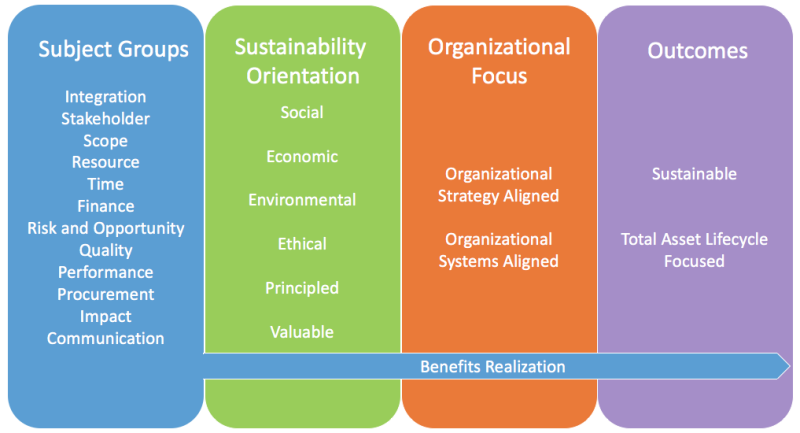
The PRiSM approach is very pertinent for modern projects where environmental costs and sustainability are key success criteria. For large projects where reducing energy consumption, managing waste, and minimizing environmental impact is critical, PRiSM offers a viable project management ideology.
PRiSM is unsuitable for projects where environmental impact is not a concern (such as software or creative projects).
Success with the PRiSM approach also requires every part of the project team - including outside contractors and stakeholders - to be on board with the sustainability principle - a hard ask in most organizations.
PRiSM is mostly suited for large and complex real estate and industrial projects where sustainability is a key concern.
12. PRINCE2
PRINCE2 (Projects IN Controlled Environments) is the official project management methodology of the UK government (which means that most UK government projects use it). You can even get a PRINCE2 certification to make working as a project manager in the UK easier.
PRINCE2 is based on 7 principles, 7 themes and 7 processes. The 7 PRINCE2 principles, for instance, are:
- Continued business justification
- Learn from experience
- Defined roles and responsibilities
- Manage by stages
- Manage by Exception
- Focus on products
- Tailor to suit the project environment
Wikipedia has a great introductory article on this methodology. I suggest you start there if you're interested in PRINCE2.
Running a PRINCE2 project requires extensive documentation. Additionally, one of the guiding principles of PRINCE2 is to "Learn from experience". This focus on documentation and past experience can help reduce risk.
The disadvantage of PRINCE2's extensive documentation is that changes can be hard to accommodate. If the requirements change, you have to redo the documentation and re-allocate resources, which can hamper the project pace.
This methodology is best suited for large and complex projects with fixed requirements. If you're in the UK, you'll likely want to know the PRINCE2 methodology. It is widely used in the country and is a requirement for government projects.
13. What is Six Sigma Project Management?
Developed in the 1980s by Motorola, Six Sigma is a data-driven quality-control management method focused on understanding customers’ requirements and eliminating waste and defects (anything that doesn’t meet customers’ expectations).
Statistical analysis is used to identify problems and determine their cause, and processes are improved through decisions based on data.
This quality management process is monitored by a team with Six Sigma expertise. Inspired by martial arts, Six Sigma uses belts to designate different levels of methodological mastery.
Within Six Sigma are two five-step methodologies: DMAIC (Define, Measure, Analyze, Improve, and Control) which focuses on incrementally improving existing processes, and DMADV (Define, Measure, Analyze, Design, Verify) which focuses on optimizing new products or processes to Six Sigma standards.
Advantages:
Proactive approach:, informed decision-making:, increased efficiency:, data deluge:, training requirements : companies must find certified six sigma institutes to train all their employees or conduct in-house training without formal certification., no framework:.
While Six Sigma can be a useful tool for small to medium-sized businesses seeking to reduce waste, it brings the greatest benefit to large-scale companies that continuously produce the same products or deliver the same services.
There are several other PMMs besides these, such as Crystal , Feature Driven Development (FDD), Dynamic Systems Development (DSDM), and Rational Unified Process (RUP).
For the most part, however, you’ll choose from one of the methodologies described above.
choosing the Right Methodology
From the above section, it is clear that different PM methodologies are better suited for different projects. You wouldn’t want to use PRiSM for a software project, just as you wouldn’t want to use Agile for big real-estate development.
When you’re picking PM methodologies, here are a few things to keep in mind:
1. Evaluate the Project
Focus on gathering initial requirements. If the requirements suggest that you need a large and diverse team, pick a methodology that supports flexibility.
Similarly, if you have a clear idea of the end result, pick a more structured methodology such as Waterfall. If the end result is vague (common in the case of in-house projects), pick an iterative methodology like Agile.
Some other things to consider when evaluating the project are:
- Project budget
- Size and complexity
- Stakeholder expectations
- Project type and industry
2. Evaluate Your Team
Your project management methodology is essentially a blueprint for the project. It tells your team what to create and when to create it.
For this to happen, however, your team should be able to read the blueprint itself.
In other words, if your team isn't familiar with the project management methodology of your choice, you will struggle to get results. You will have to devote time to learning the methodology (which some of your team members might be resistant to), leading to delays.
Here are a few things to consider when evaluating your team:
- Team experience
- Self-organization capabilities
- Team preparedness
- Team location (remote, on-site, etc.)
Essentially, pick a methodology that fits your team, instead of forcing your team to fit the methodology.
3. Evaluate Your Organization
How your company is organized, its culture, and its past records will have a big impact on your choice of project management methodology. Some methodologies only work with large organizations with established hierarchies. Others are more suitable for smaller, leaner outfits.
For instance, if your past records show that all your Agile projects have been delayed AND poorly received, it's a good idea to avoid this methodology in the future.
A few things you should consider when evaluating your organization are:
- Past records and experience with different methodologies
- Organization hierarchy
- Level of flexibility
- Organization maturity level
- Organization size
- Available resources, including external resources such as freelancers and contractors.
- Your industry
4. Evaluate Your Stakeholders
When choosing a PM methodology, factor in:
- Stakeholder involvement: Some methodologies demand that stakeholders be regularly involved at every stage of the project. With Agile, for instance, you need stakeholders to be regularly available for feedback. If the stakeholders are busy, pick a methodology that requires lower stakeholder involvement.
- Stakeholder requirements: How do your stakeholders work? What do they require from the project manager? If the stakeholders are known to change project scope frequently, pick a more flexible methodology. Similarly, if the stakeholders require daily updates, pick a methodology that can accommodate this demand.
Given the importance of stakeholders in the project’s success, keeping their requirements in mind will make for happier stakeholders and more successful projects.
5. Evaluate Your Tools
Project management tools are seldom methodology-agnostic. They are usually designed to work well with a specific methodology.
Hence, the software tools you have existing access to and expertise in will impact your choice.
To do this:
- Make a list of all software tools you currently use
- List their limitations and capabilities
- Compare their capabilities against the requirements for a specific PM methodology.
Ideally, the methodology you choose should work with your existing toolset. If you have to buy new tools, you will not only have to spend more but will also lose critical time in retraining your team.
Doing this in-depth evaluation will help you choose a methodology that aligns with your goals, your team’s capabilities, and your stakeholder’s requirements perfectly.
As a project manager, you have several project management methodologies to choose from. Each of these methodologies has its own strengths and weaknesses. Picking the right one will make running your project faster, smoother, and more efficient.
Pick from one of the several methodologies listed above. Then evaluate your project, team, organization, stakeholders, and existing tools to pick a methodology that aligns with your strengths and requirements.
Related Posts

Hybrid Project Management- Agile Waterfall Methodology Combined
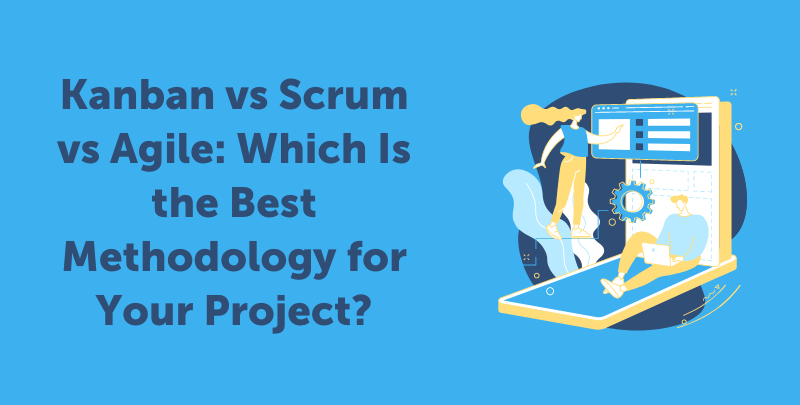
Kanban vs. Scrum vs. Agile: Which Is the Best Methodology for Your Project?

6 Top Project Management Techniques For Project Success
Run better projects sign up for our free project management resources..
Get all our templates, tips, and fresh content so you can run effective, profitable, low-stress projects in your agency or team.
Popular Insights:
Best Project Management Software
Mind Mapping Software
What is Project Management? Definition, Types & Examples
Share this Article:
Our content and product recommendations are editorially independent. We may make money when you click links to our partners. Learn more in our Editorial & Advertising Policy .

Key Takeaways
Featured Partners
{{ POSITION }}. {{ TITLE }}
Examples of Project Management
In order to better conceptualize what project management is, it’s helpful to understand how project management plays out in real-life applications. Here are a few examples of how project management is used across various industries every day:
Example One: Project Management in Construction
In 2005, BAA Airports Ltd. was presented with an enormous task: remodeling Terminal 1 within Heathrow Airport, the busiest international airport in the world while keeping the terminal open to the 20 million annual travelers that pass through the airport. The project was extremely complex, and made even more challenging by a strict deadline and significant public health concerns, given the construction project was taking place within an active terminal.
Throughout the project lifecycle, David Buisson, PMP, and the project manager in charge of the Heathrow renovation project, encountered many unexpected obstacles, including asbestos in the ceiling and inconsistencies with the floor level. Buisson and his team were able to properly navigate project challenges, operational risk, and communication management with key stakeholders. They successfully delivered the project on time and on budget—without any major mishaps—utilizing the PMBOK Guide from the Project Management Institute, the standard guide for project management professionals.
The 2005 renovation of Heathrow Airport Terminal 1 is widely considered one of the most successful case studies in construction project management to date.
Example Two: Project Management in Healthcare
During the Covid-19 pandemic, pharmaceutical and biotechnology company, AstraZeneca partnered with the University of Oxford to address the international need for a vaccine. The research partners at Oxford University had begun showing promising research around an early vaccine option. Paired with AstraZeneca’s manufacturing capabilities and global supply chain experience, it was a no-brainer for the two entities to pair up to address the pandemic.
However, the partnership would face numerous challenges throughout the project lifecycle, including, most notably, a highly unpredictable and rapidly evolving public health crisis. Adaptability had to be the name of the game, and the structured guidelines of project management provided a baseline for the team to work from. Ultimately, the project was an overwhelming success, with over 1 billion doses of the vaccine delivered to over 170 countries.
Example Three: Project Management in Aerospace Technology
The Mars Pathfinder Mission began in 1996 as a result of budget cuts within NASA, shifting the organization’s focus to projects that could be completed “faster, better, and cheaper.” The goal was to spend less than $150 million dollars on the project in total and implement it within 36 months. Based on the initial goals established by NASA, just getting the spacecraft to Mars and landing it in one piece would have been a success.
Instead, by the time the project reached completion in September 1997, the Mars Pathfinder returned 2.3 billion bits of information, including more than 16,500 images from the lander and 550 images from the rover, as well as more than 15 chemical analyses of rocks and soil and extensive data on winds and other weather taking place on Mars. Ultimately, the project was such an exemplary example of project management at work that it won the Project Management Institute’s coveted ‘‘Project of the Year Award’’ for 1998.
What is a Project Manager?
Project managers take ownership over the entirety of the project lifecycle from start to finish, from directing team efforts to navigating day-to-day challenges, implementing project management strategies, and more. Ultimately, they are responsible for the successful competition of the project and the distribution of key deliverables and project outcomes.
Responsibilities of a Project Manager
Project managers are responsible for a wide range of project-related duties, including but not limited to:
- Establishing and managing the project timeline
- Assigning project tasks and delegating responsibilities to team members
- Communicating with key stakeholders
- Executing each phase of the project
- Facilitating team adaptation of project management aids and tools (such as project management software, and Gantt charts)
- Monitoring the project budget and project scope, preventing cost or scope overruns
- Troubleshoot and mitigate potential roadblocks and issues
- Establishing set meeting schedules and facilitating team discussions
- Monitoring ongoing project progress
- Concluding the project lifecycle with relevant end-of-project responsibilities, including facilitating project reviews , and turning over deliverables
Essential Project Manager Skills
Project managers handle a wide variety of project-related responsibilities and duties, and understandably, need to wield a broad and flexible skillset. Some of the essential skills a project manager should possess include the following:
Soft Skills
Hard skills, phases of project management .
Check out the video below for an in-depth walkthrough of the five phases of the project management lifecycle.
Read more: 5 Phases of Project Management Life Cycle You Need to Know
1. project initiation.
The project initiation phase focuses on establishing a high-level vision for the project while securing approvals from sanctioning stakeholders. This phase is not meant to dive into excessive detail, but rather to get the ball rolling and get the team thinking about what is to come. Read more about the initiation phase .
2. Project Planning
During the project planning phase , teams build upon the vision established in the initiation phase in much more detail. First, teams must answer a few essential questions surrounding what the project will aim to accomplish, how the project will be carried out, when it will begin, on what timeline, and how project success will be measured. Once those initial questions have been answered, teams can dive into building out project infrastructure, covering essential topics such as:
- Project scope
- Deliverables
- Key stakeholders
- Goals and milestones
- Resources needed (internally and externally)
- Project timeline
- Potential risks or roadblocks
- Dependencies
- End of project outcomes
3. Project Execution
The project execution phase is the starring act of the project, and where most of the deliverables come from. During this phase, the project manager coaches and guides the team to present essential project deliverables while keeping stakeholders in the loop and monitoring progress against key milestones and KPIs. Throughout the project execution phase, project management systems, such as project management software, can make life easier by keeping track of deadlines and deliverables, serving as a platform for team member collaboration, and more. Learn more abou t project execution.
4. Project Monitoring
During the monitoring phase, the project manager(s) keep tabs on the progress of the project overall and the status of the team. Whether teams are on track and delivering stellar results or struggling with roadblocks and challenges, the project manager can help eliminate stressors, solve problems, and communicate updates with key stakeholders. Read more about project monitoring .
5. Project Closure
The closing phase of the project lifecycle is a time for wrapping up project activities, delivering project deliverables and outcomes, and reflecting on the wins and losses of the project overall. Communication is key within this final phase, where team members have an opportunity to reflect and celebrate. Learn more about the project closure phase .
Download Our FREE Project Lifecycle Guide
Project management methodologies.
Project management methodologies establish a guiding set of rules and principles that teams can implement in order to achieve greater efficiency while maximizing positive project outcomes. Each methodology approaches project management through a slightly different lens, providing teams with a specific set of repeatable steps to follow throughout the project lifecycle. Methodologies are rigid and cannot be used in combination with other methodologies.
Project management frameworks can exist within methodologies, providing a more focused view of how a methodologies guidelines can be applied and implemented. While the structure and rules follow the teachings of the methodology, frameworks can color in detail how and when those rules are applied in a project setting.
Agile project management focuses on an iterative and highly flexible approach to project management that focuses on delivering the project in pieces throughout the project lifecycle, rather than all at once at the project’s conclusion. In Agile project management, teams have more flexibility to adapt to challenges and redirections than in more structured methodologies, such as Waterfall.
Best for:
- Software development teams
- Teams dealing with high levels of uncertainty
- Teams who are creating prototypes that need multiple levels of edits and changes
- Teams working closely with external parties and stakeholders
Waterfall project management is a traditional approach to project management that involves rigid, sequential project phases. In the waterfall model, each phase of the project must be fully completed before the next phase can begin, and project deliverables are turned over only at the conclusion of the project.
- Projects with a well-defined goal
- Projects with concrete timelines
- Teams who need to define rigid project requirements early on
Project Management Frameworks
Scrum project management, as the name suggests, is inspired by the camaraderie and teamwork of a Rugby team within the Agile methodology. Led by a Scrum master, Scrum teams are encouraged to learn through their experiences, self-organize as they problem-solve, and progress throughout the project lifecycle.
- Smaller teams tackling numerous unknowns and ever-changing variables
The Kanban framework is a subset of the Agile methodology that emphasizes continuous improvement and flexible task management. In the Kanban framework, teams utilize Kanban boards, vertical boards that separate individual task cards into categories based on their status in the project lifecycle (for example: “not started,” “in progress,” and “completed”).
- Teams who are new to project management and looking for a simple, organized framework
- Projects with numerous individual tasks and assignments
- Teams who need quick access to a high-level view of task overviews and completion status
Critical Path Method (CPM)
Critical Path Method is a project management framework within the Waterfall methodology that identifies critical and non-critical tasks, prioritizing them based on their importance—eliminating bottlenecks and roadblocks. The CPM method emphasizes the importance of calling out relationships between tasks and task dependencies.
- Teams managing large, complex projects
- Projects that require a large number of tasks with subtasks and dependencies
- Teams who want to maximize efficiency and prevent roadblocks from the start of the project (especially for projects that have a high likelihood of complication)
PRojects IN Controlled Environments, or PRINCE2, is a framework within the Waterfall project management methodology that emphasizes organization and control. Frequently used in the UK and internationally, The PRINCE2 model breaks down projects into smaller, more manageable chunks in order to manage risk and resources while clearly defining team roles and responsibilities.
- Teams who have less experience in project management (PRINCE2 follows clearly defined, easy-to-understand steps)
- Teams who need more clarity around specific role-based responsibilities
- Compartmentalizing project steps and actions
Project Management Tools
Project management software.
Project management software helps teams organize all project essentials in one place, while streamlining and simplifying the project management process overall. At every phase of the project lifecycle, project management software supports teams’ ability to assign tasks, manage deadlines, view task dependencies, track team progress against goals, access data insights, and much more.

Read more: 10 Best Project Management Software for 2023
Project management charts , gantt charts.
Gantt charts are one of the most common planning tools in project management. In a timeline-inspired format, Gantt charts highlight tasks against the project timeline, task dependencies, and designated assignees. Gantt charts are useful for teams who want to visualize projects at a high-level view while avoiding resource overload.
Best for: Visualizing project timelines and task dependencies
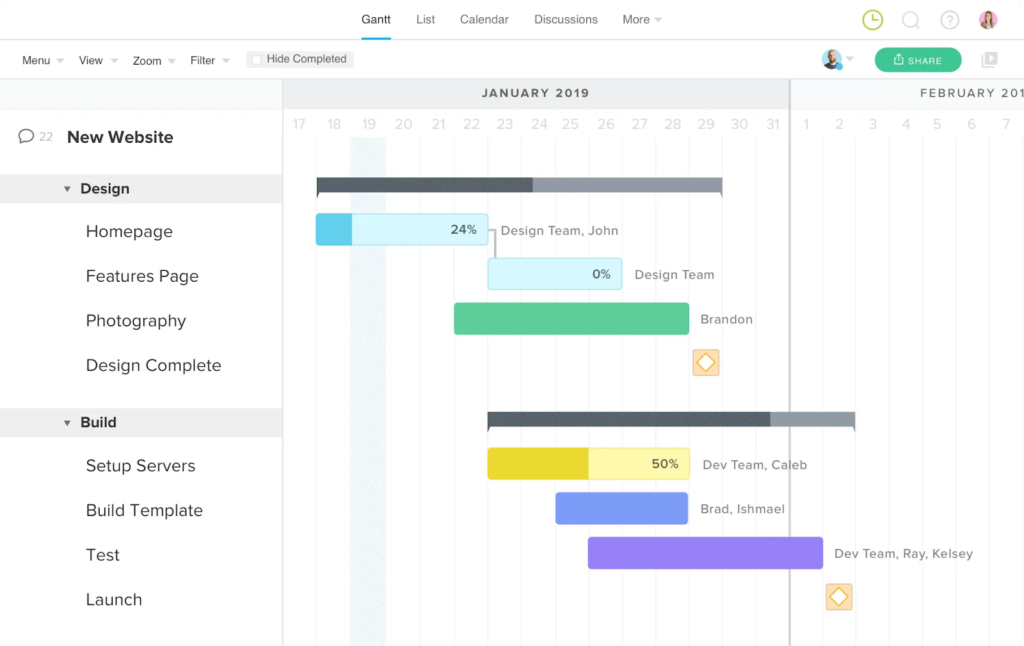
Burn-Up/Burn-Down Charts
Burn-up and burn-down charts visually represent how project tasks have been completed across a predetermined timeframe. This type of chart is popular with Scrum teams for tracking work across sprints, as it can easily reveal the total scope of work against items that have been completed or left unfinished.
Best for: Tracking project progress
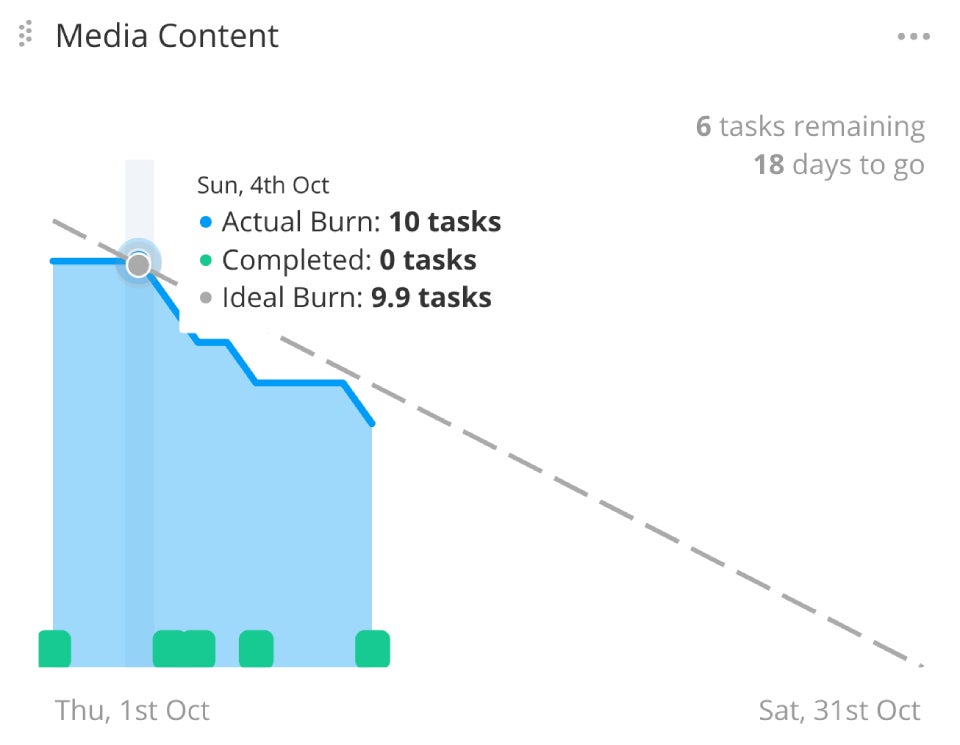
Read more: Best Project Planning Software & Tools
Collaboration tools.
Slack is a communication-focused collaboration software that enables teams to communicate asynchronously through messaging, audio calling, and video conferencing. While many project management software offerings include collaboration features, Slack is a faster solution for teams who need to communicate efficiently as project updates come up.
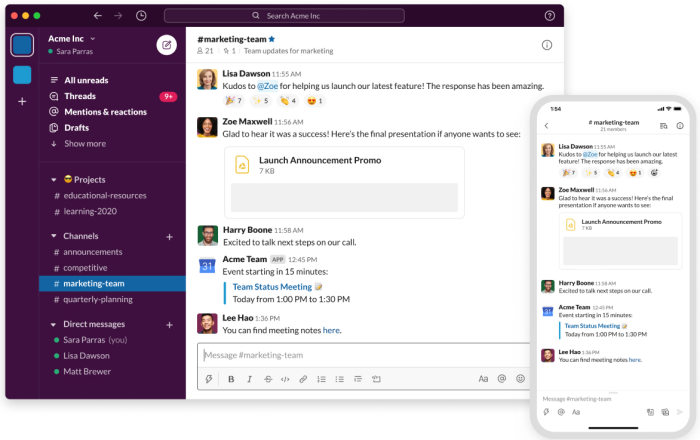
Miro is a collaborative mind-mapping software that can help teams brainstorm throughout the project lifecycle in real-time. The application functions as a virtual whiteboard for teams to map ideas, add digital sticky notes, and plan out timelines.
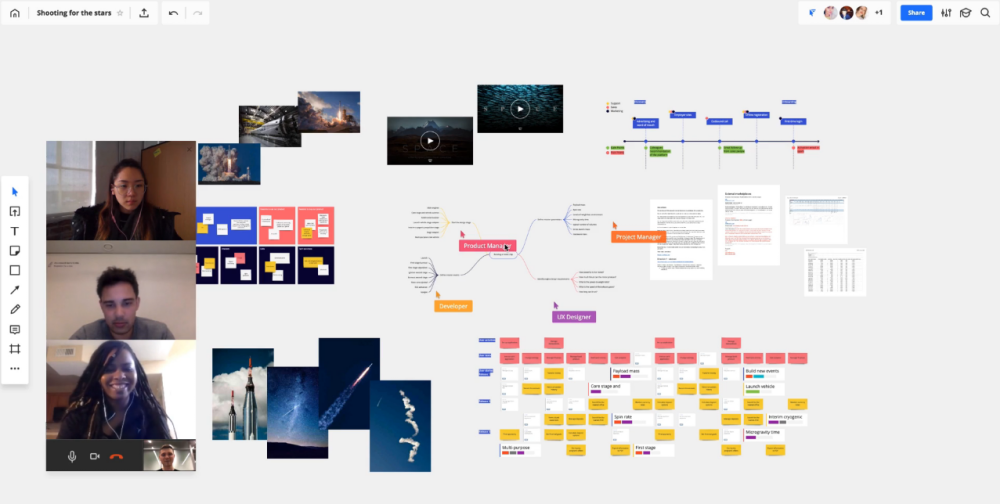
Read more: Best Collaboration Software & Tools in 2023
{{ title }}.
A project is a temporary, time-bound sequence of tasks that aim to achieve a particular goal. Projects bring together the talents of multiple team members in order to deliver a tangible result or outcome over a predetermined span of time. Often, projects involve the work of multiple individuals, across numerous areas of expertise, requiring an upfront investment in time and resources.
Project management provides structure and accountability to the project process while providing ongoing support to your team by way of a project manager. Here are just a few of the top benefits of project management:
Project Management Keeps Projects on Track
According to data from Wellingtone, only 43% of projects are finished on time and within budget, and only 29% are on time. Project management structures a plan for teams to stay on time and budget ahead of time, so projects are more likely to go as planned.
Eliminate Scope Creep
Scope creep occurs when project requirements and frame of work expand over time—and it’s one of the most significant threats to project success, with the Project Management Institute reporting that half of all projects experience scope creep. Projects that adhere to best practices in project management are more likely to stay focused on the initial objectives of the project and, ultimately, experience success.
Enhanced Resource Management
Project management involves planning and accountability—and that can make resource management much easier. During the initial phases of project planning, teams clearly outline team roles and responsibilities while monitoring individual workloads as work progresses, ensuring that resources are allocated appropriately.
Team Coaching and Coordination
Project management efforts are traditionally led by a project manager, or at the very least, a dedicated team member who oversees team efforts while providing support throughout the project lifecycle. Having a dedicated individual who can monitor project progress, troubleshoot problems, and promote team accountability can help the project process move much more smoothly.
While every organization’s approach to project management is different, taking stock of your goals can help guide your next move. Take time to reflect on the projects your team has completed previously. What went well? What could have been improved?
If you don’t have the budget to hire a dedicated project manager, implementing smaller steps, such as taking advantage of a project management software solution, can help your team make big strides toward a strong project management strategy.
Most teams will require a toolbox of project management aids, rather than a single solution by itself. In order to determine which tools are the best fit for your team, testing is key. A majority of project management software solutions offer free trials and plans, making it easy to test out a variety of options. Other tools, such as charts, planning aids, and mind maps, are free tools that can easily be tested and explored.
Interested in learning more? Check out our FREE guide on how to choose project management software.
Sign up for our emails and be the first to see helpful how-tos, insider tips & tricks, and a collection of templates & tools. Subscribe Now
You should also read

Creating Gantt Charts in Microsoft Project: Ultimate Guide

Project Executive: Roles, Responsibilities, and How to Become One

What Is Cost-Benefit Analysis: A Practical Guide
Join our newsletter.
Subscribe to Project Management Insider for best practices, reviews and resources.
By clicking the button you agree of the privacy policy

Get the Newsletter
You might also like.

83 Project Management Terms & Concepts to Know
What Is a Problem Statement & How to Effectively Create One
How to Hire the Best Project Manager

Want to create or adapt books like this? Learn more about how Pressbooks supports open publishing practices.
1 Project management methodologies: overview and definitions
Learning Outcomes
- Assess what constitutes project management methodologies.
- Determine the importance of methodologies in project management.
- Contextualise the various types of methodologies.
What exactly are methodologies in project management?
Methodologies for project management are a series of distinct processes that have been developed to offer assistance to project managers and team members. There are various definitions of a project management methodology but they all have the same grounding: it is a set of procedures, concepts, and regulations for managing a project to a successful end.
We would like to define it as: a collection of guiding principles and procedures for managing a project .
Project management methodologies describe the way we operate and communicate while managing projects. Methodologies are collections of guiding ideas and procedures that can be used to plan, manage, and execute projects. These methods of managing work are focused entirely on determining the most effective way to begin, plan, and carry out tasks. However, as a project manager, remember that your choice of approach for managing projects will impact how work is prioritised and how it is carried out.
When it comes to project management, using these methodologies serves 2 purposes: first, it expedites the completion of the duties associated with the project, and second, it provides solutions for dealing with problems as they appear. In addressing these two main purposes, the methodologies also guide the team through the entire project and provide them with steps to take and goals to work towards, while aiming to achieve the successful completion of the project.
Why use a project management methodology?
One of the most important objectives of a methodology is to standardise, structure, and organise the many methods within which the work is performed. This helps us to integrate all initiatives in the same way while offering us the capacity to reproduce successful components of the project. Well-adopted methodologies will also help us to learn from our previous errors, and ultimately lead us into a process of continuous improvement. Therefore, using a methodology can be a very helpful tool for developing project efficiency.
- Using a methodology in project management offers the opportunity for project managers to:
- better organise project life cycles
- adopt specific tools that allow for a precise time and cost estimation
- oversee and mitigate risks associated with the project
- improve the cost-benefit analysis of the project resources in a pragmatic way
- develop the team capabilities and competencies
In terms of resources, a methodology may help to speed up the learning curve of the project team, as it provides a well-established framework and structure for executing the project. When it is used in complex projects, methodologies can be adjusted and updated to be more in line with the individual working style of the team members as well as the strategic direction of the organisation. If a project manager selects a methodology that is acceptable and standardised, it is quite possible to improve the work performance while simultaneously lowering the need for extra resources to accommodate any changes triggered by the complexities of the project.
There is no doubt that the project team benefits from having access to a set of standards – a methodology that assists them to initiate and manage specific projects to a successful closure. Consequently, an effective methodology should have clear and transparent definitions, guidelines, and sample processes for the numerous project management activities that must be accomplished to execute successful projects. A project management methodology establishes a common basis for all the organisation’s activities. But most importantly, it establishes the grounds for success.
Project management methodologies offer the perfect planning framework to support the project throughout its life cycle. However, before attempting to implement a certain methodology style, it is necessary to have a thorough understanding of its benefits. Different project types require different management approaches. As a project manager, if you do not have a complete understanding of the benefits, you will be unable to maximise these effectively. Every methodology can be thought of as a reference framework, some of which are better suited to specific circumstances than others. Having the right methodology is critical. The right methodology adoption and implementation will assist project managers to lower or mitigate potential risks, prevent unnecessary duplication of tasks and activities, and eventually boost the overall outcome of the project. A methodology is a form of control mechanism that will enable and potentially ensure that the project closure is reached in the most efficient and effective way. Organisations that use a methodology in a disciplined, well-managed, and consistent manner will gain a competitive advantage and achieve consistent project success.
Figure 1. Project management methodologies support areas, by Carmen Reaiche and Samantha Papavasiliou, licensed under CC BY (Attribution) 4.0

Some of the benefits of having a project management methodology are shown above in Figure 1. But there are five significant advantages to using a project management methodology that we would like to focus on.
Advantage 1: Communication flow
When the project team members adhere to the same method, the communication channels and inclusive language become standardised. Because organisations often have many projects going at once, communication might become quite challenging. Having clear communication channels enables interaction and integration between various projects managers, allows team members and stakeholders to integrate their views, and helps sponsors to make decisions that are consistently sound and based on accessible information. Organisations should prioritise communication as an important goal and having a good methodology can support this goal.
Advantage 2: Control management
When project managers implement and run the right methodology, they are better equipped to monitor how the project and their management initiatives are progressing. A methodology provides a control system that enables project managers to monitor what is working well and what isn’t and determine whether objectives are meeting their maximum potential.
Methodologies are control management systems. When applied correctly, these systems act as governance tools that can guarantee that everything that is going on in the project life cycle can be easily identified, and that governance decisions are transparent and on time. In fact, project governance and monitoring make up a considerable portion of the components that comprise a project management methodology. They pave the way for project activities to progress in a manner that is not only organised but also easy to comprehend and communicate.
Advantage 3: Global competence
Tendering can be a complex process and in the globalised arena in which we live today it can be especially challenging for businesses to win contractual projects. The tendering process asks an organisation to respond to a formal request for the supply of goods, services and/or projects. Adhering to a consistent process can help an organisation win external contracts. In project management, there are a lot of bids that demand the use of specific methodologies. For example, in the engineering field there are many bids that list PRINCE2 as a prerequisite. In the public sector, tendering will require the application of Agile tools. Even if your role as project manager doesn’t require you to be involved in tendering or to participate in the bidding process of a contractual project, adopting a methodology (of any kind) is an essential component of good project management. It serves as a safeguard against everything that could possibly go wrong with projects and helps us to get back on track.
Advantage 4: Providing support during uncertain times
Methodologies can also assist project managers with overcoming the unknowns and uncertainties that are an inherent part of project management. With the support of procedures such as end-of-phase and gate reviews, it is possible for projects to transition from one stage to the next in a controlled and effective way. Without the proper control tools and methodology, many project managers would find it difficult to manage a project and access the information they need.
According to the literature (see, for example, Betts and Landsley 1995; Charvat 2003; Bondarenko 2017), the methodology capability of assisting with organising and structuring information is one of the main reasons why methodologies are important, particularly to project managers new to the trade. They provide supportive mechanisms that ensure that a project manager sticks to all the set protocols, follows the relevant processes, and obtains the required authorisations when required. These mechanisms are particularly useful and relevant in the face of uncertain events, ensuring that project managers do all the required tasks at the appropriate times. If project managers don’t have access to a set structure or guide, or lack instructions that might assist them, then they may be forced to access more management support to avoid managing their projects to failure.
Advantage 5: Mapping processes to success
Project managers with any level of expertise may benefit from methodologies that display a degree of flexibility as they provide the required level of support to aid efficiency and facilitate the project manager’s work. Methodologies can be very regimented, which means that they do not provide a great deal of room for deviations. To some project managers, this could be a disadvantage as it can restrict creativity. However, a well-structured methodology is more likely to guarantee successful project completion. Distinctions between the steps of the process can enable users to divide tasks more quickly and minimise errors that would otherwise be impossible to manage. Because of a methodology’s rigidity, project managers are required to pay meticulous attention to each stage, which in turn results in an automatically improved, controlled approach to the final outcome of the project.
Disadvantages
From a practitioner’s perspective we could extend the list of advantages presented above; however, it is also important to highlight some of the disadvantages that are prevalent when a project management methodology is adopted. The advantages of having a methodology are very encouraging, but there is some research that suggests that methodologies provide no value to projects (see, for example, Bondarenko et al. 2018; Perrin 2018). The lack of value is seen in scenarios where project managers are experts in the field of the project, have extensive expertise in managing complex large projects, and have a clear understanding of the organisation’s strategy. Methodologies have been proven to be effective in situations where they replace and/or complement project managers who lack the necessary expertise and skills, and this has generated a misconception that it is the only value they bring to projects. However, we should acknowledge that, when it comes to mid-level, experienced project managers who have an average amount of experience and accountability, there is also a point in the middle of managing a project, where the benefits of using a methodology begin to diminish.
Another disadvantage that we have seen is the disconnection that sometimes exists between what project managers believe to be of value for the project and what the organisation believes to be beneficial on a strategic level. Therefore, it is critical to establish a good communication system between all stakeholders and have everyone on the same level of understanding when implementing a methodology.
Methods aren’t flawless, but they do offer a lot of benefits to the individual project manager as well as the organisation. There are many different routes that can be taken to successfully implement a methodology and complete a project. The best and most popular approaches, strategies, and frameworks are always evolving so we cannot suggest a single example for you to adopt. Behind any successfully completed project is a plethora of different strategies, methodologies, and procedures. In fact, you will most likely have the opportunity to make use of more than one of them during your project management career.
In this book, we will discuss some of the key methodologies, as well as specific components of these methodologies, that you may apply in practice in order to successfully deliver projects to completion. Table 1 lists some of these key project management methodologies and provides a brief explanation of the techniques that will be covered in the next modules.
Table 1. Project management methodologies groups, by Carmen Reaiche and Samantha Papavasiliou, licensed under CC BY (Attribution) 4.0
In sum, the various methodologies, strategies, and frameworks available to project managers are also useful to others. Figure 2 below shows a few guidelines for adopting a new methodology, but keep in mind that there is no one-size-fits-all framework. As discussed earlier, the whole team working on the project will benefit from these as they will need a tool to help them gain a solid grasp of the project objectives and maximise the project’s and organisation’s resources. The right methodology will help the team achieve these. Irrespective of the methodology option you select, the processes embedded under each methodology will ensure that the rest of the project requirements and procedures are carried out without a glitch. Keep in mind that there is no such thing as a standard organisation strategy, typical project or team members – each of these are unique to the environment in which they and the project operates and resides. Therefore, each methodology must be understood and applied accordingly. Keep in mind that it is also possible that you will not find success using a methodology or an approach that has been successful for someone else. Because of this, we highly recommend that you try multiple methodologies and forecast in which way you might use these effectively for each of your unique projects.
Figure 2. A project management methodology roadmap adoption, by Carmen Reaiche and Samantha Papavasiliou, licensed under CC BY (Attribution) 4.0
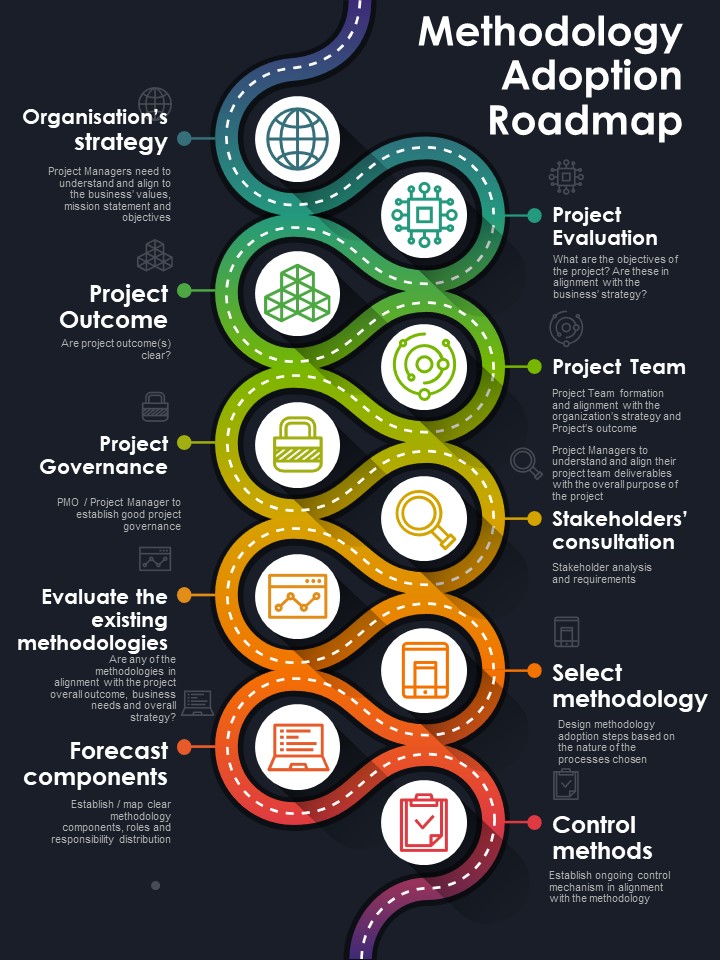
Test your knowledge
Key Takeaways
- As a project manager, aim to establish a productive culture for project management which will enable you and your team to employ a project management methodology in an efficient manner.
- Enhance the abilities of your project team members and provide them with a comprehensive understanding as well as a stable basis so that they may effectively manage their projects.
- A methodology should facilitate the clarification of goals and the scope of the project by integrating the organisation’s strategy and best practices of all project management group processes.
Betts M and Lansley P (1995) ‘ International Journal of Project Management : a review of the first ten years’, International Journal of Project Management , 13(4):207–217.
Bondarenko S (2017) ‘Synergetic management as a management technology of enterprise innovative development’, Journal of Applied Management and Investments , 6(4): 223–230.
Bondarenko S, Lagodienko V, Sedikova I and Kalaman O (2018) ‘Application of project analysis software in project management in the pre-investment phase’, Journal of Mechanical Engineering and Technology , 9(13):676–684.
Charvat J (2003) Project management methodologies: selecting, implementing and supporting methodologies and processes for projects , John Wiley & Sons.
Perrin JM (2018) ‘The best-laid plans of mice and men often go awry: the disadvantages of project management’, Project Management in the Library Workplace ( Advances in Library Administration and Organization, Vol. 38 ), Emerald Publishing Limited, Bingley, 71–88.
Management Methods for Complex Projects Copyright © 2022 by Carmen Reaiche and Samantha Papavasiliou is licensed under a Creative Commons Attribution 4.0 International License , except where otherwise noted.
- Project Management Methodologies
Project Management Methodologies: Definition and Examples
Project management is a complex business process that involves planning and allocating resources, executing tasks, and achieving a predefined goal. The constantly changing project management field is fluid; it varies depending on the methodology, industry, or project manager themselves.
From HR to IT, sales, and marketing, teams across businesses and industries consistently rely on project management methodologies to forge and deliver outstanding results. Yet, the project management methodology landscape can seem vast and overwhelming, especially if you are new in this position.
As a project manager, you must decide which project management methodology ensures the most efficient use of your team’s resources, skills, and time. Finding the proper project management methodology is not rocket science.
Reading our guide and learning more about project management methodologies brings you closer to becoming a successful project manager.
TABLE OF CONTENT
- Definition of Project Management Methodology
- Critical Path Method
- Critical Chain Project Management
- How to choose the proper Project Management methodology
- Bottom line
I. The definition of Project Management Methodology
A project management methodology combines principles, techniques, practices, and tools and ensures you plan, execute, monitor, and complete a project.
As projects differ depending on their goals, teams, KPIs, and operating methods, several approaches to managing them properly exist.
While a methodology can be excellent for a team, it can become a nightmare for another.
When a traditional project management methodology became obsolete and hindering rather than helping, teams needed to adapt and develop new methods to address their concerns. Soon, other teams and industries started implementing and adapting these new methods.
This ever-evolving process has led to a wide range of various project management methodologies to choose from.
Project managers must learn about project management methodologies to identify the one that tailors their teams' needs and ensures the project's successful implementation.
II. Top Project Management Methodologies
While numerous approaches exist, the following ten project management technologies are the most well-known.
1. Waterfall methodology - the traditional approach
What is it?
The Waterfall methodology emphasizes a straightforward project progression from beginning to end.
The project is well-defined and split into several dependent stages of execution. The outcomes of each phase “cascade” on the following one, like water falling on the rocks. When using this methodology, you must complete a step before moving on to the next one.
Once the team chooses the Waterfall methodology, it must define the actions based on the methodology sequences:
- Requirements
- Implementation
- Verification & Testing
- Deployment & Maintenance
When to use it?
The Waterfall method is excellent for large projects, with little to no variations and a clearly defined and solid goal. This approach is highly efficient in manufacturing and construction projects.
Who should use it?
Due to its sequential and detail-oriented nature, the Waterfall methodology works for large projects involving multiple clients and stakeholders, predictable costs, and fixed milestones. This linear approach promotes collaboration, improves communication, and helps teams focus on the tasks.
2. Agile - one of the most commonly used frameworks
The Agile project management methodology is a set of principles that focus on speed, agility, collaboration, and flexibility. It was developed in response to growing discontent with the rigidity and limitations of the traditional waterfall approach.
In our dynamic business environment, teams and companies must quickly adapt to changes, customers, and technologies. The Agile design emphasizes collaboration, encourages feedback, and allows teams to incorporate changes to the work in progress instead of waiting until the end to review and implement the amends.
The lifecycle of Agile methodology consists of five stages:
- Development
The main advantage of the Agile methodology is its adaptability, which makes it the perfect choice for teams in the software development industry. Working in short sprints (2-3 weeks) allows employees to revise, recalibrate, and improve their projects while they are ongoing.
Due to its versatility, the Agile methodology is highly effective for teams working on projects where some details are unknown from the onset or might evolve during project development. It is also valuable when working on projects involving regular customer feedback. When time-to-market is crucial, the Agile methodology enables teams to deliver excellent outcomes quickly.
3. Scrum - the most used type of Agile methodology
Scrum methodology is more of an Agile framework than a methodology in itself. It encompasses the Agile principles and implements them in small teams (no more than ten employees), working on short sprints (usually one week).
The project team holds daily Scrum meetings led by a Scrum master (not the same person as the project manager). After each sprint, the team reviews their progress in a “retrospective meeting” and makes any necessary adjustments.
Here are the main steps that make the Scrum methodology effective:
- Sprint planning
- Daily Scrum
- Sprint review
- Sprint retrospective.
While it is used extensively by teams and organizations across all industries, the Scrum framework is highly effective for projects with variable outputs, unknown solutions, frequent and faster product delivery, and regular interactions with clients or end-users.
The term scrub comes from rugby and refers to the players gathered on the field during the match to make strategic decisions to win the game. In the business environment, this method is more prevalent within small software development and engineering teams.
4. Kanban - the visual overview of the project execution
The Kanban project management methodology is a physical or digital representation of the Agile principles.
This Agile framework allows teams to visualize their progress in real-time, improve workflow, reduce waste of time and material, and maximize efficiency.
Kanban combines two Japanese words: kan - meaning sign, and ban - meaning board. The signboard was developed by an engineer working for Toyota in the late 1940s.
A comprehensive Kanban board has the following key components:
- Work-in-progress (WIP) limits
For many years, Kanban was very popular in the automotive industry. Due to its efficiency, IT managers and software development teams embrace this methodology.
The ability to change throughout the project makes Kanban particularly efficient for businesses with a continuous and constant flow, such as marketing and publishing.
The Kanban methodology works best for stand-alone teams working on projects without too many tasks or resource dependencies.
The Kanban framework is used at a large scale by teams who adopt Lean and Agile as the boards ensure the visibility and transparency necessary to secure business agility.
5. Lean - deliver more value with fewer resources
The Lean project methodology emphasizes continuous improvement of the company’s workforce, resources, and efforts to optimize customer value while reducing waste of time and energy.
We know that lean in the food industry refers to poultry and fish: healthier meats with less fat. In business and project management , Lean refers to a method that removes faults and defects during every phase, which keeps the project healthier.
Like Kaban, the Lean methodology comes from a Japanese engineer who created the Toyota Production System (TPS). TPS inspired John Krafcik, who introduced the Lean approach to project management.
Each principle of the Lean methodology aims to reduce waste while staying within the project scope and reaching customer satisfaction:
- Define value
- Map the value stream
- Develop a continuous flow
- Create a pull system
- Enable continuous improvement.
The Lean approach is highly effective for small teams working on software development and manufacturing products within a short time frame. This framework also helps growing businesses refine their processes and resources to produce high-quality outcomes with minimum waste.
Initially used in manufacturing physical products, the Lean methodology is widely adopted for process improvement in all sectors, from retail, healthcare, and education to software development, services, logistics, construction, and maintenance.
6. Scrumban - the hybrid project management methodology
The Scrumban methodology extracts the best features of Scrum and Kanban frameworks and combines them into a hybrid project management approach.
Originally designed as a transition phase from Scrum to Kanban, the Scrumban methodology has evolved into a mature and flexible framework.
The main benefit of this new method is that it incorporates the work-in-progress limits (from Kanban) into the projects’ sprints (from Scrum). The result is a flexible method that ensures flow continuity while incorporating project planning and revising. It allows teams to manage projects of any size.
The Scrumban process consists of the following steps:
- Create the Scrumban board
- Establish the work-in-progress limits
- Prioritize the project and tasks
- Set and hold daily meetings
The Scrumban method ensures a consistent flow when working on long-term or ongoing projects with no set deadline.
Scrumban is perfect for teams that prefer to split large projects into smaller parts using simple yet effective visual representations.
7. PRINCE2 - Projects In Controlled Environments methodology
The PRINCE2 project management framework, as its name states it (Projects In Controlled Environments), focuses on organization and control throughout every project stage. This linear and process-based methodology starts with an elaborate project plan and definition of each phase.
This method emerged in 1989 from the UK’s government methodology: the Project Resource Organization Management Planning Technique (PROMPT).
Initially used for managing IT projects, PRINCE became popular among teams working on any project. So, in 1996, PRINCE2 was launched.
PRINCE2 has seven steps guiding a team from initiation to project closure, as follows:
- Starting up the project
- Initiating a project
- Controlling
- Managing product delivery
- Managing stage boundaries
- Closing the project
The PRINCE2 methodology is best fitted for large projects involving many stakeholders.
Due to its simple yet clear-structured process, PRINCE2 is an excellent method for teams new to managing projects.
8. Six Sigma - more a philosophy than a methodology
The Six Sigma approach is used for quality management and helps companies identify the root causes of complex issues.
The Six Sigma project management methodology is a quality improvement framework that helps enterprises enhance their performance while reducing the rate of errors arising from process variations.
Motorola first used the Six Sigma methodology in 1986, and General Motors later embraced it. The methodology consists of five data-driven stages (DMAIC).
The Six Sigma methodology is highly efficient for projects involving complex processes with many variables.
Six Sigma is best suited for large enterprises with over 100 employees operating across all industries.
9. Critical Path Method - the amplest step-by-step project plan
The Critical Path Method (CPM) represents a project management methodology that allows teams to identify, analyze, plan, and schedule tasks crucial for project closure.
The Critical Path Method is a roadmap that helps teams visualize the critical steps toward the end goal. It occurred in the late 1950s as a solution to reduce costs resulting from inefficient scheduling.
There are six CPM steps:
- Identify each activity
- Define the activity sequence
- Create the Critical Path Analysis Chart
- Estimate completion time for each activity
- Define the Critical Path
- Update the Critical Path
The Critical Path Method is an excellent tool for teams managing complex projects with numerous dependencies.
The Critical Path Method is best suited for small and mid-sized teams.
10. Critical Chain Project Management - a more detailed CPM
The Critical Chain Project Management methodology focuses on project success while emphasizing the efficient use of resources (people and materials).
The Critical Chain Project Management framework uses a structure similar to the Critical Path Method. In addition, CCPM includes time requirements for completing each task. This feature allows project managers to track activities and see which tasks exceed their allotted time.
Here are the key steps to follow when using the CCPM methodology:
- Identify the Critical path
- Determine the amount of resources necessary to create the critical chain
- Create and insert buffers
- Establish a detailed project model
- Keep team members focused and eliminate multitasking
- Track the project
The CCPM methodology solves the efficiency problems of large and complex projects.
Due to its detailed structure, the Critical Chain Project Management framework is excellent for all types of teams.
III. How to choose the proper Project Management methodology
Any team that works on a project basis and yearns for success should master the art of planning, managing, and completing projects. Choosing the suitable project management methodology is crucial for keeping your team members focused and motivated to achieve consistent results throughout the project.
Before deciding which methodology to implement in your organization, you must carefully consider the following factors:
The project’s needs
Collect data about the resources required to complete the project. Knowing the project's needs initially helps determine which project management methodology meets your specifications best. Gather information about the following:
- Team structure
- Project complexity and objectives
- Customer details
- Flexibility
- Constraints
- Roles of team members and collaboration
- Stakeholders .
The project’s key variables
Once you learn the permissions and limits of the project, you can determine which variables impact your project. By doing so, you can establish your priorities and and choose the project management technique that fits them best.
Create a comparison chart
Identify the most relevant project management methodologies that fit within your resources and variables. Craft a list of pros and cons, compare the methods to the project, and make a data-driven decision.
Assess the risks and rewards
The following phase of choosing the best project management methodology is to estimate the possible risks and success rates for each approach. You should implement the method with the highest success rates and minimum risks.
IV. Bottom line
In the current fast-paced business environment, it is critical to bring different teams and departments to work together towards the same goal: a thriving company.
By understanding the purpose of project management and learning the principles of project management methodologies, you are closer to choosing the best framework for your team.
There is no one-size-fits-all project management methodology. While a method may work for a team or company, it may be a nightmare for others. Thus, you must first assess the risks, challenges, weaknesses, and strengths and then select the best methodology (or a hybrid approach).
- Skip to primary navigation
- Skip to main content
- Skip to primary sidebar
- Skip to footer

Stay Informed Group
Stay informed with opportunities online
Project Management Methodologies: Definition, Types and Examples
February 3, 2024 by Bassey James Leave a Comment
Embarking on a business administration career or currently enrolled in a business program? Knowing different project management methodologies can make your journey smoother. These methods not only save time but also enhance your ability to handle work projects successfully. In this guide, we’ll explore diverse project management approaches, enabling you to select the one that suits you best.
Understanding project management methodologies is crucial for those aiming for a career in business administration or currently enrolled in a business program. It’s about more than just completing projects; it’s about doing it efficiently. By learning these methods, you not only save time but also ensure your work-related projects are executed effectively. Let’s delve into the various project management methods to assist you in choosing the one that aligns with your preferences and goals.
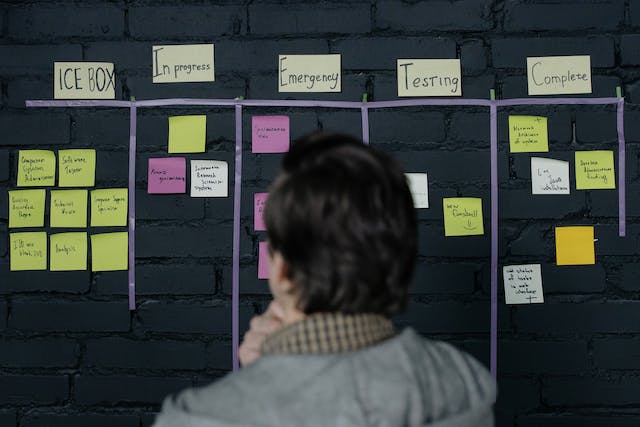
Essential Aspects of Project Management
Project management involves five crucial elements that contribute to its success. These key components ensure that a project is well-planned, executed efficiently, monitored effectively, risks are managed, and communication is maintained throughout. Here’s a breakdown of these essential elements:
1. Planning: The first step in project management is creating a detailed plan. This plan should cover the project’s scope, objectives, timelines, resources, and budget. It’s important to regularly update and review the plan to make sure the project stays on course.
2. Execution: Once the plan is in place, the next phase involves putting it into action. Project managers need to oversee the completion of various tasks outlined in the plan to ensure the project progresses as intended.
3. Monitoring and Control: Project managers play a critical role in tracking the project’s progress. They need to identify any issues that arise and make necessary adjustments to keep everything on track. Key performance indicators (KPIs) are valuable tools for monitoring and controlling the project.
4. Risk Management: Most projects face uncertainties, and effective project management involves identifying and mitigating risks. By addressing potential issues before they escalate, project managers can safeguard the project’s success.
5. Communication: Open communication is vital throughout the project. Project managers should regularly update stakeholders on the project’s progress, fostering a collaborative environment and ensuring everyone is well-informed.
By focusing on these five fundamental elements, project managers enhance the likelihood of successfully completing projects, meeting objectives, and satisfying stakeholders.
Project Management Methodologies
1. waterfall method.
Many students and project managers seek a simple, step-by-step approach to managing their projects. If you’re someone who likes clear and direct methods, the waterfall methodology could be just what you need. The term “waterfall” itself hints at the process’s downward flow, where each phase is started and finished before moving on to the next. This approach is particularly effective for projects in manufacturing and construction. It can also be handy for students and researchers gathering and analyzing data for academic purposes.
The waterfall methodology is one of the project management methodologies where you need to follow a set path, ensuring each stage is completed before advancing to the next. This organized structure makes it easier to track progress and minimizes the chances of things getting too complicated. Whether you’re constructing a building or conducting academic research, the waterfall methodology provides a systematic way to move through your project, making it an excellent choice for those who prefer a straightforward and linear project management approach.
Also Read: 30 Micromanagement Quotes and Their Explanation
2. Critical Path Method (CPM)
The Critical Path Method (CPM) is a useful project management tool that helps managers understand and plan tasks in a project. It enables them to identify all the tasks and figure out how flexible the schedule is for each one. With CPM, managers create the critical path, which is the longest sequence of tasks necessary to complete the project on time.
This method is particularly effective for smaller to medium-sized projects. It simplifies the process of organizing and scheduling tasks, providing a clear roadmap for the project timeline. By focusing on the critical path, managers can prioritize tasks and ensure that the project stays on schedule.
In essence, the Critical Path Method streamlines project management by offering a straightforward approach to task planning and scheduling. It is a valuable tool for ensuring efficient and timely project completion, especially in the context of smaller and medium-sized endeavours.
3. Agile Methodology
In teamwork, the agile methodology is a useful way to reach the main goals of a project. Agile focuses on working together, being flexible, and making sure the customer is happy. This helps in changing plans and getting better at different stages. Usually, people following this method divide the project into smaller parts called sprints. They then use constant feedback to make the product better.
Agile is like a helpful guide for teams. It shows them how to work well together and be ready for changes. Imagine you’re on a journey, and instead of planning the whole trip at once, you plan it bit by bit. This way, if something unexpected happens, you can adjust your plans easily.
With agile, teams can be more creative and make things better step by step. It’s like building a puzzle. You start with small pieces, put them together, and soon you have the complete picture. The agile method is like putting the project’s puzzle together, one piece at a time, to make sure everything fits just right.
4. Scrum Methodology
The Scrum method is a way of managing projects that follows some of the key ideas of agile approaches. Similar to the agile method, Scrum puts a strong emphasis on teamwork and collaboration. Just like in agile, people using Scrum break down the different tasks in a project into smaller, more manageable parts. However, Scrum is designed for smaller teams, typically consisting of up to ten members.
In Scrum, these teams arrange brief meetings, known as scrum meetings, either on a daily or weekly basis to evaluate how well they are advancing with their work. These meetings help team members stay on the same page and address any challenges they might be facing. By adopting the Scrum methodology, teams aim to improve communication, enhance flexibility, and efficiently deliver project outcomes.
5. Kanban Methodology
The Kanban methodology is perfect for projects that need a clear picture. With this method, project managers can see all the tasks in the project and organize how the work should flow. They use cards or sticky notes to follow how each phase is progressing. Kanban’s visual approach is great for getting rid of any problems or wasted efforts in the project.
Instead of a complicated process, Kanban keeps things straightforward. It’s like having a board with cards for each task, and you can move them around to show where things are. This way, everyone on the team knows what needs to be done and what’s already finished. It’s a simple but powerful way to manage projects and make sure everything runs smoothly.
6. PRINCE2 Methodology
The PRINCE2 methodology is a helpful tool for managing projects where each phase needs approval before moving on to the next. Users of this method break down the project into stages, and each stage might need approval before progressing. Before starting the next phase, stakeholders are consulted and their approval is obtained.
In simpler terms, PRINCE2 is a way of organizing and managing projects step by step. Imagine building a house – you wouldn’t start putting up walls before making sure the foundation is solid, right? PRINCE2 follows a similar logic for any project. It divides the whole project into smaller parts, making sure everything is approved and good to go before moving forward. This helps keep things organized and makes sure everyone involved, like the people funding the project and those doing the work, agree on each step.
So, if you want a clear and organized way to manage your projects, PRINCE2 is a great choice among other project management methodologies. It’s like having a roadmap – you know where you’re going, and you make sure everyone is on board before moving to the next stop.
Also Read: 100 Positive Qualities Examples
Different Types of Project Management Styles
Project management involves different approaches to effectively handle tasks and achieve goals. Here are four types of project management:
Traditional Project Management
Traditional project management is an old-fashioned way of working on projects. In this method, tasks are done one after the other in a specific order. It’s similar to following steps in a recipe. People use this method to make sure each task is finished before starting the next one. It’s like building a house where you lay the foundation before putting up the walls.
This approach focuses a lot on planning and keeping records. It means everything has to be carefully thought out and written down before starting. This can limit the project because it has to stick to the plan, even if things change.
Overall, traditional project management is about doing things in a set order and making sure everything is planned out and documented before getting started.
Agile Project Management
Agile Project Management is a way of working together on projects. It helps create a team spirit in managing projects. Instead of doing everything at once, Agile breaks tasks into smaller parts. These smaller parts are then given to different team members to work on. This makes it easier to handle and complete the tasks.
In traditional project management, everything is planned at the beginning, and the plan is followed step by step. But in Agile, the plan can change as the project progresses. It allows for flexibility and adjustment based on what’s happening during the project.
Agile is like building with Lego bricks. Each team member gets a specific Lego piece (task), and together they build the project. If they need to change something, they can easily rearrange the Lego pieces. This way, the team can adapt and make improvements throughout the project. Agile is a more flexible and collaborative way of managing projects.
Learn Project Management
In the world of lean project management, the main goal is to cut out unnecessary steps and boost productivity. This approach involves using data to make smart decisions and always finding ways to make processes smoother, minimizing waste and saving money.
Lean project management is all about doing things in the most efficient way possible. Managers in this system work hard to remove any unnecessary parts of a project that don’t add value. They use data to guide their choices and are always looking for ways to make things simpler and less wasteful.
Continuous improvement is a key part of lean project management. Instead of sticking to the same old ways of doing things, managers are always on the lookout for better methods. By focusing on efficiency and cutting out waste, lean project management helps teams work smarter, not harder. The result is a streamlined process that gets the job done faster and with fewer resources.
Hybrid Project Management
Hybrid project management is a method that takes the best aspects from various approaches and puts them together to make a personalized approach. People who use this method can mix the step-by-step way of the waterfall with the teamwork focus of agile to address specific needs.
In simple terms, hybrid project management is like creating a special recipe by picking the tastiest ingredients from different dishes. Imagine making a cake where you choose the best parts of a chocolate recipe and combine them with the delicious elements of a vanilla recipe. Similarly, hybrid project management combines the strengths of different project management styles to make a unique and effective approach.
For example, it takes the structured and organized nature of the waterfall approach and blends it with the flexibility and collaboration of the agile approach. This way, teams can work together smoothly and follow a clear plan at the same time. Hybrid project management is all about finding the right mix to achieve success in a way that suits the specific requirements of a project.
Also Read: 6 Ageism Examples
Project Management Life Cycle Models
Project management involves using different approaches to guide a project from its initiation to completion. There are five main project cycle models that can be used for this purpose. In the earlier parts of this article, we explored the first two models: the waterfall model and the agile model. Now, let’s delve into the remaining three models:
- V-Model: This model is a variation of the waterfall model. It follows a step-by-step approach to completing a project but introduces a testing phase after each task before moving on to the next. This ensures that each component is thoroughly tested before progressing further.
- Spiral Model: Combining elements of both the waterfall and agile models, the spiral model enables managers to divide the project into smaller tasks that follow a specific sequence. This iterative approach allows for flexibility and adjustments as needed throughout the project’s life cycle.
- Hybrid Model: The hybrid model provides flexibility by allowing managers to tailor their approach to a project’s unique requirements. In the case of the high hybrid model, elements from all the other models can be incorporated to address specific project needs effectively.
Project Management Journey
Every project goes through a journey that involves four main steps before it is ready for the owners or stakeholders. Let’s explore each step:
1. Starting the Project: The first phase is called the initiation phase. This is where the project begins, with the idea taking shape. During this stage, the project’s goals, scope, and limitations are defined.
2. Planning for Success: Next comes the planning phase. Here, the project’s scope and budget are carefully outlined. Think of it as creating a roadmap for the project to follow. This step ensures everyone knows what needs to be done and how much it will cost.
3. Getting Things Done: The execution phase is where the actual work happens. This is when the plans from the previous phases are put into action. It’s like the construction phase of building a house – the builders start building based on the architect’s plans.
4. Wrapping it Up: The last phase is the closure phase. This is when the completed project is handed over to the stakeholders. It’s like finishing a book and passing it to someone else to read – the project is completed, and now it’s time for others to benefit from the hard work.
About Bassey James
Bassey Chimezirim James is an ardent writer who has written for top education and tech websites, which includes the likes of World Scholarship Forum, After School Africa, Gadget Wrights, etc. James is a public speaker; a graduate of Physics and the Team for the http://stayinformedgroup.com/ Project.
Reader Interactions
Leave a reply cancel reply.
Your email address will not be published. Required fields are marked *
Save my name, email, and website in this browser for the next time I comment.
Top 10 Marketable Careers in the World in 2024
What are the best architecture schools in the us, 15 best psychology schools in the world 2024, what are the best exercise science schools, 10 best medical schools in mexico in 2024, student loan forgiveness: how to obtain a student loan forgiveness, what are the 14 punctuation marks for effective english writing, top rated universities in canada with the highest acceptance rate, reasons why is education important all you need to know, most important languages to learn for more opportunities, top tips for first-year students, 10 tips to choosing an online college, 100 positive affirmations for students, 5 universities in cambridge massachusetts ma, 25 cheapest universities in usa for international students, medical schools admission requirements: all you need to get admitted, 5 ai-based paraphrasing tools to improve your writing skills as a student, list of the cheapest universities in australia for international students, 20 top rated cheapest universities in germany for international students, 15 best schools for architecture in the world, how many nickels make a dollar all you need to know, highest paid military in the world in 2024 (top 10 countries), how to record a meeting on microsoft teams, 32 best work from home companies that are legit, 15 google meet ideas for teachers, 25 short term courses with high salary, career opportunities for bcom students, how to become a pilot with or without a degree, how to become a home inspector, is a master’s in information technology worth it, how to build a career in digital marketing, is an online associate degree in health science for you, how to become a video game designer, what is a business lawyer, how to capitalize job titles, career development plan: how to create a career plan, what does a film producer do, how to become a medical writer, how to become a music producer without school, 20 high paying part time jobs, motivation letter for job application example 2024.
- Product overview
- All features
- App integrations
CAPABILITIES
- project icon Project management
- Project views
- Custom fields
- Status updates
- goal icon Goals and reporting
- Reporting dashboards
- workflow icon Workflows and automation
- portfolio icon Resource management
- Time tracking
- my-task icon Admin and security
- Admin console
- asana-intelligence icon Asana Intelligence
- list icon Personal
- premium icon Starter
- briefcase icon Advanced
- Goal management
- Organizational planning
- Campaign management
- Creative production
- Content calendars
- Marketing strategic planning
- Resource planning
- Project intake
- Product launches
- Employee onboarding
- View all uses arrow-right icon
- Project plans
- Team goals & objectives
- Team continuity
- Meeting agenda
- View all templates arrow-right icon
- Work management resources Discover best practices, watch webinars, get insights
- What's new Learn about the latest and greatest from Asana
- Customer stories See how the world's best organizations drive work innovation with Asana
- Help Center Get lots of tips, tricks, and advice to get the most from Asana
- Asana Academy Sign up for interactive courses and webinars to learn Asana
- Developers Learn more about building apps on the Asana platform
- Community programs Connect with and learn from Asana customers around the world
- Events Find out about upcoming events near you
- Partners Learn more about our partner programs
- Support Need help? Contact the Asana support team
- Asana for nonprofits Get more information on our nonprofit discount program, and apply.
Featured Reads

- What is Agile methodology? (A beginner’ ...
What is Agile methodology? (A beginner’s guide)

Agile methodology is a project management framework that breaks projects down into several dynamic phases, commonly known as sprints. In this article, get a high-level overview of Agile project management, plus a few common frameworks to choose the right one for your team.
Scrum, Kanban, waterfall, Agile.
Agile project management isn’t just useful for software project management—all types of teams have been successful with this dynamic methodology. If you’re looking to get started with Agile, you’ve come to the right place.
What is the Agile methodology?
Agile methodology is a project management framework that breaks projects down into several dynamic phases, commonly known as sprints.
The Agile framework is an iterative methodology . After every sprint, teams reflect and look back to see if there was anything that could be improved so they can adjust their strategy for the next sprint.
![project management methodology definition types examples [inline illustration] Agile methodology (infographic)](https://assets.asana.biz/transform/f3519623-44e4-4506-8e1f-38cb74819c58/inline-agile-agile-methodology-1-2x?io=transform:fill,width:2560&format=webp)
What is the Agile Manifesto?
The Agile Manifesto is a document that focuses on four values and 12 principles for Agile software development. It was published in February 2001 by 17 software developers who needed an alternative to the more linear product development process .
What are the 4 pillars of Agile?
As outlined in the Agile Manifesto, there are four main values of Agile project management:
Individuals over processes and tools: Agile teams value team collaboration and teamwork over working independently and doing things "by the book.”
Working software over comprehensive documentation: The software that Agile teams develop should work. Additional work, like documentation, is not as important as developing good software.
Customer collaboration over contract negotiation: Customers are extremely important within the Agile methodology. Agile teams allow customers to guide where the software should go. Therefore, customer collaboration is more important than the finer details of contract negotiation.
Responding to change over following a plan: One of the major benefits of Agile project management is that it allows teams to be flexible. This framework allows for teams to quickly shift strategies and workflows without derailing an entire project.
What are the 12 Agile principles?
The four values of Agile are the pillars of Agile methodology. From those values, the team developed 12 principles.
If the four values of Agile are the weight-bearing pillars of a house, then these 12 principles are the rooms you can build within that house. These principles can be easily adapted to fit the needs of your team.
The 12 principles used in Agile methodology are:
Satisfy customers through early, continuous improvement and delivery. When customers receive new updates regularly, they're more likely to see the changes they want within the product. This leads to happier, more satisfied customers—and more recurring revenue.
Welcome changing requirements, even late in the project. The Agile framework is all about adaptability. In iterative processes like Agile, being inflexible causes more harm than good.
Deliver value frequently. Similar to principle #1, delivering value to your customers or stakeholders frequently makes it less likely for them to churn.
Break the silos of your projects. Collaboration is key in the Agile framework. The goal is for people to break out of their own individual projects and collaborate together more frequently .
Build projects around motivated individuals. Agile works best when teams are committed and actively working to achieve a goal.
The most effective way to communicate is face-to-face. If you’re working on a distributed team, spend time communicating in ways that involve face-to-face communication like Zoom calls.
Working software is the primary measure of progress. The most important thing that teams should strive for with the Agile framework is the product. The goal here is to prioritize functional software over everything else.
Maintain a sustainable working pace. Some aspects of Agile can be fast-paced, but it shouldn't be so fast that team members burn out . The goal is to maintain sustainability throughout the project.
Continuous excellence enhances agility . If the team develops excellent code in one sprint, they can continue to build off of it the next. Continually creating great work allows teams to move faster in the future.
Simplicity is essential. Sometimes the simplest solution is the best solution. Agile aims to not overcomplicate things and find simple answers to complex problems.
Self-organizing teams generate the most value. Similar to principle #5, proactive teams become valuable assets to the company as they strive to deliver value.
Regularly reflect and adjust your way of work to boost effectiveness . Retrospective meetings are a common Agile practice. It's a dedicated time for teams to look back and reflect on their performance and adapt their behaviors for the future.
What are the benefits of the Agile development methodology?
You commonly find Agile project management used in application development or other types of software development. This is because software is constantly changing, and the needs of the product have to change with it.
Because of this, linear project management methods like the waterfall model are less effective. Here are a few other reasons why teams use Agile:
Agile methods are adaptable
There's a reason why they call it the Agile methodology. One of the main benefits of using Agile processes in software development is the ability to shift strategies quickly, without disrupting the flow of a project.
Because phases in the traditional waterfall method flow into one another, shifting strategies is challenging and can disrupt the rest of the project roadmap . Since software development is a much more adaptable field, project managing rapid changes in the traditional sense can be challenging. This is part of the reason why Agile project management is favored in software development.
Agile fosters collaborative teamwork
One of the Agile principles states that the most effective way to communicate with your team is face-to-face. Combine this with the principle that encourages teams to break project silos and you have a recipe for collaborative teamwork.
While technology has changed since Agile’s inception and work has shifted to welcome more remote-friendly policies, the idea of working face-to-face still hasn't changed.
Agile methods focus on customer needs
One of the unique aspects of software development is that teams can focus on customer needs much more closely than other industries. With the rise of cloud-based software, teams can get feedback from their actual customers quickly.
Since customer satisfaction is a key driver for software development, it’s easy to see why it was included in the Agile process. By collaborating with customers, Agile teams can prioritize features that focus on customer needs. When those needs change, teams can take an Agile approach and shift to a different project.
Agile methodologies
The Agile framework is an umbrella for several different variations. Here are a few of the most common Agile methodologies.
Kanban is a visual approach to Agile. Teams use online Kanban board tools to represent where certain tasks are in the development process. Tasks are represented by cards on a board, and stages are represented in columns. As team members work on tasks, they move cards from the backlog column to the column that represents the stage the task is in.
This method is a good way for teams to identify roadblocks and to visualize the amount of work that’s getting done.
Scrum is a common Agile methodology for small teams and also involves sprints. The team is led by a Scrum master whose main job is to clear all obstacles for others executing the day-to-day work.
Scrum teams meet daily to discuss active tasks, roadblocks, and anything else that may affect the development team.
Sprint planning: This event kicks off the sprint. Sprint planning outlines what can be delivered in a sprint (and how).
Sprint retrospective : This recurring meeting acts as a sprint review—to iterate on learnings from a previous sprint that will improve and streamline the next one.
Extreme Programming (XP)
Typically used in software development, Extreme Programming (XP) is an Agile framework that outlines values that will allow your team to work together more effectively.
The five values of XP include:
Communication
Similar to daily Scrum standups, there are regular releases and iterations, yet XP is much more technical in its approach. If your dev team needs to quickly release and respond to customer requests, XP focuses on the “how” it will get done.
Adaptive Project Framework (APF)
The Adaptive Project Framework, also known as Adaptive Project Management (APM) grew from the idea that unknown factors can show up at any time during a project. This technique is mainly used for IT projects where more traditional project management techniques don’t apply.
This framework is based on the idea that project resources can change at any time. For example, budgets can change, timelines can shift, or team members working on the project may transition to different teams. APF focuses on the resources that a project has, as opposed to the resources a project needs.
Extreme Project Management (XPM)
This type of project management is often used for very complex projects with a high level of uncertainty. This approach involves constantly adapting processes until they lead to the desired result. This type of project involves many spontaneous changes and it’s normal for teams to switch strategies from one week to the next.
XPM requires a lot of flexibility. This is one of the reasons why each sprint is short—only a few weeks maximum. This methodology allows for frequent changes, trial-and-error approaches to problems, and many iterations of self-correction.
Adaptive Software Development (ASD)
This Agile methodology enables teams to quickly adapt to changing requirements. The main focus of this process is continuous adaptation. The phases of this project type —speculate, collaborate, and learn—allow for continuous learning as the project progresses.
It’s not uncommon for teams running ASD to be in all three phases of ASD at once. Because of its non-linear structure, it’s common for the phases to overlap. Because of the fluidity of this type of management, there’s a higher likelihood that the constant repetition of the three phases helps team members identify and solve problems much quicker than standard project management methods.
Dynamic Systems Development Method (DSDM)
The Dynamic Systems Development Method is an Agile method that focuses on a full project lifecycle. Because of this, DSDM has a more rigorous structure and foundation, unlike other Agile methods.
There are four main phases of DSDM:
Feasibility and business study
Functional mode or prototype iteration
Design and build iteration
Implementation
Feature Driven Development (FDD)
Feature Driven Development blends different Agile best practices. While still an iterative method of project management, this model focuses more on the exact features of a software that the team is working to develop. Feature-driven development relies heavily on customer input, as the features the team prioritizes are the features that the customers need.
This model also allows teams to update projects frequently. If there is an error, it's quick to cycle through and implement a fix as the phases of this framework are constantly moving.
Organize Agile processes with Asana
You’ll often hear software development teams refer to the Agile process—but any team can run Agile. If you’re looking for a more flexible project management framework, try Agile.
Related resources

What are story points? Six easy steps to estimate work in Agile

Smooth product launches are simpler than you think

How Asana uses work management to streamline project intake processes

6 ways to develop adaptability in the workplace and embrace change
- Contact sales
Start free trial
What Is a Project? Definition, Types & Examples

What is a project, exactly? We talk a lot about specific facets of project management, but it’s sometimes valuable to start at the root and dig into the basics.
To fully understand high-level project management concepts, it’s important to know the simple answers. When you can call on this knowledge, more complicated concepts are easier to master. Whether you’re the project manager or a stakeholder, give your next project definition with these project management tips in mind.
Project Definition
A project is a set of tasks that must be completed within a defined timeline to accomplish a specific set of goals. These tasks are completed by a group of people known as the project team, which is led by a project manager, who oversees the planning , scheduling, tracking and successful completion of projects.
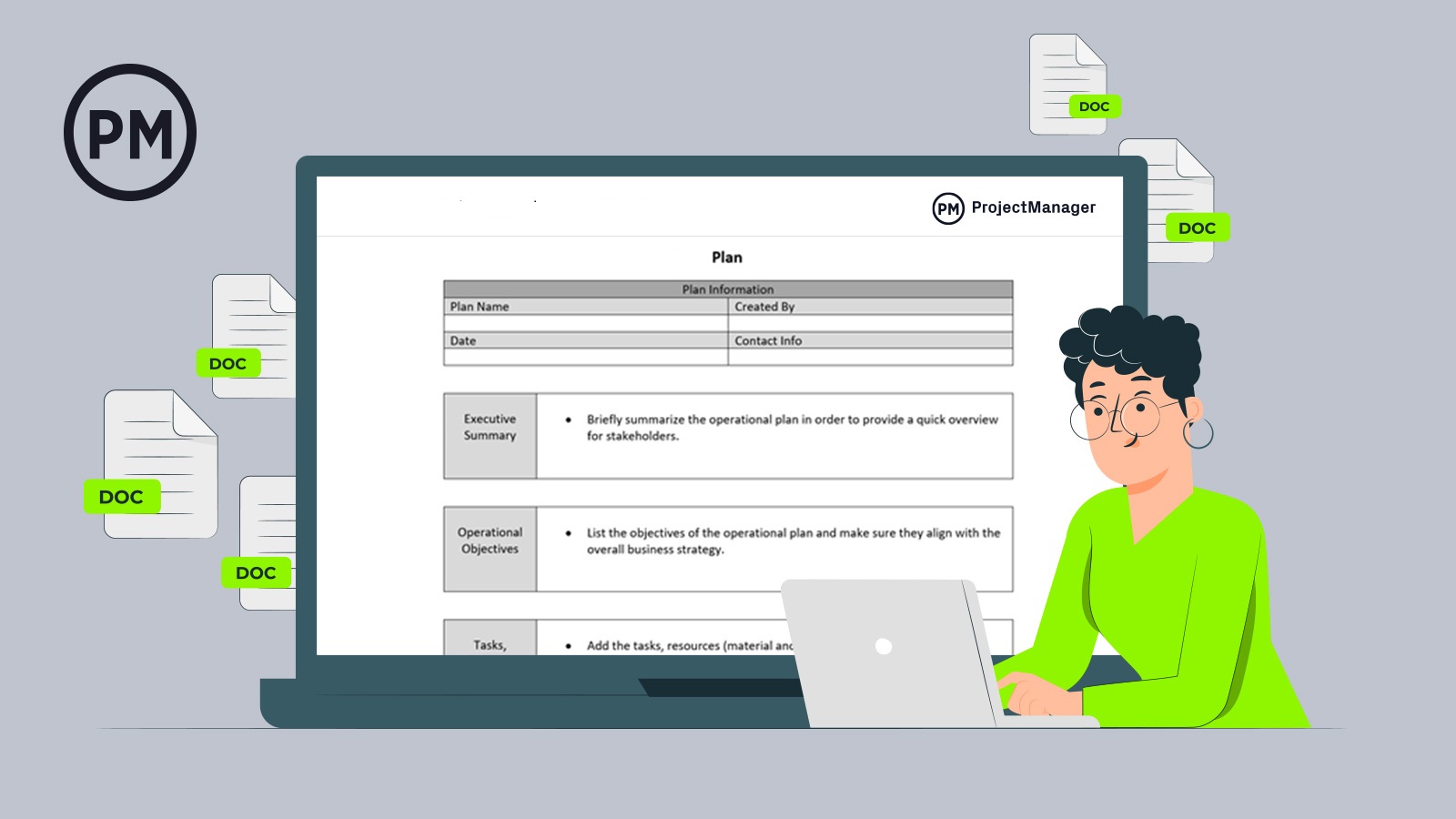
Get your free
Project Plan Template
Use this free Project Plan Template for Word to manage your projects better.
Besides the project team, projects require resources such as labor, materials and equipment. Organizations and individuals manage projects with a wide range of objectives. These can take many forms, from constructing a building to planning an event and even completing a certain duty. Retailers, for example, may pursue projects that improve the way they track order fulfillment. Construction teams complete projects any time they plan and build something—and so on!
Project management software gives you the tools to manage all the parts of a project so it is delivered on time and within budget. ProjectManager is award-winning project management software with features to plan, manage and track your project in real time. Organize tasks on our robust Gantt, link all four types of task dependencies to avoid costly delays and save your project plan by setting a baseline. This allows you to track your actual progress against your planned progress to help you stay on track. Get started with ProjectManager today for free.

What Are the Characteristics of a Project?
There are certain features or characteristics that are unique to projects and differentiate them from the daily operations or other types of activities of an organization. Here are the main characteristics of a project.
1. Any Project Needs a Project Manager and a Project Team
One of the most important characteristics of a project is that it’s a team effort. While the structure of project teams might change from one organization to another, projects usually involve a project manager and a team of individuals with the necessary skills to execute the tasks that are needed.
2. Every Project Needs a Project Plan
Project team members need clear directions from the project manager and other project leaders so that they can execute the work that’s expected from them. These directions come in the form of a project plan. However, a project plan is more than just a set of instructions for the project team. It’s a comprehensive document that describes every aspect of a project, such as the project goals, project schedule and project budget among other important details.
3. All Projects Go Through the Same Project Lifecycle
The project life cycle refers to the five phases all projects must progress through, from start to finish. The five phases of a project lifecycle serve as the most basic outline that gives a project definition. These five phases are initiation, planning, execution, monitoring and closure.
4. All Projects Share the Same Project Constraints
All projects no matter their size or complexity are subject to three main constraints: time, scope and cost. This simply means that projects must be completed within a defined timeline, achieve a defined set of tasks and goals and be delivered under a certain budget .
These project constraints are known as the triple constraint or the project management triangle and are one of the most important project features to know about.
5. Every Project Needs Resources
A resource is anything necessary to complete a project, such as for example, labor, raw materials, machinery and equipment. For example, in construction, raw materials such as wood, glass or paint are essential project resources . That said, other resources — like time, labor and equipment — are just as important.
A project manager must be able to identify all of the project resources in order to create a resource plan and manage the resources accordingly. When resources are left unaccounted for, it is easy to mismanage them.
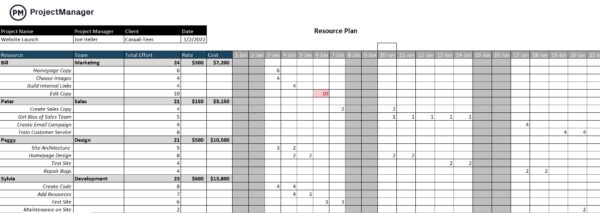
Types of Projects
Projects can take many shapes and forms, which makes classifying them into types a very difficult task that requires different approaches. Here are some of the types of projects grouped by funding source, industry and project management methodology .
Types of Projects By Funding Source
One simple way to categorize projects is to look at their source of capital.
- Private projects: Projects that are financed by businesses or private organizations.
- Public projects: Projects which are funded by Government agencies.
- Mixed projects: Projects that are financed by a public-private partnership.
Types of Projects By Industry
Projects can be executed by large or small organizations from any industry. However, some industries are more project-intensive than others. Here are some of the most common types of projects by industry.
- Construction projects: The main goal of any construction project is to make a building that can be used for different purposes such as infrastructure, residential or commercial use.
- Manufacturing projects: Manufacturing projects consist of manufacturing physical products to generate profits for a company.
- IT projects: Information technology projects consist in establishing an IT framework for the processing of data at a company-wide scale.
- Software development projects: The main goal of a software development project is to create a software product for a client.
- Business projects: The term business project could refer to creating a new business, creating a new business unit for an existing company or simply launching a new business initiative.
Types of Projects By Project Management Methodology
Besides the types of projects mentioned above, projects can also be classified by the project management methodology that’s used to plan, schedule and execute them.
- Waterfall projects: Waterfall is the most traditional project management methodology, where the project plan is defined before the project begins and each major project phase must be completed in sequence.
- Agile projects: Agile projects are planned and executed in short iterations known as sprints , where project teams plan their activities as they execute the project.
Project Examples
Now that we’ve reviewed the main characteristics of a project and the various project types that exist, let’s review some common project examples to better illustrate what a project is.
Construction Project Examples
- Construction infrastructure projects: Building a bridge, a road, a mass transportation system or a water treatment facility.
- Residential construction projects: Building a house, a residential building or an apartment complex.
- Commercial construction projects: Building a shopping mall, a parking lot or a hotel.
Manufacturing Project Examples
- Building a factory from scratch
- Manufacturing products for retail sale
- Manufacturing products for a B2B purchase order
- Improving an existing production line by acquiring new machinery and training employees
Key Project Terms to Know
No matter the project, there are universal project terms that are used regardless of project type, project size or any other factor. Know these seven terms like the back of your hand and you’ll be a step ahead before the project begins:
Project Scope
Project scope is a key aspect of the project planning stage. In many ways, it is the starting point. Determining project scope requires the project manager and their team to set goals and objectives, detail deliverables, create tasks, establish important dates and more. Project scope defines desired outcomes and all specific factors which will affect reaching them.
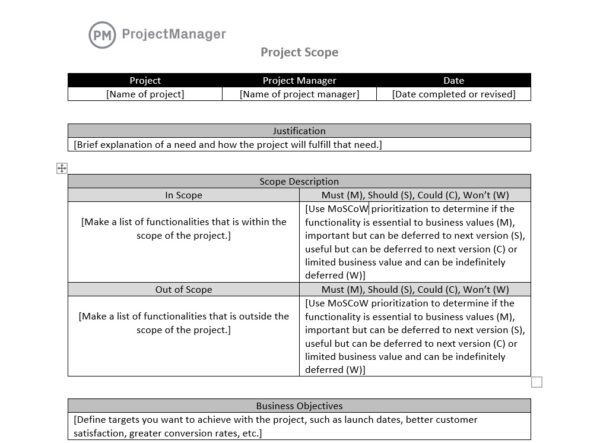
Project Stakeholder
A stakeholder refers to anyone and everyone involved in a project. A stakeholder can be involved at every stage of the project, or just in a certain way. Stakeholder analysis helps categorize how investors, team members, vendors, contractors and more can affect your project.
Project Deliverables
A deliverable refers to the specific outcome(s) a project creates. Deliverables can be “tangible” or “intangible,” meaning they can be a physical product or something conceptual. Typically, deliverables are the need that inspired the project in the first place. If someone contracts a builder to design and construct an office space, the office is a tangible deliverable.
Project Milestones
Milestones are predetermined achievements that help track project progress. Think of milestones as checkpoints. These checkpoints are decided on before a project begins, so the project manager and team know when they are on track to achieve deliverables. Without milestones, it’s difficult to know if the project is on the road to success or needs to reroute.
Project Dependencies
Project dependencies refer to how resources must be shared and allocated within a project. Many projects will use the same physical materials for different purposes and across different stages. Understanding this dependency is the only way to ensure there is enough resources to go around. Similarly, all projects are broken down into tasks. When one task cannot begin before another is completed, these tasks share a dependency.
What It Means to Work on a Project
Whether it’s the project manager, a team member or any other project stakeholder, they’re a member of the greater project team and their actions directly affect other team members. Like any team, you “win” or “lose” as a unit, so it’s incredibly important to communicate and listen to other team members in order to coordinate efforts and succeed. Most project mishaps and project failures are the direct results of poor communication or lack of collaboration.
Why does this matter as long as the work is getting done? Working on a project is about understanding the project as a whole just as much as it is about doing the work. The only way to see this big picture is by listening to the team and learning from one another.
What Is Project Management?
The process of project management starts with the conception of the project and continues all the way through the project lifecycle. This requires detailed knowledge of company resources and how to assign them in order to complete tasks, duties, events and other projects.
A wide range of industries relies on project management methods and tools to execute projects. A few examples of these industries are construction, IT, engineering, marketing and advertising. Any team working together to reach a shared objective is engaging in some form of project management.
What Does a Project Manager Do?
A project manager is more than just a manager, in the traditional sense. This individual is the leader of the project team and oversees every aspect of the project, from beginning to end. The project manager will typically write the project plan, run team meetings, assign tasks and do quality control tests to ensure everything is running smoothly. A project manager can’t carry the entire project on their back, though. One of their key duties, in fact, is knowing how to entrust various responsibilities to team members.
With the help of their team, project managers will create project schedules and budgets. They will also create project reports throughout the project lifecycle.
As you can see, their responsibilities are widespread, but that doesn’t mean spreading too thin. Ideally, a project manager creates the foundation of the project—like the foundation of a house. They then appoint other individuals to finish out each room.
Project Definition: Best Practices for Project Management
Regardless of the project, the size of the team, or anything else, there are practices that exponentially increase the chances of success. As vital as it is to hit goals and achieve deliverables , it’s just as important to create a positive culture within the project. These five tips may seem simple, but they make a big difference:
Set Regular Team Check-ins
It’s easy to meet with the team “as needed,” but once a project begins it gets harder to find time in everyone’s schedule. Instead, schedule regular meetings before a project even starts. These meetings serve as check-ins where team members can give each other updates, voice concerns, ask questions, make adjustments and do anything else they may need. When these check-ins are already built into the schedule, no one is waiting to meet until there’s a mishap or issue.
Part of what gives a project definition is knowing how to delegate. Whether it’s the project managers or a team member, they’ll more than likely need help with a task at some point. Now, this doesn’t mean just passing along the task to someone else. It means that every team member has equal responsibilities. Instead, the best project managers know how to relinquish some control and delegate to team members.
Know the Team
Everyone on the project management team should be familiar with each other’s strengths, weaknesses and specialties. For example, if a team member needs information from a different department, they should know exactly who to ask. This familiarity cuts down on lost time. It is especially important for a project manager to know their team extremely well.
When a project member knows these things, they can make decisions that play to their team members’ strengths, not around their weaknesses. Knowing the team is a huge aspect of creating a positive culture within a project, as it celebrates everyone’s abilities.
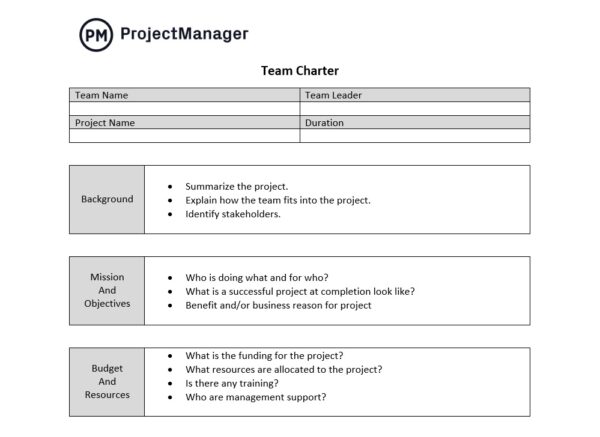
Celebrate Milestones
Speaking of positive culture, never underestimate the power of taking a moment to mark meeting a milestone . Reaching one means the team has made significant progress and the project is still on track. At the very least, it’s important to announce reaching milestones during team check-ins. This keeps everyone on the same page and improves team efficacy.
Choose Superior PM Tools
Project management is an extremely complex job. Without the proper tools, it’s easy to make mistakes, become disorganized and even fail to complete the project. The best way to protect your project from these missteps is by choosing tools that simplify the entire process.
The best project management software does just that. Using project management software unleashes your team’s and the project’s full potential and takes the end result to new heights. The key is finding an intuitive, user-friendly project management software that makes no compromises in functionality.
How ProjectManager Makes Managing Projects Easy
ProjectManager is an award-winning project management software that makes managing projects easier than ever. Our online software allows the entire team to work on the project while in the field or on the go, and our modern interface combines functionality with user-friendly navigation. This means no more wasted time just trying to familiarize yourself with a new tool and more time perfecting your project definition.
Plan on Gantt Charts
Plan your projects from start to finish with ProjectManager’s powerful Gantt chart feature, which allows you to map out project tasks in phases. You can even create dependencies and set milestones. Plus, you can import Excel files and Microsoft Project files, so switching over to our software is seamless.
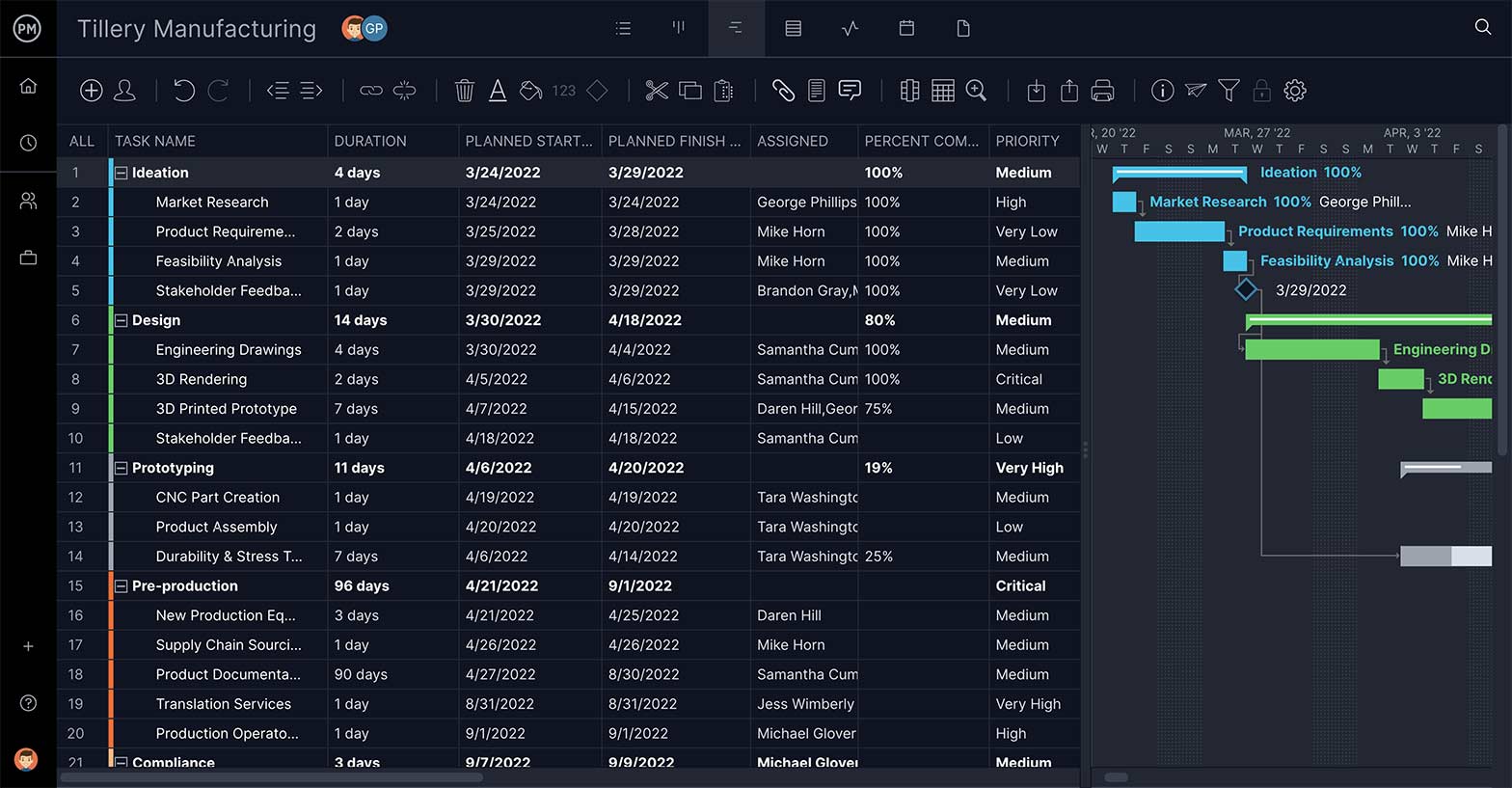
Track on Project Dashboards
As the project team moves forward with tasks, project managers can track every status update on our real-time dashboard that you can personalize to show the most important metrics. Every change to a task is tracked and automatically updates the colorful, easy-to-read charts and graphs. Keeping an eye on your project’s progress has never been easier!

Get all these features and more when you use ProjectManager. All of these tools are available in our software to help you plan, track and report on your project in real time. See what it can do for you by taking this free 30-day trial run!

Deliver your projects on time and on budget
Start planning your projects.

All You Have To Know About Agile Project Management Methodologies !

1 click unsubscribe at any time
This article aims to help you discover and master the art of agile project management so you can turn your challenges into concrete successes. 🏆
But first, I’m sure that the term “ project management “, which is a very general one, doesn’t speak to everyone and needs a little clarification! ⛏️
🎯 In this case, it encompasses all activities aimed at organizing the smooth running of a marketing project , and achieving objectives effectively and efficiently. That is, within the constraints of time, budget and quality.
➡️ When managing a project, there are 5 stages to go through: conception, planning, execution, monitoring, control and finalization. To do this :
- We adopt a defined, pre-selected process for project execution.
- Knowledge, skills, tools and techniques are applied to all activities.
🦄 There are many marketing project management methods , each with its own advantages and disadvantages. The choice depends on the nature of the project, the organization, the types of activities, the group’s preferences…
For our part, we’re going to take a closer look at agile project management methods (as opposed to traditional models). 🤸🏼♀️ If you don’t know what that is, get ready to move from chaos to clarity! 💡
⬇️ Here’s the program:
- Agile project management: definition, context and benefits.
- Top 4 agile project management methods
- Case studies: Spotify and Twitter
- Tips for choosing the right method and tools
We’re off! 🤩
Agile Project Management : Definition, Context And Benefits
The definition of agile project management.
👉🏼 As you’ll have gathered by now, the term “ agile ” refers to a project management method that combines iterative and incremental approaches (we’ll see exactly what these approaches are later on).
Agility focuses on value delivery and continuous improvement, but also on values such as collaboration, adaptation, self-organization and transversality. 💎
🤝 We speak of co-design between all stakeholders, who aim to find the best solutions to meet the project’s challenges and create maximum value.
The model is based on the setting of short-term iterative objectives , as well as on the evolution of requirements and solutions through. 🔄
🧩 A major project is broken down into stages and/or sequences taking place one after the other: these are known as sprint . 🏃🏻♂️ Sprints are made up of several stages, generally consisting of the following:
- Retro-planning .
- Development.
- Testing and verification.
- Demonstration and/or deployment.
- Evaluation of results.
- Gathering comments and/or information.
- Establish new rules and move on to the next sprint (the solution doesn’t need to be completely finalized, just functional).
Flexibility and adaptability are the watchwords of this method. 🤸🏼♀️ We recommend using it when you’re unsure of the specifications from the outset, or when you lack visibility of how the project will evolve. 🧐
In short, agile project management is applicable to a multitude of activities and projects. That’s why it’s now a must-have and used by almost half of all organizations, according to an international study conducted in 2020 by Organize Agile. 🔍
Emergence Of The Agile Project Management Methods
📣 As a reminder, project management isn’t new, since it’s a concept that’s been used for hundreds of years. But the concept of “ agile project management ” is much more recent, having emerged in the 2000s.
Originally, organizations were dissatisfied with traditional project management approaches (predictive V-model method). They wanted to find a less constraining way of improving and accelerating the development process . ✨
After years of research, the Agile Manifesto that introduced the method, and proven feedback based on tangible indicators… 💥 Its effectiveness has finally been demonstrated with certainty.
🖱️ It first began to be democratized in the IT frameworks sector , and then beyond. These principles are now used by all functions in organizations, and several have been created.
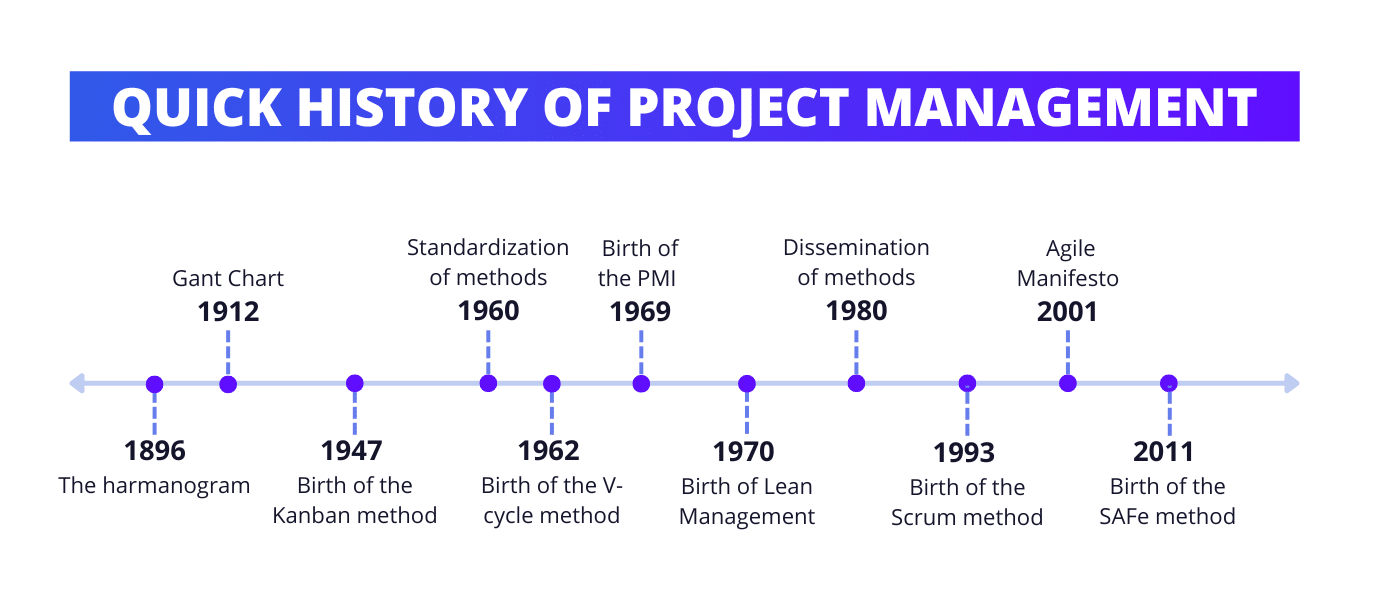
At the end of the article, we provide examples of major companies using this method, along with their unavoidable principles. 🤩
But first, let’s explain what has convinced millions of organizations around the world to use it, and how they do it. 👇🏼
Benefits Of Agile Project Management
🎁 If agile methods has convinced so many people, it’s because it has more to offer than other models and its benefits are not negligible.
They are flexible and adapt easily to change. This means they can react quickly to new requirements and unforeseen events. In particular, thanks to the division of labor into small iterations, they can deliver results quickly and adapt to change. 🎢
💎 In short, what distinguishes the agile project management method is its ability to :
- Offer a faster, more flexible and more efficient way of managing unforeseen, deadlines , adjusting or reducing.
- Produce more in less time, and offer greater flexibility to take advantage of opportunities as the project progresses.
- Integrate the customer into the construction of the project to improve their satisfaction and adapt more easily to their expectations.
- Encourage employee autonomy and bring all professions within the same group to share knowledge.
- Enhance management efficiency and the chances of achieving profitability targets, even in an uncertain and rapidly changing environment .
- Strengthen an organization’s market position and culture through a constructive approach.
Finally, all agile project management frameworks share five main components (inspired by the 12 principles of the Agile Manifesto ): cadence, synchronization, and quality development practices. 📚
We’ve just listed all the reasons why others have chosen to use it. And, we’ve also listed the reasons why you should use it too 😉
Obviously, there are several agile project management methods to choose from. 🌈 So, stay with us, we’ll introduce you right away!
Top 4 Most Commonly Used Agile Project Management Methods
💡 It’s time to help you choose the agile project management method best suited to your project and/or business, from among the main existing models.
1. Scrum Method
Scrum is the most popular agile project management method today. 👑
👀 Quite simple, it is dedicated to single-team management and aims to make visible the effectiveness of management techniques, work environment, so that improvements can be made.
It is based on a lightweight and agile framework for developing and maintaining complex projects. It helps individuals, teams and organizations generate value through adaptive solutions. 🤸🏼♀️
This agile project management method is based on two concepts ♻️ :
- Empiricism asserts that knowledge comes from experience and from making decisions based on what is observed, tested, approved and known.
- Lean management , is an agile project management method in its own right, reducing waste and focusing on the essential value or added-value production.
It also uses an iterative and incremental approach, with three essential pillars involving specific roles, events and artifacts.
The entire model structure is designed to optimize predictability and control risk . ☢️
1. Transparency : the progress of the work must be visible to all stakeholders. 👀
- What represents value here are the artifacts (product backlog , sprint backlog and increment ). They are designed to maximize the transparency of key information.
- Artifacts with low transparency can lead to decisions that decrease value and increase risk.
- Without “transparency”, there can be no inspection, as it would be misleading and costly.
2. Inspection : progress must be inspected. 🔍
- This step enables us to detect any deviations or potentially undesirable problems.
- To facilitate inspection and day-to-day organization, the pace is set by five events designed to facilitate change: the sprint, the planning sprint, the daily scrum , the sprint review and the sprint retrospective.
- Without inspection, no adaptation would be considered useless.
3. Adaptation : occurs when certain aspects deviate from the desired result. 🎯
- If the workflow deviates from acceptable limits, or if the result obtained is unacceptable, the process must be adjusted as soon as possible (to reduce any further deviation).
- The group is expected to adapt as it learns something new through inspection. Adaptation becomes more difficult if members are not prepared for it.
- The Scrum team must therefore bring together people who collectively have all the skills and expertise to apply the model, share or acquire skills… Team members include developers, a product owner and a scrum master (or the manager).
🏆 Scrum ‘s success depends on group members recognizing themselves through five values: commitment, focus, openness, respect and courage.
The structure of the method is deliberately incomplete , defining only the parts required. ❌ It builds on collective intelligence rather than providing detailed instructions.
2. SAFe Method
SAFe, or The Scaled Agile Framework , takes the agile method beyond the confines of a single team and integrates it into the company’s overall strategy. 🗺️
SAFe is a cross between Agile, Lean and DevOps. 🔀 It focuses on the detail of practices, roles and activities at the management of portfolio , program and team management levels.
🗓️ Work is planned in batches, so that problems can be identified earlier and progress is visible in real time. Ongoing rituals can also be regularly inspected and adapted.
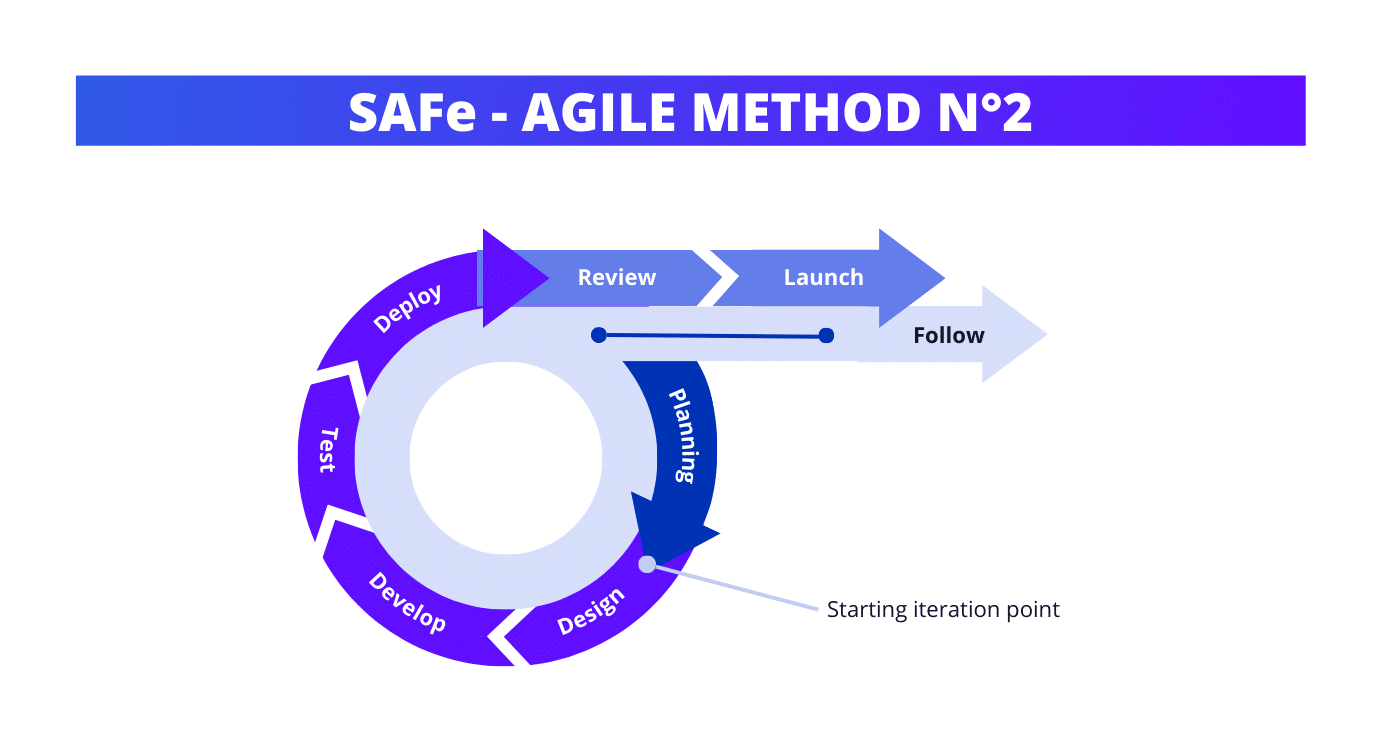
To integrate agility at all levels, the method provides a knowledge base and establishes a common language as well as common foundations through various core values 👇🏼 :
- Alignment of business objectives to cope with rapid market changes.
- Integrated quality at every level.
- Exceed agility requirements.
- Trust and transparency.
- Program execution (ability to deliver a functional , high-quality project).
- Lean/Agile management and leadership to create the right environment and transform systems.
➡️ Next, SaFe can be configured and implemented in 3 levels , distinguished by their level of ease of implementation, the type of organization or activity and finally the quantity of elements to be integrated (roles, events, artifacts and skills).
Typically, this model is used by companies with hundreds or thousands of teams, operating in ART mode (Agile Release Train ). That is, with a cross-functional team bringing together several agile and multiprofile groups . 👥 With smaller organizations, this method will have no impact.
✋🏼 It is used, for example, when the following needs are identified:
- Bring greater coherence to the overall strategy.
- Standardize objectives and organization.
- Greater flexibility between groups and players.
- Streamline and facilitate development/delivery.
If you’re interested, the latest version of the method is now based on 10 principles, derived from Agile and Lean methodologies, but also from observation of successful companies. 📈
Please note that the application of a new model is not a miracle solution. 🤷🏻♀️ Furthermore, the complexity of SAFe’s application could dissuade many from using it, as it requires :
- Reorganization or even redesign of the entire organization.
- Rewriting and introducing new processes.
- Technical installation and familiarization with new tools.
- Culture change and learning agile values .
- A colossal task of adaptation and understanding.
- A multitude of roles and events to set up.
⚙️ For your information, there are several sources providing a roadmap for implementing SAFe (with detailed steps for getting started and configuring the organization for widespread adoption across all portfolios).
🆙 Finally, there are others Scale-up techniques that we won’t detail here: LeSS, Nexus, Scrum@Scale, Scrum of scrums , Lean Software Development , Disciplined Agile Delivery (DAD)…
3. Kanban Method
Kanban is a flexible agile project management method based on the Lean approach. ♻️ It is inspired by an inventory control and stock management system that enables on-demand production.
⏱️ It is based on the principle of rapid delivery and aims to :
- Continuous improvement and reduction of production costs.
- Achieving balance between production and demand.
- Eliminate waste and avoid stockpiling as much as possible.
- Reduce lead times and achieve fair, high-quality production.
- Foster collaboration to solve problems and improve quality.
- Optimize team responsiveness.
ℹ️ Kanban is a visual information system that makes use of the programs already in place and encourages their improvement. It’s also the model that provides the quickest feedback and the best control of workflow, thanks to a chart. 👁️
It consists of a system of labels or pull cards. 🏷️ Each card corresponds to a request that triggers production, and contains the tasks to be carried out as well as various instructions.
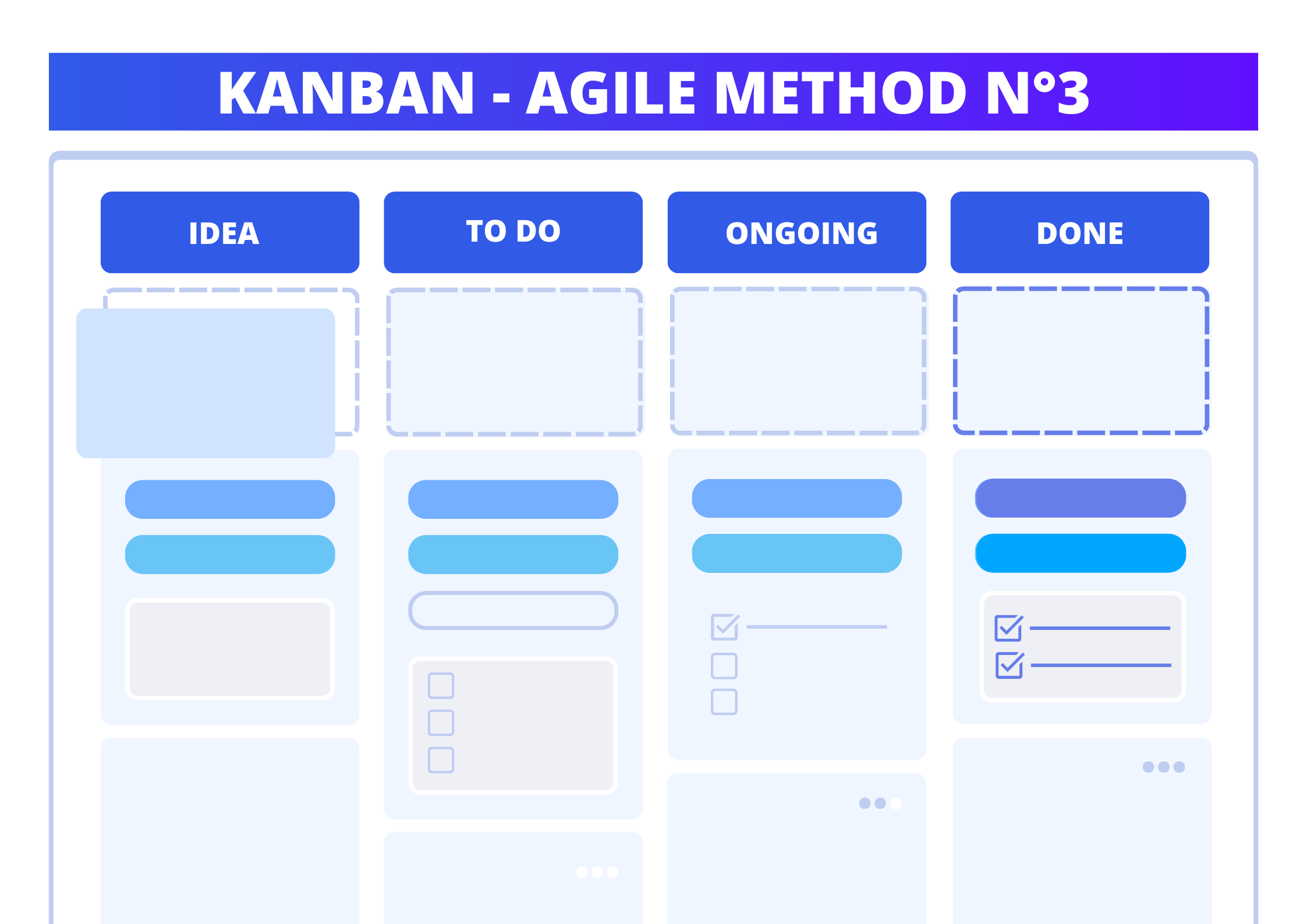
👩🏻🏫 The board is the major asset of this method, as it enables the team to :
- Visualize and manage the flow.
- Identify visible obstacles or opportunities.
- Adjust process limits in real time.
- Improve efficiency and productivity.
- Collaborate, communicate and circulate information on tasks to be carried out.
💡 If you want to adopt this method, here are some tips:
- Don’t try to change everything overnight, start with what you’ve got and agree to improve the existing system through gradual changes.
- To eliminate the fear of change, respect the roles, responsibilities and professional titles of each group member.
- All players within the organization must be involved in the process.
- Labels provide a framework, but one that must remain flexible and adaptable.
Last but not least, the Kanban system can be adapted to a variety of working modes (individual, team or even organizational), but not to all production levels. When the production rhythm is irregular, the method no longer works. ❌
⚙️ Much software and marketing tools use the Kanban method, such as Click-up, Miro, Trello, Jira…
4. Dynamic Systems Development Method (DSDM)
DSDM , or Dynamic System Development Method, is an agile project management method, initially reserved for software, which follows an iterative, progressive and incremental logic; mainly inspired by the Rapid Application Development (RAD) model. 📲
🤝 DSDM actually came into being thanks to the cooperation of the industry’s RAD approach leaders , to solve a problem posed by RAD, namely its lack of structuring and the absence of common processes between teams.
It is mainly used for projects with very tight delivery deadlines, and aims to deliver at the end of each iteration. ⏱️ Of course, within budget, while adapting to changes and modifications.
🧑🏽⚖️ It applies Pareto’s law , so it doesn’t take long to reach a stage where the product can be said to working (80% system deployment in 20% time ).
The DSDM is therefore a lightweight, effective and adaptable method that provides a four-step framework, including 👇🏼 :
- Feasibility and business study.
- Functional model / prototype iteration .
- Design and build iterations.
- Execution/Application.
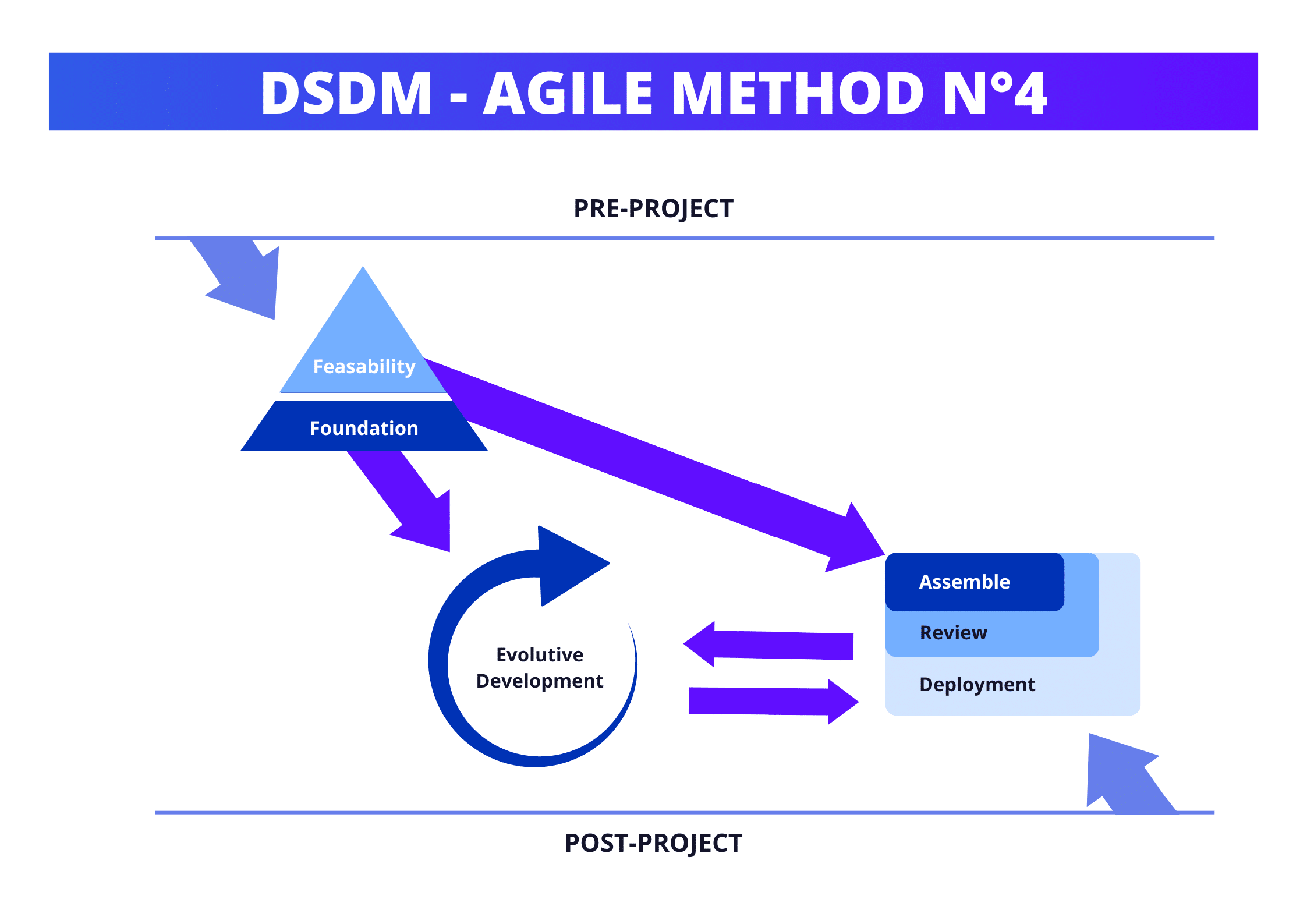
💎 The method is also based on four core values … :
- Individual : Valuing people who work on the project and are more familiar with the practical side.
- Functional software (version used by the end user).
- Essential collaboration for a functional project (e.g. cross-functional team, co-location with customer, animation workshop…).
- Responding to change : prioritize Welcoming and all changes required to adapt/respond in a highly innovative way.
…As well as nine fundamental principles , focused on business needs and distinguishing this model from others 👥 :
- User involvement : Permanent, ongoing and active contact with a small, selected group to reduce errors in user perception, cost of rework, etc.
- Empowered teams : Encourage empowered decision-making (⚠️ can potentially be a critical point).
- Frequent delivery : Guarantee that errors/bugs are identified, dealt with and resolved/reversed/corrected at an early stage.
- Ability : to meet a business need and accept modifications or improvements in a subsequent iteration. DSDM does not create ad hoc software. ❌ It keeps the process flow simple and efficient.
- Incremental development : Breaking down a major project into several sequences of functionalities delivered to customers with each delivery (up to the complete package or finished product).
- Reversible modifications: Iteration occurs in small increment and modifications are reversible (little risk of total loss of progress).
- Define requirements : Limit the degree of freedom needed to make changes.
- A/B testing integrated and carried out during development to ensure that the product(s) is (are) free from technical defects (solve problems early to reduce rework, costs and lead times).
- Stakeholder cooperation : Value creation, compliance with precise requirements and honest feedback on results can only take place if trust and honesty prevail.
We’ve now finished presenting the four main agile project management methods: Scrum, Kanban , SAFe and DSDM. 🎬 If you’d like to find out about other existing models, we’ll give you a few pointers in conclusion .
To make it easier to understand, we’d like to share with you some use cases of agile project management techniques in large companies. 👇🏼
Get your first customers this week
Take advantage of the power of Waalaxy to generate leads every day. Start prospecting for free, today.
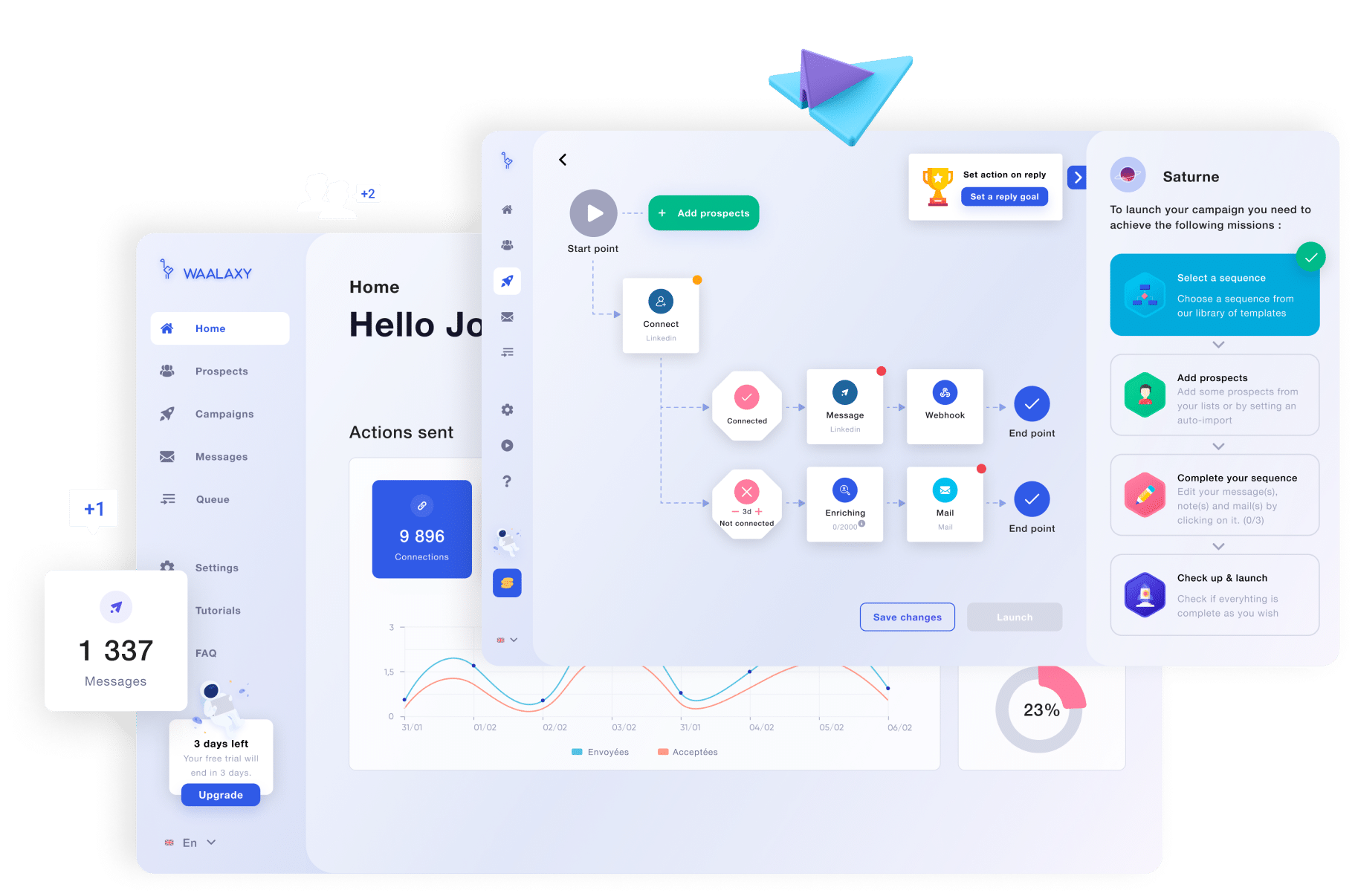
Agile Project Management Study Cases : Spotify And Twitter
Project tracking with twitter.
🐦 Twitter (new X) is an emblematic social media with thousands of employees and hundreds of different teams. The structure began to take an interest in agile project management methods in 2010.
In 2019, at Hack Week, a senior application engineer at Twitter, proposed modifying the Jira tool to help the experience development team better manage and track work . 🧠
So they developed a script that aligned a project model for all types of problems, flows and screens. 🤯 The project is called Experience Project Tracking and was an immediate success.
🎉 A second project was therefore immediately born and directly approved : Unified Project Tracking . This project is based on the same structure as Experience Project Tracking, but focuses on objectives, asynchronous mode and accessibility.
⚙️ New features have also been added to organize the work of each team:
- The hierarchy of new and existing projects.
- Follow-up and accountability.
- Problem type customization.
- Data-driven prioritization .
- Link and dependency mapping.
↔️ By creating an experience with standardized flows between groups, unified project tracking has enabled teams and managers to :
- Measure progress more easily and execute more efficiently.
- Easily establish the critical path of a business plan and explore different variants.
- Take the plunge, knowing where to focus your attention.
- Strategic planning and monitoring.
Twitter’s use of agile project management techniques has transformed teamwork throughout the organization. 🏆 Which has therefore earned it the Best in Class (technical) award in 2021.
🎶 Spotify is a leading digital music service and is known for its dynamism and technological know-how. The company began applying agile project management techniques in 2008.
After several test phases, Spotify’s choice quickly fell on the Scrum method . Unlike Google’s “basic” strategy, Spotify adopted this model with a systemic approach. 🔍
Their vision and key principle was to live and breathe Scrum as a development methodology . 😮💨 Spotify’s Scrum masters then became experienced agile coaches or leading agile trainers.
The digital music service has formed small, totally independent teams called “squads”, which are treated like individual startups . 🚀
They are allowed to be totally autonomous and work independently to focus on specific functions assigned within the product. 🖱️
🦾 The added advantage of the latter is that they can make changes and provide upgrades without interfering with other teams’ projects.
This approach seems to balance independence with knowledge sharing between specialized groups, who do not engage in day-to-day collaboration. ⚖️ At the same time, Spotify has avoided scaling problems by decoupling where possible.
What made this approach so successful was the rapid removal of obstacles and problems as soon as they arose. It has enabled and continues to enable Spotify to act, grow and deliver software updates quickly. 🔄
As you can imagine, deploying and integrating agile project management methods is no mean feat. Spotify and Twitter took years to find their model. ⌛️
👉🏼 If you’re looking for other use cases for agile project management models in companies, here are a few: eBay, Walmart, Verizon, Airbus, AXA, Orange Bank…
Conclusion : How To Choose The Right Method And Tools?
In conclusion, choosing to invest in agile project management can be highly beneficial for groups and organizations, as it helps them achieve better results more efficiently. 🎯
💡 Here’s a rough guide for choosing the right agile project management method for your marketing strategy :
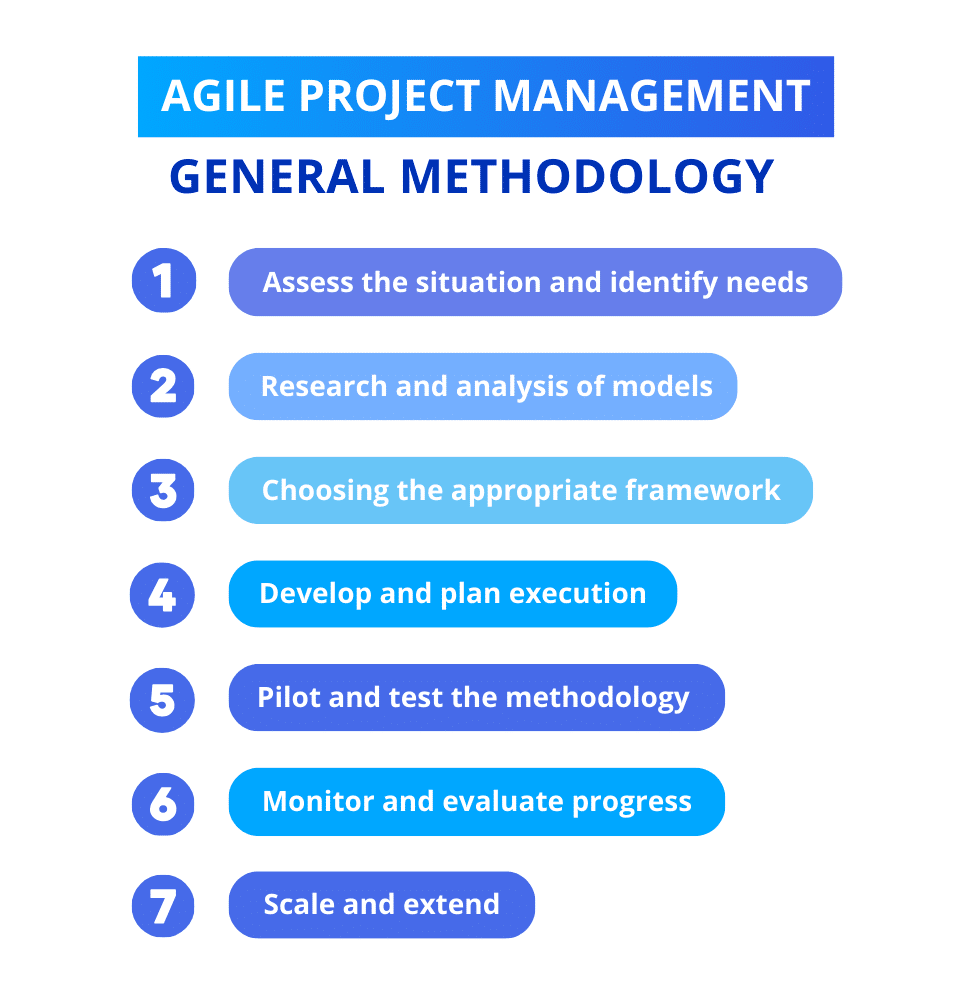
1. Assess the situation and identify needs : type of project, time and budget constraints , SMART goals , level of customer or team involvement, appropriate methodology…
2. Research and analyze different agile models : In this article, we’ve talked about Scrum, SAFe, Kanban, Lean, RAD, DSDM… But there are plenty of others 👇🏼 :
- Agile Unified Process (Agile UP or AUP),
- eXtreme Programming (XP),
- Feature-Driven Development (FDD),
- Agile Data,
- Adaptive software development (ASD)
- Behavior-driven development (BDD)
- DDD domain-driven design
- Test-driven development (TDD)
- Rational Unified Process (RUP)
- Enterprise Unified Process (EUP)
3. Choose the right framework ✅ : factors to consider include team size, project complexity, culture, brand image … Finally, we recommend that you apply a single method, from the design stage through to project completion.
4. 📆 Plan and develop a plan for execution (definition of roles, training and resource requirements, communication plan …)
5. Pilot and test the methodology 🕹️ , for example on a small project or team, to assess its effectiveness and identify areas for improvement.
6. Monitor progress and evaluate feedbacks the effectiveness of the new methodology 🤔 (productivity and group dynamics, quality of results, customer satisfaction and overall success of the project…), then collect 🗣️ from all stakeholders in order to make adjustments if necessary.
7. 🪜 Scale up and extend : If you manage to apply the methodology successfully on your pilot project, then you can extend it to other projects and teams within the organization. At that point, you can choose your appropriate project management tools .
NB: The order and content of the above steps is indicative, and this roadmap may be modified according to project and organizational circumstances.
Have you noticed that we haven’t mentioned agile project management tools at all until now? ⚙️ In fact, there are dozens of marketing software packages specializing not only in agile project management, but also in certain agile project models.
We start from the most basic, i.e. agile project management on Excel (free) . 🤦🏻♀️ to the use of Enterprise Agile Planning (EAP) tools supporting agile frameworks .
Finally, as a reminder, integrating agile project managemen t methods requires training, constant effort, learn and continuous improvement to guarantee long-term success . 💪🏼 Despite its many benefits, this methodology is not for every company or every project.
Before taking the plunge, we therefore advise you to carefully analyze your needs, your capabilities and your chances of success by investing in this solution. 🍀
Frequently Asked Questions (FAQ)
🏁 To conclude, here are the answers to the most frequently asked questions on the subject. 👇🏼
What Is The Project Management Triangle ?
The project management triangle , also known as The Triple Constraint or Iron Triangle, is a fundamental concept which illustrates the interrelationship between three interconnected variables that determine the quality of the project :
- Scope : Goals, deliverables , features, and tasks that need to be accomplished within the project. It defines what needs to be done and what is excluded from the project.
- Time : Schedule or timeline for completing the project. It includes deadlines, milestones, and the overall duration of the project from start to finish.
- Cost : Budget allocated for the project, including resources, materials, labor, and other expenses necessary to complete the project successfully.
Any change in one factor will invariably impact the other two, your project must carefully balance these constraints to achieve project success … For example:
- Increasing the scope of a project without adjusting the time or cost will likely lead to delays and increased expenses.
- Trying to shorten the timeline of a project may require additional resources or increased costs to meet the deadline.
- Decreasing the budget of a project may necessitate reducing the scope or extending the timeline to accommodate the limited resources.
What Are The Main Stages In A Project’s Life Cycle?
🔄 The project life cycle refers to the process by which a project is imagined, executed and delivered.
As we briefly mentioned at the start of this article, there are 5 essential stages in a project’s lifecycle. ✅ Let’s break them down together:
- Design : Defining the project, identifying stakeholders and obtaining their approval. It includes activities such as feasibility studies and resource selection.
- Planning : Planning the project’s activities, defining the resources required, and drawing up a timetable or retro-planning. It includes activities such as breaking down the work, estimating the budget or costs, creating a communication plan…
- Execution : This is the most difficult stage, executing the plan and carrying out the planned activities and/or tasks. Operationally, this includes monitoring progress and resolving problems.
- Monitoring and control : Monitoring and ensuring that the project is progressing according to plan. It includes activities such as monitoring costs, measuring performance indicators and managing risks.
- Finalization : This stage takes place when the products or services are delivered, and includes project documentation and performance evaluation.
What is PMO methodology?
The Project Management Office (PMO), is a centralized entity within an organization that is responsible for defining and maintaining standards and practices related to project management.
PMO methodology serves as a framework to promote consistency, efficiency, and effectiveness in project management practices across the organization, ultimately contributing to successful project delivery and organizational success.
It also refers to the set of processes, procedures, tools, and best practices established and managed by the PMO to support and govern project management activities across the organization.
The PMO methodology typically includes the following components :
- Project Governance frameworks to ensure projects align with organizational goals and priorities.
- Standardized Methodologies and Processes such as waterfall, agile, or lean, and associated processes tailored to the organization’s needs.
- Standardized Templates, Tools and Guidelines to support project planning, execution, and reporting.
- Resource Management processes for allocation, capacity planning, and resource optimization across projects.
- Performance Measurement and Reporting of key performance indicators (KPIs) and metrics defined to measure project performance and progress.
- Risk Management processes to identify, assess, mitigate, and monitor project risks.
- Quality Management processes implemented to ensure project deliverables meet quality standards and customer requirements.
- Change Management processes established to effectively manage changes to project scope, schedule, and budget.
What Are The Different Methodologies of Project Management ?
➡️ In marketing , there are 5 ways to manage a project:
- Incremental : An approach that provides finished deliverables that the customer can use immediately.
- Iterative : This criterion allows feedback on unfinished work, so that improvements and modifications can be made during the project.
- Predictive : The more traditional approach (nicknamed V-cycle or waterfall ), with most of the planning upstream, then execution in a single pass; a sequential process.
- Agile (detailed in this article): simultaneously iterative, incremental and to refine elements and deliver frequently.
- Hybrid : A combination of predictive, iterative, incremental and/or agile approaches, allowing greater flexibility and delivering diverse results.
Now you know all about agile project management ! See you soon! 👽
Want to go further?

Soft Bounce VS Hard Bounce: What is it & what can you do about it?

8 steps to a successful sales marketing policy

Podawaa / Waalaxy vs Powerin.io

Social media
Prospecting
Recruitement
7 examples of successful LinkedIn prospecting messages
Masterclasses
Dans la piscine
Sucess story
TechRepublic
Project management.

10 Best Free Project Management Software & Tools for 2024
Free project management software provides flexibility for managing projects without paying a cent. Our list includes free and freemium products that can manage most projects or introduce you to your next paid project management software.

12 Best Project Management Software for Mac Users in 2024
This is a comprehensive list of the best project management software for Mac. Use this guide to compare and choose the best solutions for your business.

Asana vs Monday 2024: The Ultimate Project Management Showdown
Discover which project management tool leads in 2024. Compare Asana vs Monday on their features, usability, and more for the best fit, thanks to our expert research and guidance. Make your decision today.
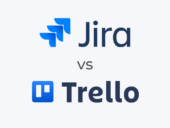
Trello vs. Jira Showdown: Who Wins in 2024?
Discover the key differences between Trello and Jira. Find out which project management tool tops your needs with our expertly researched guide.

8 Best Flowchart Software Tools for 2024
This is a comprehensive list of the best flowchart software, covering features, pricing and more. Use this guide to determine the most suitable software for you.
Latest Articles

ClickUp vs Notion (2024): Which Tool Is Better For Your Team?
What is the difference between ClickUp and Notion? Read our article to compare their standout features, pros, cons, and more.

The 10 Best Project Management Software and Tools for 2024
With so many project management software options to choose from, it can seem daunting to find the right one for your projects or company. We’ve narrowed them down to these 10.
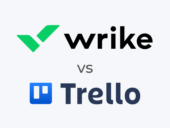
Wrike vs Trello (2024): Which Tool Is Best for Your Team?
This guide compares Trello and Wrike and helps you pick which one is the better project management tool for your business.

Microsoft Planner vs Asana: Which Tool is Better? (Updated for 2024)
Deciding between Asana and Planner? This comparison guide will help you evaluate their features, pricing, and more.

The Ultimate Task Management Tool is Just $25.50 for Life
Get organized and on-task with Pagico 10. Currently more than half off its regular price for a permanent lifetime license. Only through May 20, use code TRA15 at checkout for an extra 15% off its already discounted price.

ClickUp vs monday.com (2024): Which is Best for Your Team?
Which is better for your team: ClickUp or monday.com? Use our guide to compare each tool's pricing, features, and more.

TechRepublic Premium Editorial Calendar: Policies, Checklists, Hiring Kits and Glossaries for Download
TechRepublic Premium content helps you solve your toughest IT issues and jump-start your career or next project.

Trello vs Asana in 2024: The Best Tool Determined by Experts
Utilize our expert research on Trello vs. Asana to see which tool leads in 2024 for streamlining your projects and boosting team productivity.

Notion vs Confluence (2024): Which Tool Should You Choose?
Which is better for your team, Notion or Confluence? Use our guide to compare each tool's pricing, features and more.
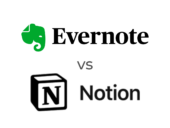
Notion vs. Evernote: Which Software Should You Use?
Notion vs Evernote. Compare features, pricing and more with our guide and get better informed decision about what would fit best for you.
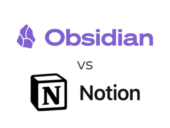
Obsidian vs. Notion (2024): Which Tool Is Better?
Which tool is better, Obsidian or Notion? Read our guide to learn more about pricing, features and more.
Create a TechRepublic Account
Get the web's best business technology news, tutorials, reviews, trends, and analysis—in your inbox. Let's start with the basics.
* - indicates required fields
Sign in to TechRepublic
Lost your password? Request a new password
Reset Password
Please enter your email adress. You will receive an email message with instructions on how to reset your password.
Check your email for a password reset link. If you didn't receive an email don't forgot to check your spam folder, otherwise contact support .
Welcome. Tell us a little bit about you.
This will help us provide you with customized content.
Want to receive more TechRepublic news?
You're all set.
Thanks for signing up! Keep an eye out for a confirmation email from our team. To ensure any newsletters you subscribed to hit your inbox, make sure to add [email protected] to your contacts list.
10 min read
Improving a business is about more than just increasing efficiencies or maximizing ROI. Today’s global economy also requires the flexibility to adjust to changing markets, conditions and technologies. Operational excellence is a way for organizations to create a roadmap toward continuous improvement in a complex business environment.
Its goal is to give companies a competitive advantage. If done right, operational excellence helps business leaders make better decisions and employees show continuous improvement. Companies that are better at problem-solving and process improvement, the theory goes, will ultimately exceed their competition in profitability.
Here, we’ll explore the core principles of operational excellence and how companies are using technology to implement these methodologies.
Operational excellence (OpEx) is an approach to business management that emphasizes continuous improvement across all aspects of the business and within all business processes by creating a culture where management and employees are invested in business outcomes and empowered to implement change. When implemented well, every member of an organization sees the flow of value to the customer and, if problems arise, finds a solution before any disruptions occur.
Operational excellence begins with a culture shift, where all leaders and employees are dedicated to creating not only a quality product but also providing great customer experiences. Businesses that use operational excellence methodologies clearly define leadership and workforce roles and how they work together to improve operations. At all levels, employees can initiate change and drive toward efficiency, effectiveness and agility.
The definition of operational excellence has its roots in the Shingo Model, an approach to business that emphasizes quality at the source, value to the customers, a zero-inventory supply chain and an understanding of the workplace at all levels. It was created by Dr. Shigeo Shingo, a business leader who published 18 books on his philosophy and closely collaborated with Toyota executives to apply his principles in their manufacturing operations.
Shingo is also the inspiration for the Shingo Prize, awarded annually by the Shingo Institute for Operational Excellence at Utah State University. This prize defines the 10 Shingo Guiding Principles, often referred to as the core principles of operational excellence:
- Respect every individual: When people feel respected and valued by an organization, they are more likely to give more. Respect seeks to draw the best from individual contributors.
- Lead with humility: When decisions are made unilaterally, frontline employees are less likely to respect the decisions being made. To lead with humility, companies must implement a management system where leaders seek input and buy-in from stakeholders at all levels.
- Seek perfection: This principle is similar to the adage, “You have to believe it to achieve it.” By seeking ways to continuously improve, you can open the door to new ways of thinking and innovation.
- Embrace scientific thinking: This principle is not just about being data-driven. Creating a culture where employees are able to “experiment” and test new ideas based on observations and data fosters innovation.
- Focus on process: If something goes wrong, instead of blaming people (which can be counterproductive), look for ways the process can be improved.
- Assure quality at the source: Much like good food is made with good ingredients, assuring quality in business relies on doing work right the first time, using the right people and the right components.
- Improve flow and pull: Providing value to the customer means having the products that they demand when they need them and nothing more, which is exemplified in lean supply chains.
- Think systemically: Instead of focusing on individual players or departments for improvement, think of ways to improve the entire system.
- Create constancy of purpose: Communication of goals, purpose, commitment to the customer and the “why” behind the company are key to operational excellence.
- Create value for the customer: Ultimately, all businesses are all about the customer, so operations should reflect the value customers hold and should be provided.
As the Shingo Model gained popularity within the business world, others developed methodologies based on this approach and the core principles of operational excellence. These include:
- Lean manufacturing: Lean manufacturing is a systematic method designed to minimize waste while keeping productivity constant.
- Six Sigma: Six Sigma is a set of methodologies, tools and techniques used to improve processes and minimize defects. It’s sometimes combined with lean manufacturing principles and then known as “lean Six Sigma.”
- Kaizen: Focused on continuous improvement, Kaizen emphasizes teamwork and proactively taking responsibility for designated areas within the organization to make incremental improvements.
When implementing operational excellence within an organization, it can be helpful to view the process as an ongoing journey rather than a final destination. Because the focus is on continuous improvement, business leaders and employees should always strive for ways to get better at what they do.
That being said, organizations need to establish goals and define metrics to understand if and how they are improving. These metrics include key performance indicators (KPIs), such as sales increases, health and safety performance and workforce retention rates.
Here are the types of goals that are often included in operational excellence-based processes:
- Operational goals: How the company operates, including efficiency and safety. For example, an organization might seek to accelerate order to cash, solve problems with the supply chain or improve the delivery of services.
- Financial goals: Metrics related to sales and losses. These goals could be to lower churn, efficiently enter new markets or improve the marketing-to-sales pipeline.
- Culture and workforce goals: These include measuring worker satisfaction, offering professional development and investing in worker retention. This could entail initiatives to create a more inclusive culture, creating a more equitable compensation package or incentivizing professional development.
Value flow to customers
Operational excellence goals are typically focused on delivering value to the customer. What is value? Essentially, it’s what the customer demands and is willing to pay for.
Within the operational excellence methodology, companies provide this value by creating value streams. A value stream refers to the processes and initiatives that an organization creates to deliver the products and services the customers’ need in the time it takes to meet that demand.
For example, a data center that can keep up with customer demand and has the compute, storage and networking resources needed to service online transactions without overprovisioning is seen as a value stream that is running smoothly.
Communicating operational excellence
Communication is another key element for reaching operational excellence goals. If employees aren’t aware of company goals, have no idea how to deliver value to the customer or feel leadership is not invested in their professional success, it makes it difficult to achieve goals and continuously improve.
Implementation often includes a plan for communicating all aspects of the program, such as the mission, goals and those impacted to all employees. Companies that excel in operational excellence often have a well-designed internal communication system, as well as a forum for receiving and addressing feedback.
Operational excellence requires organizations to look critically at their operations and how they manage employees. In some cases, they must be willing to shift their culture. Being open to continuous change helps companies better implement methodologies and reach these benefits:
- Optimized workflows: Part of creating an unhindered flow of value to the customer is being able to see and address roadblocks, supply chain issues and misaligned priorities. When using business management tools, companies can gain visibility into workflows and business processes to make them more efficient. For example, with better workflow modeling, they can get to the root cause of bottlenecks and redundancies and eliminate overproduction or waste.
- Lower operational risk: Reducing risk is a primary goal of any business strategy, and a primary benefit of operational excellence. With the efficiencies that it brings, companies can also lower operating costs and increase revenues, especially when compared to competitors.
- Standardized work and outcomes: Having standards of how work should be done and what the end product looks like improves efficiency and overall business outcomes.
- Accountability: Defining roles and providing performance evaluations at all levels ensures that people have clear expectations.
- Employee empowerment: Instead of a “top-down” culture where the CEO has a hand in business decisions throughout all departments, operational excellence strives to create a model where leadership makes strategic decisions and empowers frontline employees with the resources and decision-making abilities they need to succeed.
Operational excellence can benefit just about every industry and business model, however, there are some industries where operational excellence has become a standard in operations:
- Manufacturing: Companies like Motorola and BAE Systems have employed operational excellence methodologies to enhance productivity, decrease downtime and cut out waste.
- IT: Using the core principles of operational excellence gives IT teams a way to minimize development rework and improve workflow efficiency in a fast-paced environment.
- Healthcare: With a focus on customer experience, operational excellence helps healthcare providers reduce wait times, improve patient portals and better track patient outcomes.
- Construction: Using operational excellence helps construction companies ensure worker safety, efficient workforce management and cost-effective sourcing of materials.
Automation, process analysis, observability and data and business management tools can help companies more quickly implement—and stick with—continuous improvement.
Business automation
Companies have been looking to automation for decades to create efficiencies and harness the power of digital technology. This could include automating hands-on tasks on the assembly line with machinery or automating back-office tasks like accounting and billing with software solutions.
There are many tasks that require creative thinking, intuition and strategy planning that only people can perform. However, automation tools can be used to perform the repetitive and mundane tasks, such as prepopulating invoices with account information and transferring data to multiple back-end systems that can save people time:
- Business process management software: The business process management approach is iterative; you don’t implement it once, never to be touched again. Instead, you design, model, create, simulate, monitor and optimize your processes on a regular basis. Business process management tools help companies maintain this iterative process to create, analyze and improve business processes for continuous improvement.
- Process modeling: A key concept in operational excellence is identifying abnormal flow—where the process has broken down—and figure out how to fix it. Process modeling gives a visual representation of business processes or workflows that companies can use to identify opportunities for efficiencies and better workflow. If a company wants to know what’s happening at every step of their supply chain process, it would use data modeling.
- Process mapping: Organizations gather information from employees to create a visualized model of the workflows. If a company wants to clarify which departments own each part of the procurement process, it would use data mapping .
- Decision management: Companies recognize that streamlined, automated decision-making is key to being able to respond quickly to market pressures and pivot without losing momentum. When policies and business logic are embedded directly into application code, it can take weeks or even months for IT to recode. Decision management software allows business users to model and manage operational decisions that are repeatable, automated and in compliance with business guidelines and regulations.
- Robotic process automation: Robotic process automation , also known as software robotics, uses automation technologies to mimic back-office tasks of human workers, such as extracting data, filling in forms, moving files, et cetera. It combines APIs and user interface (UI) interactions to integrate and perform repetitive tasks between enterprise and productivity applications. By deploying scripts which emulate human processes, RPA tools complete autonomous execution of various activities and transactions across unrelated software systems.
IT automation
In today’s digital-first age, customer satisfaction depends on the performance and availability of business-critical applications and infrastructure. As such, IT operations (ITOps) teams are under immense pressure to deliver operational excellence and must move at the pace of increasing business demands. AIOps drives efficiency and optimization in a modern, dynamic IT environment to accelerate necessary digital transformation.
Using software to create processes that reduce or replace manual interaction with IT systems, AIOps brings real-time insights to IT environments so that IT operations teams can assure proactive, continuous application performance that enables exceptional customer experiences, while increasing compliance and safely reducing cost across high variability of demand:
- Full-stack enterprise observability: Modern applications, services and environments are continuously becoming more complex, and traditional monitoring tools lack the visibility that’s required to achieve the operational excellence needed in these new environments. Enterprise observability platforms, powered by automated APM, deliver full visibility by automatically ingesting observability metrics, tracing every request and profiling all processes across microservice platforms and the CI/CD pipeline . Enterprise observability enables ITOps teams to discover, map and monitor the full application stack, including all interdependencies, providing immediate feedback after any change.
- Application resource management (ARM) and optimization: Businesses often face the challenge of balancing the right number of resources for business applications while limiting as much overallocation as possible. When organizations come to terms with overallocating any of their applications, it is often unsustainable and costly. Modern applications are separated by multiple layers of abstraction, making it difficult to understand which underlying physical server, storage and networking resources are supporting which applications. Application resource management drives OpEx by automatically assuring applications get the resources they need to perform, no matter where they run or how they are built. ARM eliminates resource congestion at every level of the application stack, from the business application to the underlying hybrid and multicloud environment.
- Proactive incident resolution, remediation and avoidance: A few seconds of application downtime can cost millions in lost revenue, reputational damage or regulatory penalties. To avoid these pitfalls, enterprises want to better predict IT outages and resolve them more quickly. With proactive incident resolution and remediation, ITOps teams gather new insights faster and with context, transforming user experiences and improving business outcomes. Proactive incident management platforms use explainable AI to help CIOs and ITOps teams detect and diagnose complex issues by connecting the dots between structured and unstructured data in real-time to give users a holistic understanding of IT incidents, enabling businesses to drive toward operational excellence within their IT estate.
Integration
As transformation efforts quicken across the globe, they also introduce a serious side effect—pushing data out into silos and impeding access to information that business teams need to be successful. Organizations that can quickly and securely connect applications and systems will outperform those that don’t. Without the right integration tools, data stays locked away, hampering your ability to make informed business decisions and implement scalable automations that uncover new efficiencies:
- API management: APIs are in use everywhere. They connect your systems and applications so you can access and expose your data in a secure way. Having a strong API management strategy and toolset is critical to being able to create, manage, secure and socialize APIs with internal and external consumers.
- Application integration: To make effective business decisions, you need to ensure you can trust your data. With application integration , you can move and transform data between applications and systems—no matter where it resides—so existing and newly deployed applications are seamlessly integrated throughout your organization.
- Event streaming: To optimize value flow to customers, businesses need to gain insights from real-time data to make informed choices that improve operations and act quickly in response to shifting customer needs. Event streaming allows you to capture and integrate streaming event data from your applications so you can automate customer-facing and backend actions based on defined triggers.
- Enterprise messaging: With an explosion in the number and types of systems within a typical enterprise, cost-effective, scalable system-to-system integration has become a challenge. Enterprise messaging is a proven technology that connects systems and their data in the most flexible, highly available and secure way. Critical data, like a financial transaction, is sent between systems in the form of messages and held in a queue if it can’t be delivered immediately (like in the case of a system outage) to ensure it’s sent successfully, never lost and never sent more than once.
- High-speed file transfer: Companies that need to transfer very large files over long distances under varying network conditions are challenged by the Internet’s underlying transfer technology, Transmission Control Protocol (TCP). Fast, Adaptive and Secure Protocol (FASP) takes a different approach to file transfer, allowing businesses to achieve transfer speeds of 100x faster than traditional methods.
Seven ways IBM can help companies achieve operational excellence using intelligent automation:
- Completely understand your processes before you automate with process mining.
- Put automation in the hands of your employees with digital workers.
- Improve productivity and reduce errors with RPA.
- Assure application performance with smarter resource management.
- Improve application performance monitoring with observability.
- Connect your apps and data to automate your business.
- Manage your API lifecycle with API management.
Get the latest tech insights and expert thought leadership in your inbox.
Get our newsletters and topic updates that deliver the latest thought leadership and insights on emerging trends.

COMMENTS
Project management (the acronym "PM") provides the framework of planning, doing and delivering projects of any kind, size, nature and type. PM framework focuses on the realization of desired change in line with a chosen methodological approach. Actually, change is the core aspect that should be managed.
Stages of the waterfall model. 1. Requirements: In this first phase, you'll work with stakeholders to clearly define the project scope and requirements. 2. Design: The critical design phase is when you'll plan what the final product will look like and what steps your team needs to take to get there. 3.
12 project management frameworks. Manage projects with one tool. 1. Agile. What it is: The Agile project management methodology is one of the most common project management processes. But the reality is that Agile isn't technically a methodology. Instead, it's best defined as a project management principle. The basis of an Agile approach is ...
Types of Project Management Methodologies. There are diverse project management methodologies, each with different principles, processes, and approaches. Here are some common types: 1. Waterfall Methodology. Waterfall project management is a traditional approach to project management where tasks are completed sequentially and linearly.
A project management methodology is a set of principles that project managers and team leaders use to plan, execute and manage a successful project. One of the most common is the Agile project ...
Here's a quick overview of the most commonly used project management methods that you can use. 1. Waterfall Methodology. This may be the most straightforward and linear of all the project management methods in this list, as well as the most traditional approach. The name is apt, as the waterfall methodology is a process in which the phases of ...
3. Kanban: Visualize Task Progress For Agile Teams. Like Scrum, Kanban is another product management methodology that follows agile principles. Kanban is ideal for projects that are done by small, flexible, and collaborative teams, like Scrum, but there is a highly visual aspect as well.
1. Waterfall methodology. The Waterfall method is a traditional approach to project management. In it, tasks and phases are completed in a linear, sequential manner, and each stage of the project must be completed before the next begins. The stages of Waterfall project management generally follow this sequence:
There are two main Six Sigma methodologies: DMAIC: This stands for define, measure, analyze, improve, control, and is intended to help you improve existing processes. DMADV: This stands for define, measure, analyze, improve, verify, and is best for when creating new processes or products.
Team location (remote, on-site, etc.) Essentially, pick a methodology that fits your team, instead of forcing your team to fit the methodology. 3. Evaluate Your Organization. How your company is organized, its culture, and its past records will have a big impact on your choice of project management methodology.
Project management is the application of specific knowledge, skills, methodologies, and techniques aimed at achieving specific and measurable project goals, including, ultimately, successful project completion. Project management differs from general "management" in that it relates directly to the goals and time-bound objectives achieved ...
Project management methodologies describe the way we operate and communicate while managing projects. Methodologies are collections of guiding ideas and procedures that can be used to plan, manage, and execute projects. These methods of managing work are focused entirely on determining the most effective way to begin, plan, and carry out tasks.
Types of project management approaches and methodologies. A project management approach is a philosophy or set of principles that describe the way a project is tackled. A methodology on the other hand is the actual set of rules and practices used to implement an approach.. 1. Waterfall. Waterfall is often called the "traditional" project management approach.
For the Waterfall project management methodology to be successful, tasks must include every step that needs be accomplished and arranged in a logical, chronological order. 2. Agile. Agile is a common project management methodology based on fast, continuous improvement.
I. The definition of Project Management Methodology. A project management methodology combines principles, techniques, practices, and tools and ensures you plan, execute, monitor, and complete a project. As projects differ depending on their goals, teams, KPIs, and operating methods, several approaches to managing them properly exist.
Project Management Methodology is a strictly defined combination of logically related practices, methods and processes that determine how best to plan, develop, control and deliver a project throughout the continuous implementation process until successful completion and termination. It is a scientifically-proven, systematic and disciplined ...
Here's a breakdown of these essential elements: 1. Planning:The first step in project management is creating a detailed plan. This plan should cover the project's scope, objectives, timelines, resources, and budget. It's important to regularly update and review the plan to make sure the project stays on course. 2.
A project management methodology is a collection of procedures for completing large work assignments. These methodologies often include a series of actions a team can follow at each project phase. The practises, rules and procedures that comprise a project management method may affect project planning, control and execution.
2. Design: The critical design phase is when you'll plan what the final product will look like and what steps your team needs to take to get there. 3. Implementation: This is where all your planning gets put into action. For software projects, this is when programmers will write the actual code. 4.
The most commonly used project management methodologies are: The agile methodology. The scrum methodology. The waterfall methodology. There are many other types of project management methodologies ...
Project management is the application of knowledge, skills, tools, and techniques to project activities to meet project requirements. It's the practice of planning, organizing, and executing the tasks needed to turn a brilliant idea into a tangible product, service, or deliverable. Key aspects of project management include: Defining project ...
A project is a temporary endeavor with a specific goal, a defined timeline, and allocated resources. Project management involves coordinating various elements, such as people, tasks, and resources, to achieve the project objectives efficiently and effectively. The goal is to meet project requirements within the constraints of scope, time, cost ...
Agile methodology is a project management framework that breaks projects down into several dynamic phases, commonly known as sprints. In this article, get a high-level overview of Agile project management, plus a few common frameworks to choose the right one for your team. Scrum, Kanban, waterfall, Agile.
Besides the types of projects mentioned above, projects can also be classified by the project management methodology that's used to plan, schedule and execute them. Waterfall projects: Waterfall is the most traditional project management methodology, where the project plan is defined before the project begins and each major project phase must ...
Top 4 Most Commonly Used Agile Project Management Methods. 💡 It's time to help you choose the agile project management method best suited to your project and/or business, from among the main existing models. 1. Scrum Method. Scrum is the most popular agile project management method today. 👑.
Free project management software provides flexibility for managing projects without paying a cent. Our list includes free and freemium products that can manage most projects or introduce you to ...
Operational excellence (OpEx) is an approach to business management that emphasizes continuous improvement across all aspects of the business and within all business processes by creating a culture where management and employees are invested in business outcomes and empowered to implement change. When implemented well, every member of an ...